Your guide to Lake Travis Fishing. Our Lake Travis Fishing Report is brought to you monthly. Written by Professional Austin fishing guide, tournament angler and owner of Torwick’s Guiding Service, Tyler Torwick. You can contact Tyler by phone (512) 910-7255, or book a trip directly online.
June 2024
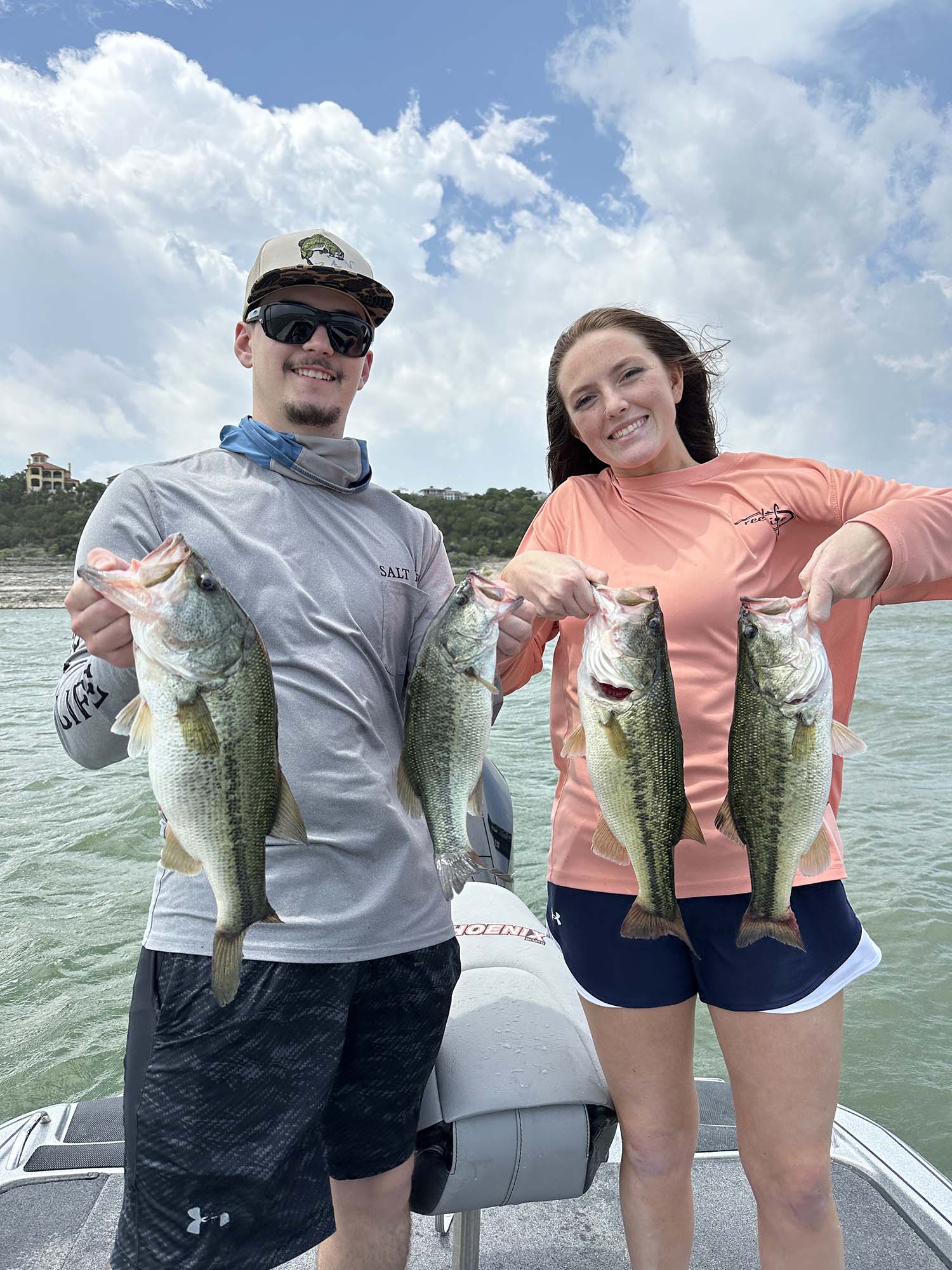
As June arrives that summertime heat is starting to set in causing the fishing patterns to begin to change. I have already noticed a big change in the fishing with more and more fish moving out deep. We’ve still been catching a lot of fish, but I’ve been doing more graphing with my sonar to locate them. My evening trips have been getting plenty of bites, but I definitely recommend the morning trips right now to beat the heat!
If you are headed out to the lake this month I recommend looking for areas with structure or cover deeper than 15 feet. You can still find some good fish up shallow in the mornings though. With the lake level coming up a little bit the past week there is a topwater bite around those newly flooded areas. The bass will move up shallow to hunt that new cover, but once it’s hot out you can count on them going deep.
Right now I recommend fishing deep rockpiles in the 15-30 foot depth range, or deep hydrilla flats in the 15-20 foot depth range. The lower end of Lake Travis has a lot of healthy hydrilla in it, and some of it is holding big schools of bass. I spend a lot of time graphing and moving around to find fish. During the warmer months bass tend to school up and aren’t just evenly spread out in the grass. My biggest piece of advice would be to cover water with a search bait.
Something fast moving like a swimbait, jerkbait, or spinnerbait can be good. If you have fished a spot for 15-20 minutes without a bite, keep moving, don’t waste anymore time there.Once you locate an area within the grass that is holding fish, fish it hard. Rotate between those moving baits, but then slow down and fish something through the grass where you can pick that area apart. A Texas Rig with a light pegged weight or weedless Dropshot is an excellent option. Not only will these rigs let you slowly slide the bait through the grass, but when rigged properly they are weedless and won’t snag easily.
With the clear water in Lake Travis I recommend natural colors such as Watermelon black seed, watermelon red, or green pumpkin. If throwing a moving bait like a swimbait something that resembles a Threadfin Shad is good. I.E. silver or white. My last piece of advice is once you locate an area you feel is holding fish, fish SLOW. When working a soft plastic such as a worm, fish it with long pauses and subtle movements with the rod tip. You’d be surprised how often you’ll get bit when the bait is just sitting there motionless. I see it all the time where one client is fishing really fast and moving their bait a ton, while the other is slowing down and fishing theirs very methodically… the one fishing slower always catches more. Think about it, those fish can be lethargic at times in that warmer water, give them a slow easy to catch meal.
Want to take the guesswork out of finding fishing? Would you like to learn the lake better so that you’re more consistent when you go out fishing on your own? Consider booking a guided fishing trip with Torwick’s Guiding Service. Not only will I work hard to put you on fish, but I love teaching people how to do it! I offer trips for anglers of all skill levels.
April 2024
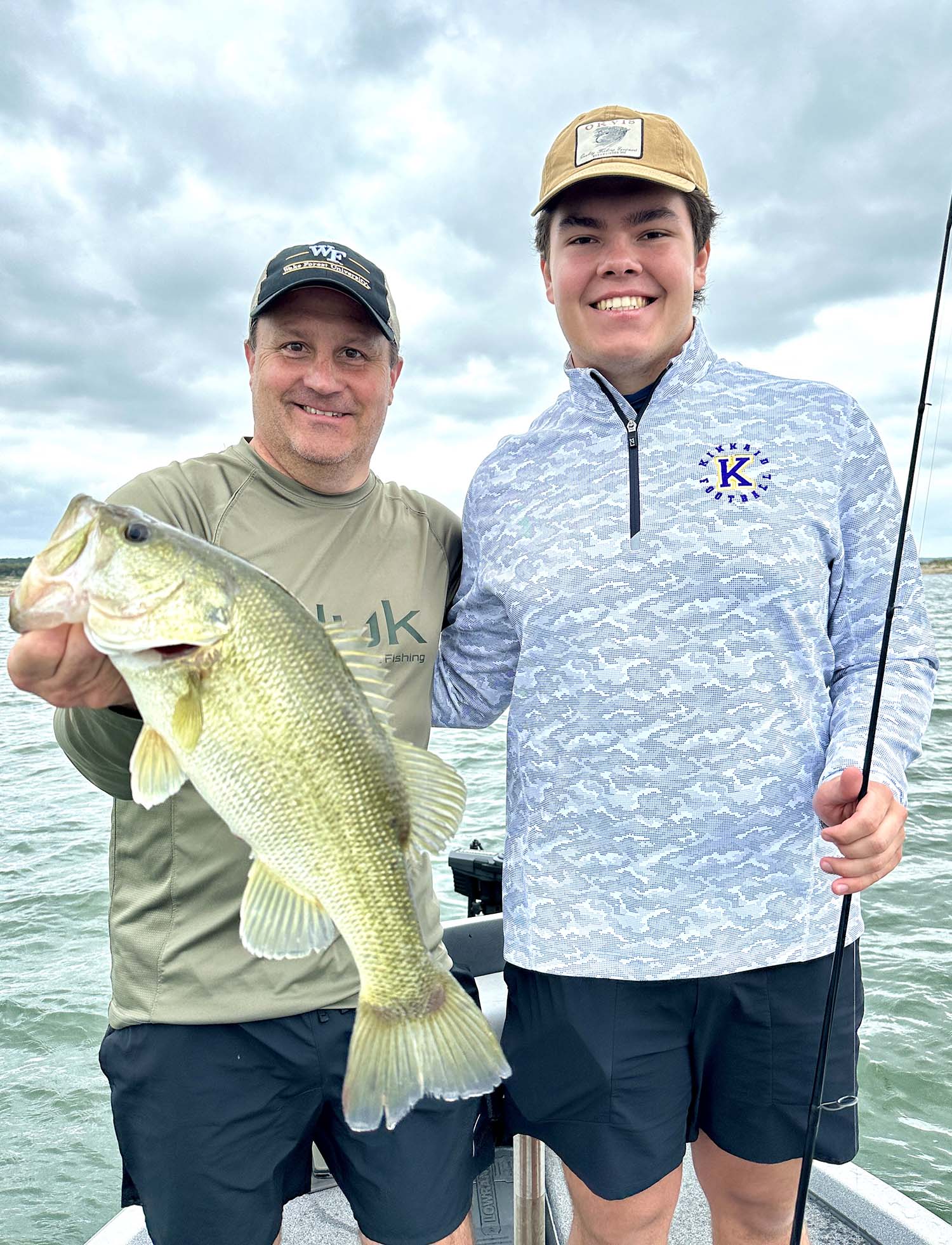
Fishing on Lake Travis has been excellent this past March, and I expect April to be just as good! Water clarity is quite good, 6-10 feet on the lower end of the lake, and 2-6 feet on the upper end of Lake Travis, water temps have been between 63-65 degrees lately depending on location and time of day. The past several weeks my trips have been averaging 20-40 fish per trip for half day trips, with some catching even more! During the spring months the fish move up more shallow and feed heavily on threadfin shad. The combination of the bass wanting to feed and their desire to move more shallow while the water is at those ideal 60-70 degree temps makes them easier to locate and catch. With that said, you can’t just go out to any part of the lake and toss around your favorite lures and get bit. No doubt you’ll catch a few, but there’s a big difference in fishing styles to catch a couple versus 20-40 bass in a trip. Let me give you a few tips on how to improve your catch rate…
First off, you could hire a guide like me! With my trips I will not only put you on a lot of fish but I will teach you how to do it. You’ll learn a lot more than reading an article online. With that shameless plug out of the way, there are a couple things you can look for when fishing on your own.
Location is key right now, you need to be around bait. Like I said, threadfin shad are the predominant forage for the largemouth right now. My clients and I have caught a ton of fish that have spit up shad while reeling them to the boat. Shallow flats with grass or cover such as stumps is key. Find areas adjacent to the main lake or the deeper parts of coves where the shad can move to to feed. The second and equally important part of the equation is paying close attention to the wind direction. Target areas getting hit by the wind. Small points and pockets will attract bass as they can use these areas to feed on the baitfish.
When there is a little wind you’ll do well throwing baits that mimic the shad. Small paddle tail swimbaits, crankbaits, spinnerbaits, jerkbaits, and flukes are all great options. Play around with this and rotate through these baits frequently until you feel like you’re on a pattern and know what they want. When I fish I always have multiple rods on my boat deck to rotate between as I fish. A 6th Sense 4” Whale in a shad color such as pro shad or clearwater rose are great options paired with a ¼ ounce leadhead. Work this bait on a slow steady retrieve trying to keep it as deep as possible close to the bottom or over the top of the grass. The deeper and closer to the bottom, without hitting the bottom, the better.
April is the month the shad start their spawn. Not only does this mean great fishing, but also explosive topwater bites. Topwater fishing is just about everyone’s favorite… I mean who doesn’t love seeing a big bass blow up on your bait on the surface! Hop on my website or give me a call to book your trip! Report brought to you by professional fishing guide Torwick’s Guiding Service.
March 2024
Spring is finally here and so is terrific fishing on Lake Travis! Historically March and April are about the best months of fishing here in Central Texas. As water temps warm up this time of year the fish start moving to spawning areas to build nests and lay eggs. Once they wrap this up they will feed up heavily as spawning takes a toll on them. If you’ve been thinking about booking a fishing trip with Torwick’s Guiding Service, now is the perfect time.
Currently water temps are in the low 60’s and will continue to slowly increase as the days get longer and the weather gets hotter. Water clarity on Travis varies a bit, you’ll see it as clear as 5-6 foot visibility on the lower end of the lake, and as dirty as 1-2 foot visibility on the far upper end of the lake. Currently Lake Travis is about 50 feet low, so pray for rain! If we don’t get any rain before summer I fear the lake will get severely low. Not good for the health of the lake, local businesses, or people that live around here!
As of writing this we’ve been catching a lot of fish, averaging 20+ fish a trip on most days. Weather definitely plays a factor in how the fish feed, those warmer afternoons tend to be really good as the fish start moving up shallower to feed.
There are two patterns I would recommend right now; pre-spawn and spawning fish.
Pre-spawn: When bass get on pre-spawn patterns you’ll do well targeting the areas around the mouths of spawning coves. Don’t go all the way back into the coves unless you see warm enough water temps. (60+ degrees) Small swimbaits, Texas rigged creature baits, crankbaits, and drop shots are all great options. I like to utilize moving baits like swimbaits and crankbaits as “search baits” to cover more water. Once I get some bites in an area or come across a piece of structure that looks good, i.e a dock, a point, brush, etc. I’ll slow down and work it over with plastics. As you’re fishing, if you’re not catching fish don’t be afraid to keep trying new baits and move around a lot. Something I tell clients is that 90% of the fish live in 10% of the lake. Fish quickly though that dead water, but once you find where they’re stacked up work it over really well.
Spawning: During spring when water temps get above 60 degrees Largemouth bass will move to shallow protected areas to spawn. The backs of coves, behind docks, shallow spawning flats, and behind marinas are all good areas to look. Think of places that are protected from the wind and boat traffic, these are ideal areas. Here are a couple of tips for you when targeting these fish.
• Polarized sunglasses: the polarization on sunglasses helps to cut the glare on the water and makes a HUGE difference in being able to see the fish. You’re looking for clean light colored spots on the bottom.
• Bring a cooler: Not for keeping fish! Rather for standing on top of. I’ve seen some guides building platforms to strap to the front of the boat. I don’t go to that extreme, but I do bring my big Yeti and put it up on the bow to stand on. That elevated position makes it so much easier to spot fish on beds.
• Bright colored baits: White, bubblegum, or Chartreuse colored baits make it easy to visually see when the fish bites your bait. When there is a ripple on the water or it’s overcast out it can be tough to see the fish eat your bait. Oftentimes I just watch my lure and when it disappears I set the hook.
• Swimbaits: A lot of guys use exclusively craw style baits to pitch onto beds. While this works great, sometimes the bass are finicky. Throwing a white colored swimbait that resembles a bluegill or sunfish can be the difference in getting them to hit the lure.
The link below is to an article I wrote a few years back. I put a TON of work and information into it, if you’re really wanting to dive into catching spawning fish give it a read.
https://www.torwicksguidingservice.com/single-post/bed-fishing-for-spawning-bass
Like I said, if you want to catch a lot of fish, have a chance at a big one, and learn a lot while doing it, NOW is the best time to book. Visit my website at https://www.torwicksguidingservice.com/ for more information, rates, availability, or to reserve your trip.
January 2024

The weather may be colder but that hasn’t slowed the fishing! My last several trips have actually been catching great numbers. I had an evening trip a few days ago catch exactly 30 bass during a half day trip! Currently water temps on Lake Travis are in the mid 50’s, if you read my reports often you’ll know I consider water temperature to be one of the most important factors in determining fish behavior. While the mid 50’s are too chilly for me to be swimming in the lake, they’re really not that cold by comparison to the rest of the country. While this will definitely affect the bass’ metabolism and behavior they still have to eat and changes in weather patterns can really get them fired up and feeding. Here are a couple tips on ways to get them to bite when it’s cold out.
Weather: During the winter months day to day weather patterns have a big affect on how the fish behave. If you have a flexible schedule and can time it right, I recommend getting out there on those cloudy overcast days, especially before some rain. The drop in barometric pressure can really help to get those fish fired up and active.
Time of day: Generally speaking early morning around sunrise is always good fishing. However, if it’s been really cold for several consecutive days a warming trend can get the fish to move shallow. Lately the evening bite has been really good, once the sun comes out and warms the surface temps the fish move up on shallow cover to feed. Looking for shallow rock can also be a good way to locate fish. Rock acts as a heatsink and will attract the fish as the water near it can be slightly warmer. Keep in mind it may only be a half a degree temperature difference, but for a fish that can’t escape its environment, that half a degree can be enticing. This is something to pay attention to on colder days when the weather breaks and the sun comes out.
Reaction Baits: When it comes to getting a bass to bite often you are either trying to trick them into biting something realistic looking that mimics something they would naturally feed on. Other times, especially when it’s cold, you are trying to throw something that’s fast moving, flashy, or bright colored that the fish will instinctively react to… we call this a reaction bite.
Baits like jerkbaits, blade baits, crankbaits, and Alabama Rigs can all be excellent choices. Oftentimes I am trying to mimic a threadfin shad while still fishing something that vibrates and is flashy. During the winter months crawfish can also be a part of the bass diet, so crankbaits in orange, red, and brown are excellent options. When guiding I typically will have a mix of these baits on the deck and make clients change between lures as we fish. Part of it is patterning fish, and part of it is just giving the fish something different to look at. There are a lot of times I can see the fish on the sonar but it takes a couple lure changes and tweaks to the presentation to get them to bite. My advice to you is to keep several baits tied on and don’t be afraid to switch lures often, don’t get stuck in a rut throwing the same bait over and over!
The fishing has been really fun lately! If you’re looking to get out on the water visit my website at www.torwicksguidingservice.com or give me a call to book a trip!
December 2023
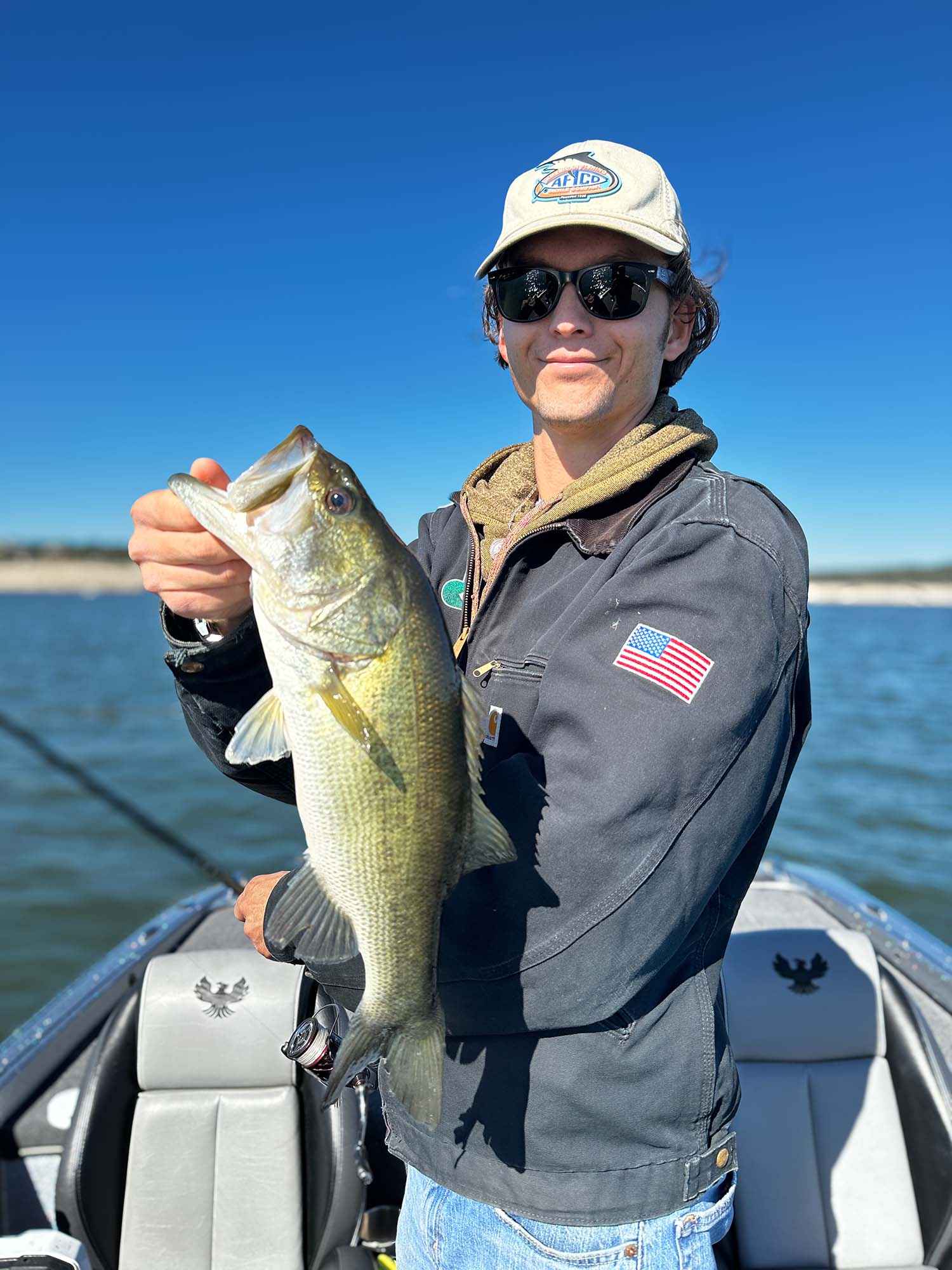
December in Central Texas tends to be pretty mild compared to the rest of the country. While other states are winterizing their boats and packing away their bass fishing gear, we still have great fishing conditions. Currently water temps are in the mid 60’s and will continue to slowly drop throughout the month, water clarity varies quite a bit right now. I have seen water clarity as good as 6-8 feet down near the dam, and as low as 1 foot on the upper end of the lake. Winter fishing can actually be really good, but day to day weather conditions affect the bite greatly.
I always tell clients the best day to go fishing is any day you can get off work! With that said, if you can time it to be out there during overcast conditions, light wind, and not right after a front, you’re going to catch fish! Even on those bluebird sky days you can get bit though, you just have to slow down with your presentation more, or fish more reaction baits.
Headed into December there are three main baits I recommend you have tied on.
1. Drop Shot: No Lake Travis fishing report would be complete without this rig. I love it for its versatility, you can fish it year round simply by changing the way you present the worm. I recommend going with a 6” straight tail worm, green pumpkin or red colored trick worms have been working well lately. When fishing it, be patient and give it lots of time to sink making sure you maintain bottom contact. When presenting the worm, twitch your rod tip more subtle than you normally would. Less is more in terms of the action you give your bait. If you work your lure too fast and erratic its less natural and will get less bites. Fishing this bait around grass on the lower end of the lake, or rocky bluff walls on the upper end of the lake will produce fish.
2. Jerkbait: as the water gets colder a deep diving jerkbait can be very effective. The 6th Sense Provoke 106DD is a great option. Lake Travis is a deep lake so going with this deeper diving model works well to get you down closer to the structure the fish are relating to. While they make a lot of great colors, stick to something very natural that mimics a threadfin shad. Fish this with an erratic retrieve followed by long pauses. A good rule of thumb is the colder the water temps the longer you should pause the bait. Tip: When pausing the bait do so on slack line, if you keep the bait under tension the whole time you prevent it from stalling out and suspending properly.
3. Senko: This work is very versatile so depending on the cover you can fishing it a variety of ways. The main ways I have been catching fish on this stick worm is either neko rigging it and fishing it slowly over the top of shallow grass, or with a pegged Texas rig and sliding it through deeper grass. Especially on those high barometric pressure days those fish will get tight to cover. In water shallower than 10 feet the wacky rig/ neko rig is killer. Fish it slow and let it just settle into the top of the hydrilla. In deeper water I recommend a bobber stopper, a small 1/8th ounce tungsten bullet weight and a 4/0 hook. For the senko you can’t beat a Yamamoto 5” senko, green pumpkin, watermelon red and plum are all good colors. With this rig you also want to fish it slow with small shakes of the rod tip, then let it sink on slack line and dead stick it for several seconds. You’ll find a lot of your bites come on the pause. Tip: I often will use some orange or red Spike It dye on the tail of the worm trying to mimic the color of crawfish this time of year.
Use these baits and focus on structure and grass that’s close to creek channels or deep water on the main lake. More bass will pull out deeper in search of stable water temps as the weather gets colder. More often than not a slower presentation will work best. When you think you are fishing slow enough… fish slower!
Fishing during December can be tough for some. If you struggle to catch fish consistently, consider booking one of my Coaching Trips. There is more information about these on my website, but essentially these trips are all about education and teaching you to locate and catch more fish more consistently. If you’re just looking to catch a bunch of fish and have a fun time, give me a call or visit my website to book your trip today!
November 2023

November is always a great month for fishing here in Central Texas, especially right here in Lake Travis. While the boat ramp situation is still problematic the recent rains are bringing the lake level up. There are some private boat ramps open and I’m optimistic Pace Bend’s Tournament Point ramp may reopen. Fall brings cooler temps which as y’all know is key to getting those fish more active. My recent trips have not only been catching good numbers, but also good size. I’ve had quite a few bass up to 5 lbs in the net!
If you are heading out there, there are two main patterns I would recommend you fish.
Topwater: Currently the topwater bite is on fire. If you can time it to be out on the lake when there is some wind and overcast conditions those fish will get up shallow to feed. Poppers and spooks in shad patterns have been the ticket. You want to be targeting areas where the wind is hitting and where there is structure in the water. Whether it’s grass or rock there needs to be something for those bass to hide around while they wait to ambush prey. Visually looking in the water for rocks, anchor blocks, stumps, or ledges is helpful in deciding where to cast.
During early fall the fish feed heavily on shad, so stick with those shad imitation patterns. Later in the fall the bass will start feeding more heavily on crawfish. We aren’t quite there yet, colors like bone, chrome, and sexy shad are all good options. When working your bait make sure you are incorporating a lot of pauses into your retrieve. During my last several trips it has been very obvious the fish want the bait presented with a lot of stops and starts.
Crankbaits: On some days depending on the conditions the fish don’t always seem to want to come to the surface to bite. That’s when I recommend a squarebill or medium diving crank. Select the bait most appropriate to the depth you are fishing. I typically will have multiple crankbait rods on the deck of my boat in order to alternate between them as I move down the bank. A 6th Sense Crush 50X and a 6th Sense Flat 75X have been two of my go to baits recently.
As far as color I change this up a lot. I mostly stick to shad patterns but with the recent rain and cloudy days sometimes a pattern with a lot of chartreuse in it works well. That rain and runoff causes the water to get a little muddy and that bright yellow stands out. Fish these baits with an erratic retrieve with lots of stops and starts. You are trying to trigger those reaction bites!
With the cooler temps and the lack of boat traffic on Travis, the fishing has been very enjoyable and relaxing. If you would like to learn more about catching them on your own or just want to be put on the fish consider booking a trip with me! I’ve been guiding full time on Lake Travis for 6+ years and would love to get you out on the water!
September 2023
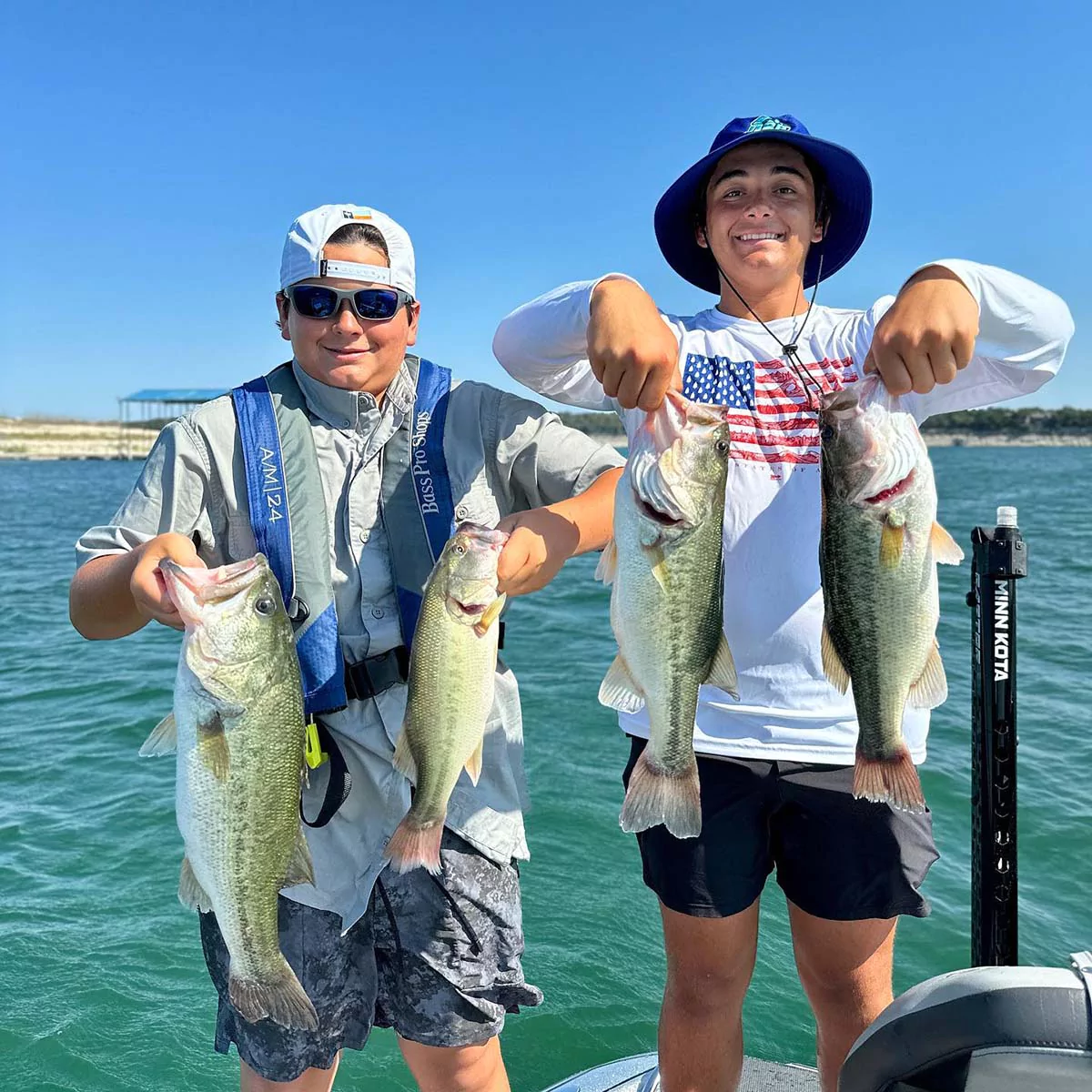
September is always a good month around here as it’s our first chance of some cold fronts and cooler weather! While this is Texas and the temps are going to stay hot for a while, a transition in the fishing is going to start happening later this month.
September is when we get in the early stages of what anglers refer to as the “fall transition”. This is the time of year when the water temps start dropping from their summertime highs and some fish start moving up more shallow. One thing I always remind clients is that not every fish in the lake bee lines it for the bank. Fishing deep will still be productive and a consistent way to catch bass on those days when its bluebird skies with little wind. Our weather in Central Texas has a tendency to stay hot for a while longer, so the true “fall fishing” bite is a few weeks out. Let me break down the bite I have been on in two ways, fishing shallow and fishing deep.
Fishing Shallow
Early in the mornings and late in the evenings there has been a good topwater bite. A chrome or bone colored pop-r and a whopper plopper in a shad color has been consistently getting bit. One key to the topwater bite is finding the right kinds of banks. Avoid bluff walls and steep banks, you will have more consistent success on the more gradual sloping banks. The big difference between a productive bank, and one that will only produce a few bites is structure. Bass are ambush predators and want to be around cover. Look for more gradual banks that have rock, stumps, brush, or grass on them… the more of these things the better. Banks with just sand or gravel don’t tend to hold as many fish.
Weather plays a big part of how fish behave and what baits will work better to catch them. Once the sun has come out and it starts to warm up the bass tend to back off the bank and move a little deeper. Get out there early and take advantage of that morning bite if you want to fish shallow. I alternate between a squarebill and a medium diving crankbait. I switch between them depending on the depth of the bank I am fishing. Depending on which end of the lake you are fishing you’ll either be fishing around hydrilla or just rock. If you are fishing rock get that bait down to the bottom and get it to bang into things. If you are fishing around grass get that bait to just tick the top of the grass and rip it free whenever the hooks get fouled up. Stick to shad pattern baits until the water temps get down into the 70’s, then start throwing some crawfish colors.
Fishing Deep
As I mentioned early in this report, there are still plenty of fish living out deep. I have caught fish from 10 feet all the way down to 35 feet. With that said, focusing on the 10-20 foot depth range has been the most productive. Areas of structure such as rock piles, small ledges, or grass not far from the shallow areas I described early, will hold fish. A Texas Rig has been working great lately. A green pumpkin 6th Sense Hogwalla is an excellent choice right now. One tip though, if you are fishing on the upper end of the lake where the water is a bit more stained, consider adding some chartreuse dye to the tail of your bait. I find that little bit of color makes it stand out and get a few more bites. Whatever bait you are throwing, slow way down with it and keep it in contact with the bottom. Until the water temps drop a considerable amount, a slow presentation with your soft plastics will work best.
Coves with creek channel bends, or banks with rocky veins and drop offs will be a good place to start your search for bass. While it’s still early in the fall, spend most of your time at the mouth of the coves all the way to about half way back. Until it gets a lot cooler I will not bother fishing any further back than half way into the coves. Finesse jigs, shakey heads and drop shots are also baits I will have tied on this time of year, especially on those days the fish are being a bit finicky and want something small and slow moving presented to them.
The fishing is good now, but the best fishing of the year is still ahead of us! As soon as a couple cold fronts roll through and you see the water temps drop several more degrees the fish will get moving! Fall fishing is a blast, the numbers of fish as well as the size we catch always goes up. Fall is the second busiest season for me right after Spring. Don’t hesitate to book early, especially if you want a weekend date!
If you have a boat of your own and fish Lake Travis, consider checking out my Honey Hole Reports. These are paid reports that I update every Thursday at 6PM and include 5+ EXACT locations on the lake where I am catching fish with my clients. These reports give you all the info on what baits I’m throwing, colors to use, conditions to look for etc.
July 2023
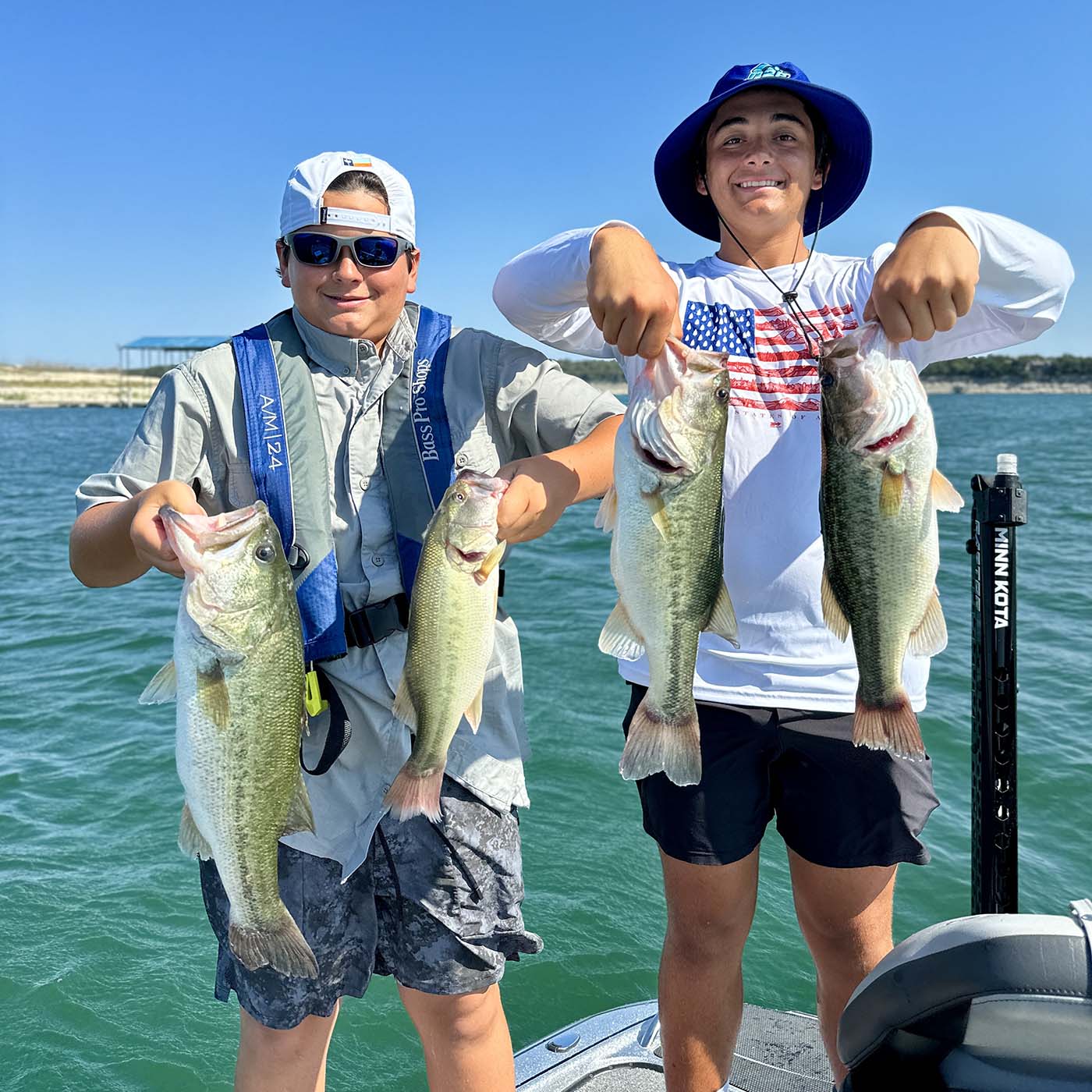
Summertime gets a bad reputation for being tough fishing. I will admit, the fish can be a bit more finicky and tougher to find, but you can still have some really good days on the water. Currently water temps in Lake Travis are in the mid to high 80’s depending on time of day. The water clarity is very good, 10+ feet in some areas depending on where you are in the lake. If you are reading this to help plan out your fishing trip my advice would be to get on the water as early as possible, I’m talking right at first light. If your schedule allows I would recommend going during the week. Summer brings out the party crowd so Saturdays and Sunday after about 11AM can be pretty busy on the lake.
Right now there are two main patterns I would recommend: deep grass and marinas.
Deep Grass Fishing
Warm water holds less dissolved oxygen than cold water, this is one reason that bass favor deeper water during July. The deeper they go the cooler the water, unless a thermocline is present the fish in Lake Travis will go very deep sometimes. One thing that will change this behavior is the presence of healthy grass in the lake, in the case of Lake Travis that would be hydrilla. Just like any other plant, Hydrilla undergoes photosynthesis during the day which produces oxygen. Areas with grass will hold more dissolved oxygen, attract more baitfish, and provide good habitat for the bass. Since grass needs sunlight for photosynthesis this is why you will not find it growing way out in the middle of the lake. The deeper you go the less light penetration, obviously this will depend on the water clarity of where you’re at, but generally speaking 18-20 feet is about as deep as I find the grass growing.
I recommend getting out there with your side imaging and 2D sonar and scout for the grass. Look for large isolated patches of grass, grass edges, and points the grass form on its own. Target these areas with slow moving soft plastics. Weedless drop shots, neko rigs, and light Texas rigs can all be great options of baits to throw. With the clear water I recommend going with natural colors such as watermelon or green pumpkin base colors.
Marina Fishing
Another pattern that works well during July is fishing around deep water marinas. Some marinas on the lake attract large schools of bass. They will get up around the docks and boats, oftentimes sitting under the docks suspending. Casting baits along side the marina breakwalls and pitching baits into the empty slips can produce some big bites. This style of fishing is a bit more advance in that it requires some very accurate casting.
The use of live sonar is extremely helpful for this kind of fishing. I can usually tell within half a dozen casts whether or not a dock is holding fish. You may not get bit right away everytime, but most of the time a few bass, if not a whole school will come out from under the dock to inspect your bait if they are there. There is no shortage of marinas on Lake Travis, I recommend running and gunning and keep moving if you don’t get bit within 10 minutes of fishing the dock.
Small swimbaits, jigging spoons, drop shot rigged flukes, and flutter spoons can all be good baits for this kind of dock fishing. In addition to the bass, the shade of the marinas also attracts threadfin shad, you want to be selecting lures and colors that mimic these baitfish.
If you want to take all the guesswork out of locating fish and figuring out what bait to throw, consider purchasing one of my Honey Hole Reports. I offer a paid fishing report that is updated weekly on Thursdays at 6:00PM. I am an open book and include the EXACT spots I am catching fish with clients, the baits I am throwing, the colors I am using, and lots of other helpful information. For the price of a couple crankbaits you can save yourself a ton of time looking for fish and learn more about what works well on Lake Travis!
If you are interested in a guided fishing trip give me a call or visit my website! In addition to my normal guided trips I offer Coaching Trips, these trips are all about education and teaching you to be a better angler. We’ll cover things like locating fish, understanding seasonal patterns, how to understand what baits and lures to throw, what colors to throw and why, how to better understand your graphs, and soooooo much more!
June 2023
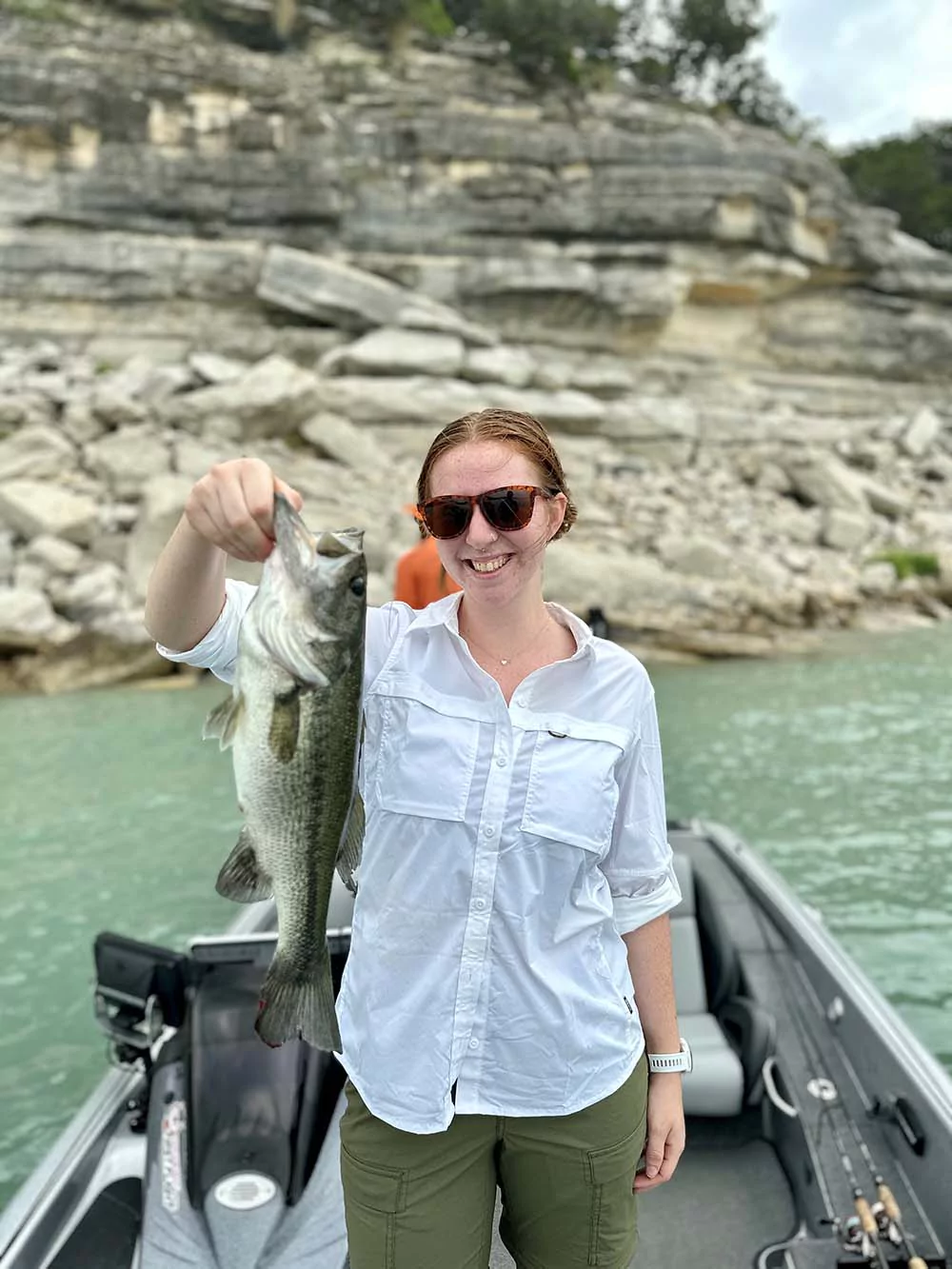
The fishing has continued to be good! With that recent rain the lake came up a little bit. Not enough to really make a high difference, but I’ll take every drop we can get. The increased lake level has also made some of the hydrilla on the bottom of the lake set up really well with the depth it’s growing at. As of late the main patterns I have been focusing on are fishing grass on the lower end of the lake, rock piles on the upper end of the lake, and schooling fish in the morning.
When it comes to fishing the grass you want to select baits that will either stay just over the top of the hydrilla or baits that are weedless and go through it easily. Small swimbaits or crankbaits can be really good when fished just over the hydrilla, but occasionally allowing it to bump the top of that grass. Stick with natural colors that mimic threadfin shad. Plastics rigged on weedless drop shots or Carolina Rigs have also been really good. A tip with the Carolina Rig, normally I run them with a heavy sliding sinker to get them to the bottom quickly. When fishing grass I recommend using a ½ ounce tungsten bullet weight or lighter in order to let the rig slide through the grass easier. Baits like speed craws, the 6th Sense Hogwalla, or their new Boosa worm have been working really well. Stick to natural colors like watermelon or green pumpkin when fishing the clearwater on the lower end of the lake.
With the water temps getting into the upper 70’s and soon into the 80’s some fish have moved out deep. Targeting rocky ledges and rock piles on the upper end of the lake has been very productive. Texas Rigs, Jigs, and Ned Rigs are all baits that will work well. It’s all about bottom contact when fishing rock, so make sure the bait you rig up will stay down on the bottom. A football jig is one of my personal favorites. I recommend a ½ ounce football jig in light brown with some orange accents, a Zoom Speed craw, 6th Sense Stroker Craw, or a Strike King Rage Craw are all excellent trailer options. Green pumpkin is a good all around color to match with a brown football jig. Bass in Lake Travis feed heavily on Crawfish, which is exactly what you are trying to mimic with that football jig. I recommend targeting areas 15-25 feet deep right now, especially places adjacent to deeper water, but not far from shallow structure where the bass can pull up to if they want to feed shallow.
The schooling bite has been getting better everyday! The shad spawn is still going on, although the bulk of it was a few weeks ago. Fun fact about shad, they will actually spawn multiple times throughout the spring and summer. I see anglers online always talk about the shad spawn being over by now. However, it’s not over, it’s just that the shad in the location you saw them spawning for a little while have finished and moved on. There’s other shad spawning on a different part of the lake that you haven’t found yet. With that said, once the water gets into the 80’s they will stop. With the abundance of shad up shallow the bass are schooling up chasing them. Around some deep water marinas, but also out in the main lake in certain spots the bass will chase the bait in the mornings. I rely heavily on my live sonar for this fishing, but when they push the bait to the surface you will see them splash which gives away their location. If you are quick with a cast you can catch them with ease. However, if you are slow to cast to the bass, they usually go back down deep once they have caught the shad they were chasing.
A topwater spook such as a 6th Sense Dogma, a 4” paddle tail swimbait, or a jerkbait are all good baits I have been catching fish on right now. Super realistic colors to look like the shad they are feeding on are all good options. When the bass are hitting the surface, throw that topwater bait. Once I see them moving around in schools on the live sonar I prefer the jerkbait or swimbait. Little tip on schooling fish: When you find a school of bass with your livescope they are almost always on the move. I recommend watching them with your sonar for a second and figure out which direction they are heading. You want to lead the school with your cast, that way by the time the bait hits the water and sinks to the depth they are at, it’s not behind the school. Practice this and you’ll drastically increase how many fish you catch.
If you are looking to get out on the water and want to guarantee your success, consider booking a guided fishing trip! In addition to my normal guided trips where we try to catch as many bass as we can, I also offer what I call “Coaching Trips”. These trips are geared more towards education and less about running my honey holes. I will teach you to be more successful when you are on the water by yourself!
https://www.torwicksguidingservice.com/honeyholes
Speaking of Honey Holes, did you know I sell my fishing spots! I offer a weekly paid fishing report, updated every Thursday at 6pm with my EXACT fishing spots for that week. Each Honey Hole Report contains 5 spots with information on the exact baits, colors, etc that I am catching fish on with my clients during guided trips.
Good luck and I hope to see you out there on the water!
May 2023

The fishing on Lake Travis has been exceptional the last few weeks! If you read my reports you know Spring is my favorite time of year. March and April are when the bass spawn, but May is very fun as that is when the Shad spawn. Water clarity is very good right now, 4-8 feet depending on where on the lake you’re at. Water temps have been climbing and are up in the 70’s
A lot of the baits I am throwing right now revolve around the shad spawn. When they are spawning the schools of baitfish move up shallow to lay their eggs early in the morning. They spawn on shallow gravel banks, on dock floats, and around marinas. There have been several mornings recently that you can watch the shad up in the docks swimming around. Oftentimes you can see the bass nearby ready to eat them!
I break down fishing right now in two ways, early morning and the rest of the day. As I mentioned before, early in the morning is when the shad spawn happens, so I recommend taking advantage of this by throwing moving baits to mimic those shad. Looks for shallow sloping gravel banks, especially where the wind is hitting. Fish eating birds like Blue Herons and Egrets are also a good indicator of the shad. On glass calm days you can often see the shad on the surface, other times I use my sonar to look for schools of shad in the general area. If there are large schools of shad around, it’s likely there are some up shallow spawning.
Once you have found an area with bait I recommend tying on several lures and rotating between them frequently. A couple I recommend are a white and chartreuse spinnerbait, a 3-4 inch paddle tail swimbait, a jerkbait and a topwater lure. Lately the sub surface baits have been producing a lot of fish, the topwater bite has been slow, but I get a lot of clients who still want to commit to fishing it for that exciting blow up on the surface.
A 6th Sense 106 Provoke in a realistic shad pattern and a 6th Sense 3.5 Whale in a shad pattern have been my go to lures for guiding. There are a lot of other baits that look like a bait fish you can try, but those two are proven fish catchers. With both these baits fish them slow enough to get below the surface, but fast enough to stay over the top of the rock or grass, depending on where you are fishing. Coves off of the main lake have been great places, I wouldn’t bother fishing way in the backs of the coves for the shad spawn bite.
Once the sun comes out and it warms up the shad spawn stops, this is when the fish move out a little deeper and get on cover. I have been catching fish in 10-20 feet of water later in the day. You want to look for structure where they can move to to position themselves to ambush prey. This is still the spring time so those fish are still looking to feed! Grass edges, secondary points, and ledges have all been good places. For this type of fishing I put away the jerkbaits and topwater plugs and pull out some soft plastics. The two rigs I recommend the most are a weedless dropshot and a Carolina Rig.
For the drop shot I recommend a cylinder weight as it goes through the grass and rock the best. When fishing around the hydrilla I recommend a 1/0 EWG hook in order to rig your worms weedless. A straight tail worm such as a Roboworm or a Trick worm are excellent options. Fish this rig slowly through the grass, the key is to not overwork your bait and fish it too aggressively.
For the Carolina Rig I recommend a ½ ounce tungsten bullet weight, I find this weight works a lot better than an egg sinker when you are fishing it around grass. Go with a 3 foot leader and a 3/0 EWG hook. Craw style baits like a 6th Sense Stroker craw have been really good. Stick with natural craw colors for that bait. I like Carolina rigs a lot as you can fish them relatively slow, yet still cover a lot of water. When fishing this make sure to give it the occasional long pause in order to make sure you are staying in contact with the bottom.
My Honey Hole Reports go into much greater detail about these rigs including the exact colors that have been working the best. Generally speaking natural colors work best on Lake Travis due to the clear water. With that said, there have been a few particular colors lately that are working best.
https://www.torwicksguidingservice.com/honeyholes
The fishing is really good right now, so I highly recommend getting out there! The weekends have gotten really busy, especially at Mansfield Dam Park. However, most weekdays I have the lake to myself aside from a couple other bass boats and a few dock company boats. I have quite a few openings right now if you’re looking to book a trip! I usually get a small lull between the spring frenzy of bookings and the end of school for kids when everyone is on vacation. Now’s a great time to book! For anglers with more fishing experience, consider looking into one of my Coaching Trips. These trips are all about education and are designed to teach you as much as possible about fishing Lake Travis.
April 2023

The fishing on Lake Travis has been exceptional the past month! I’ve had some trips catch in excess of 60 fish in one outing. During this time of year the bass pull up shallow to feed and spawn, making them more aggressive and easier to target. Additionally the White Bass are moving up to spawn, and with the low lake levels I have found them spawning in unusual places. While not the species I normally guide for, I love catching them as they’re hard fighters and are great for clients who want to keep their catch.
April is one of my favorite months to guide because here in Central Texas that is when the Shad spawn. Threadfin Shad are one of the main food sources for largemouth bass. These small silver bait fish are plentiful in Lake Travis and are like candy to hungry bass. During April when the water warms to the right temperature the shad move up shallow on gravel banks and around docks to lay their eggs. They do this during the early hours of the mornings, so getting on the water early is your best bet for success. When they move up to spawn they are very vulnerable and easier for the bass to prey upon.
I recommend looking for shallow sloping gravel banks where the wind is blowing into. Avoid the steep bluff walls or banks with large rock. The other place I find shad spawning is up in the marinas and docks as they lay their eggs in the algae that grows on the dock floats. A quick tip is to look for Blue Herons and Egrets, these birds feed on the shad and are a dead giveaway to the presence of bait fish. It is not uncommon to see two or three of these birds sitting statuesque at the water’s edge waiting for a shad to swim close by where they can catch it. I look for these birds to help me quickly find shorelines the shad are spawning on.
When it comes to baits to use there are a lot of options but I will give you my top three. The main thing to keep in mind is you are trying to mimic a Threadfin Shad, so select baits that look like them.
1. Topwater Baits: a chrome pop-r or bone colored spook are great topwater options that will allow you to cover a lot of water. With the pop-r I like to work it about 2-3 feet giving it small little pops of the rod tip to make it spit water, then pause it briefly before continuing. For the topwater spook I work this a little faster giving it a “walk the dog” action while pausing it every 5-6 feet.
2. Swimbait: A 3 or 4 inch paddle tail swimbait in a silver or white color is another excellent option. Keitech, Megabass, and 6th Sense all make a great option. Pair this up with a ¼ ounce lead head and fish it slowly just over the bottom. Little twitches of the rod tip every once and a while can also help to trigger bites from followers.
3. Flukes: A Zoom fluke in a shad color rigged weightless or on a Owner twist lock hook with a small belly weight can be deadly fished up shallow. I like to fish this bait with the same cadence I do a jerkbait, when the bait gets out further from shore where it is deeper I like to give it a long pause to let it get closer to the bottom. Tip: a “Donkey Rig” is a rig with two separate flukes on it, this is a fun way to fish this bait and make it look like a small school of bait fish. Sometimes you catch two fish at once with it!
The fishing will stay really good for a while longer! Until the water gets really hot and summer gets here you can expect to have good fishing up shallow. Once summer gets here and the water warms more fish will start to move out of the coves and out of the shallows to deeper cooler water. Until then tie on the baits mentioned above and go catch some bass!
Consider booking a trip with me! Torwick’s Guiding Service is fully licensed and insured and offers only the highest quality equipment and a brand new Phoenix boat to fish from! In addition to my normal guided trips I also offer what I call “Coaching Trip” geared solely towards teaching you how to become a better angler. For more information about my Coaching Trips please visit my website. www.torwicksguidingservice.com
Have a boat of your own? I also sell a weekly Honey Hole Report on my website! Each report contains 5+ EXACT spots on Lake Travis where I have been catching fish with my clients. In addition to the location we’re catching them I also tell you the exact baits, colors, and techniques I’m using.
March 2023
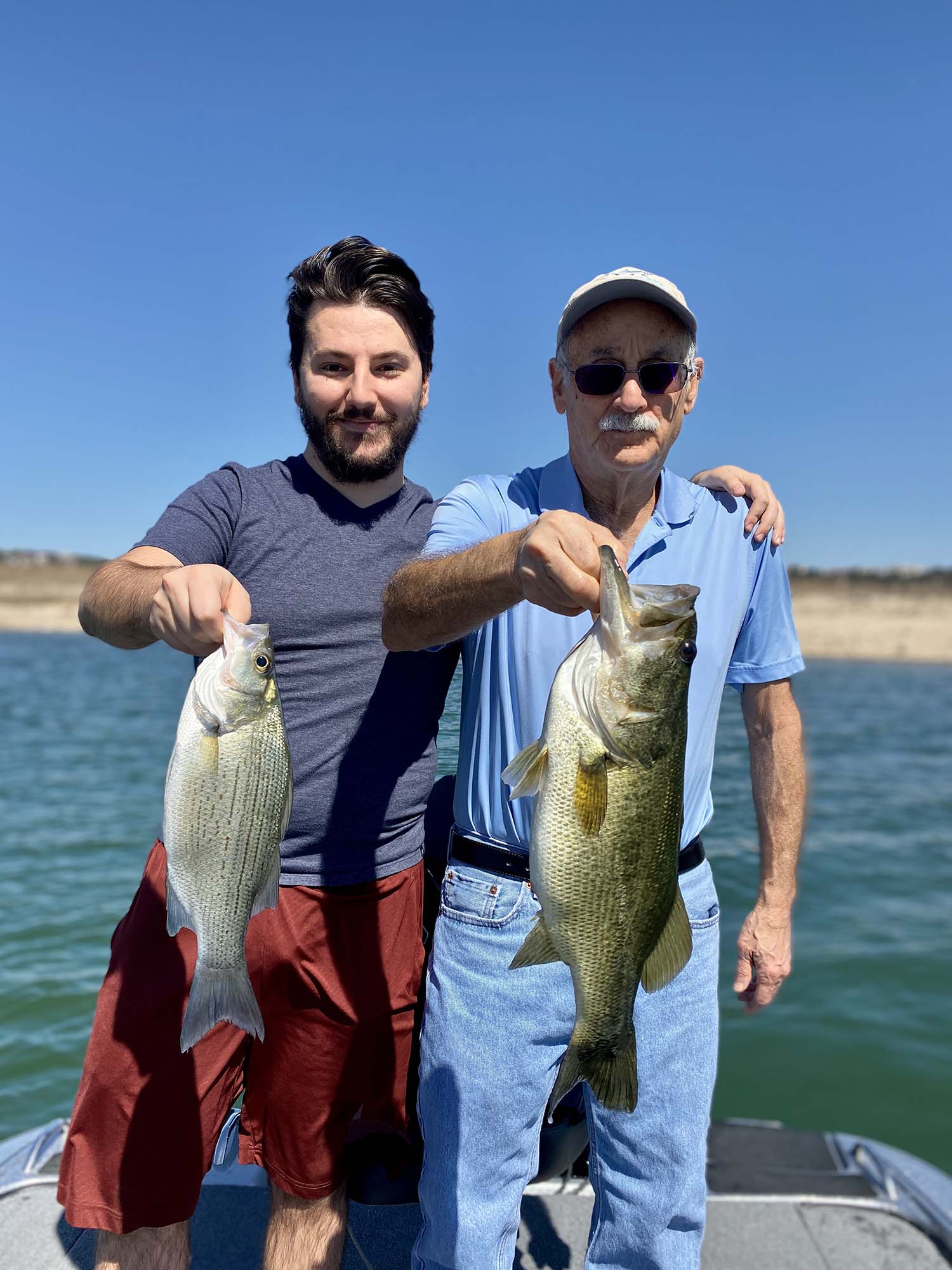
Spring is here and the fishing on Lake Travis has been fantastic. Water temps are currently in the low 60’s with water clarity around 4-6 feet on the lower end of the lake. The further up river you go the more stained the water gets.
Right now the bulk of the largemouth bass are in their pre-spawn pattern. With that said everyday more and more fish are pulling up into their spawning areas to make nests and spawn. Targeting spawning coves can be a very fun and productive way to fish. I recommend looking for coves and flats that are out of the wind and away from boat traffic. Bass like to spawn in shallow areas where they will not be disturbed. Look for small white circles on the bottom of the lake bed, this is where the male bass has cleaned away the sediment to make a suitable place for a female to lay their eggs. Creature baits rigged on a Texas rig are a great way to trick them into biting! I recommend a bright color such as white since it is easier to visually see when the bass has taken the bait. Be quick on that hook set!
While bed fishing is fun, targeting pre-spawn fish has produced better numbers for my clients in my recent trips. With bed fishing you may spend 30+ minutes looking for a nest and trying to get the fish to bite. Instead, we have been targeting grass edges and shallow sloping rocky banks close to spawning areas. These are the places fish will pull up to in order to stage before making a move to spawn. Small medium diving crankbaits, paddle tail swimbaits, and jerkbaits have all been very productive. When fishing around the grass you want to select a bait that will dive to the proper depth. Using my sonar I am able to see how far from the surface the Hydrilla is growing, and select baits that will get down to it, without going so deep as to get snagged. Largemouth love living down in the grass and will position themselves on holes or edges in the grass in order to come up from below and ambush their prey. I recommend sticking to natural colored baits that resemble a threadfin shad due to the clear water in Lake Travis. However, on overcast days or very early in the morning something with some chartreuse in it has been very good. When fishing with any of these baits make sure to keep your retrieve very erratic, lots of stops and starts and changes to the speed of your retrieve will help to elicit reaction bites from the bass.
March usually kicks off the “good fishing” for the year. But honestly my favorite fishing comes in April when the shad spawn. Between now and the heat of summer the fishing will only continue to get better! The average number of fish caught per trip has been exceptional lately. Also, we have been getting into a lot of White Bass. While not our target species they’re a blast to catch! They fight hard and are great table fare if you’re looking to take some home. If you haven’t gotten out on the lake, now is your time! If you don’t have a boat, or would like to learn more about Lake Travis consider booking a trip with me!
In other news, there’s been some big changes at Torwick’s Guiding Service! New for this season I am running a 2022 Phoenix 921 elite with a Mercury 300 on the back! My boat is rigged with five graphs from all the major brands and is equipped with 360 degree imaging, live sonar, and every other bell and whistle imaginable. I promise you will not find a guide in Austin with a better boat! Now is a great time to book a trip!
January 2023
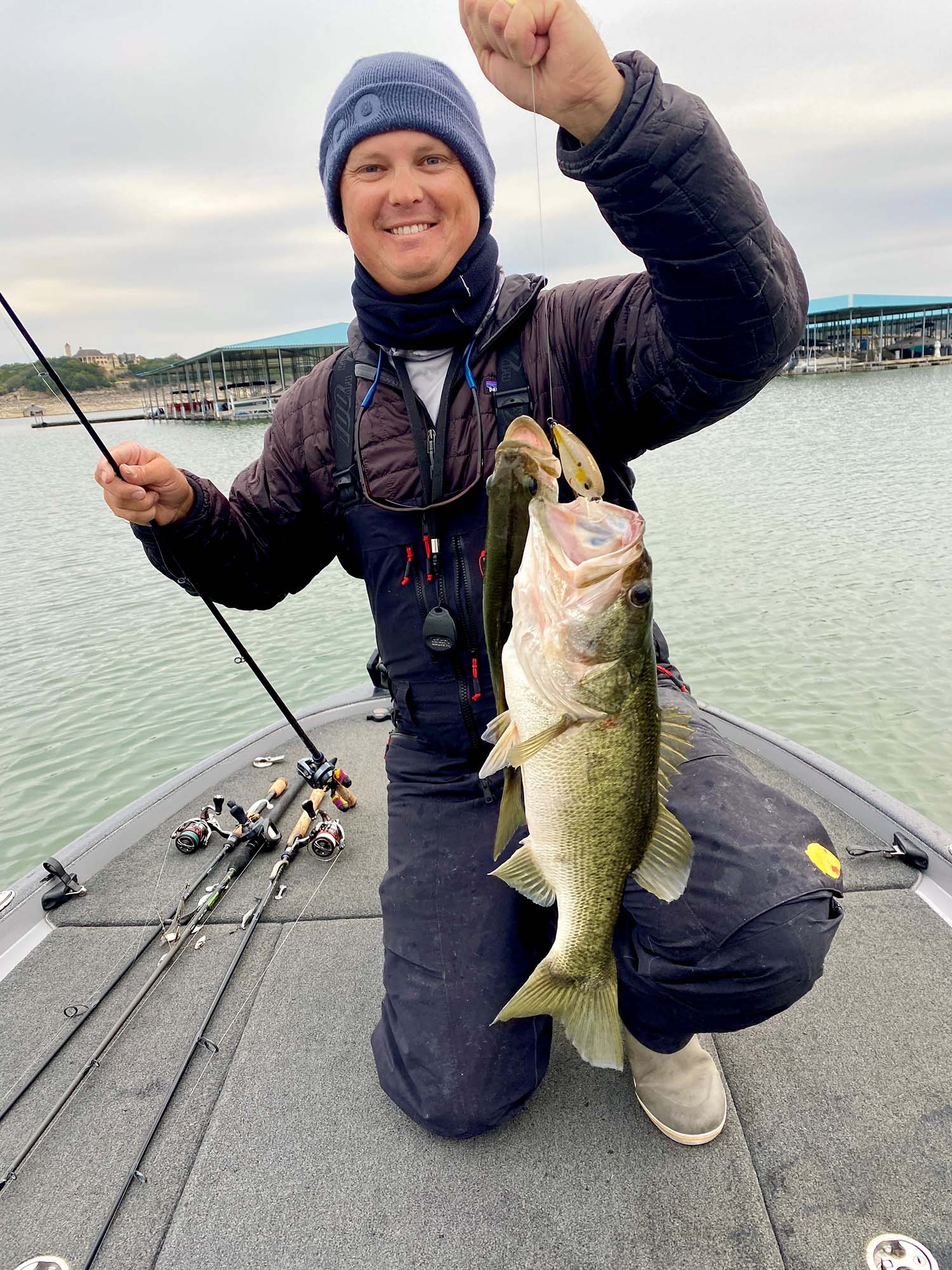
January in Central Texas can actually bring some very good fishing! I think it’s a common misconception that the fishing is bad in the winter just because it’s colder. Currently water clarity on Lake Travis is around 4-5 feet depending on the part of the lake you’re on. The water temperature on Lake Travis is in the high 50’s to low 60’s, so pretty warm compared to the rest of the country this time of year! Lately the weather has been all over the place with cold fronts and stretches of warm weather. With the swings in water temps come different patterns the fish get on.
What I find to be most important in the winter is timing when you fish based on the weather forecast. Pick your days wisely and you can do very well out there on the water. Days prior to cold front or storms can have very good fishing. Recently I’ve had several half day trips with 20+ fish. However, if you are fishing the day after a front moves through and are facing blue bird skies and north winds, the bite can be pretty slow no matter how skilled of an angler you are.
Right now there are two patterns I recommend you try. One fishing fast moving reaction baits and another fishing slow moving finesse baits.
Everyday I’m on the water I am refining the patterns that are working to put fish in the boat. Even from day to day what the bass want to bite can change. I personally like starting with moving baits in order to cover more water, plus I find it more fun than fishing slow and easier for clients to tell when they are bit. I recommend starting off with a small profile shad colored crankbait, a 4” paddle tail swimbait rigged weedless, or a Alabama Rig with small 3-4” paddle tail swimbaits. Alternate between these baits as you figure out which one the fish have a greater preference towards. I recommend looking for areas with rock or grass, avoid spots where the bottom is mostly sand or gravel. This time of year the bass tend to hold tight to cover and are not roaming in schools like they do in the spring. I have been doing best targeting spots in the 8-15 foot depth range. I especially recommend this pattern if you are fishing in the evening on a day that’s been warm and sunny. As the water temps rise throughout the day the fish tend to pull up shallower to feed.
On days when the fish don’t want to commit to a moving bait bite, slowing down with finesse techniques can be very productive. A weedless drop shot with a Roboworm, a shakey head with a straight tail finesse worm, or a small Texas Rig/ finesse jig to imitate a crawfish can be a great choice of baits. With these baits you want to really slow down and pick apart the structure you are fishing. Fish slow enough that you can feel the bottom at all times, long pauses and more subtle movements with the bait will produce more bites. Truthfully there is no such thing as fishing too slow in the winter. I recommend going with natural colors; any variation of green pumpkin is a good place to start.
I spend more time fishing Lake Travis than any other local guide as this is my home lake. I offer what I call a “Honey Hole Report”, essentially what this is is a paid fishing report that I update weekly on Thursdays at 6:00PM. Each week I create a detailed fishing report for Lake Travis that offer 5+ pins in Google Earth that show you EXACTLY where I am fishing, what baits I am throwing, how to work the bait, what colors to use, how to position your boat, etc. For the cost of a couple crankbaits I will show you the patterns and spots I am catching fish on with paid clients. Don’t waste time fishing dead water and burning fuel running all over the lake! If you purchase one of my Honey Hole Reports and don’t think it was worth your hard earned money I will gladly refund your purchase.
https://www.torwicksguidingservice.com/honeyholes
Happy New Year and I hope to see you out on the water! May this be the year you break your personal best!
November 2022

Fall fishing is very much here! The cooler evenings have dropped the water temps to the low 70’s. It was 71 degrees across most of the lake this past week, but expect that to keep slowly going down as we get further into fall. This past week I have fished both the upper and lower end of Lake Travis.
For those of you new to Lake Travis, the lake is around 65 miles long. One thing I love about the lake is how different it feels fishing the lower end of the lake close to the dam, versus the upper end out in the Lago Vista/ Spicewood/ Marble Falls area. The lower end of the lake feels more like just that… a lake. The upper end of Lake Travis feels more like fishing a river. It is more narrow, has smaller coves and creek arms, and the water is more stained. The Pedernales River forks off of the Colorado River at mile marker 37 and winds its way southwest. When the lake is low like it is now you can’t drive very far up the Pedernales, it becomes more of a creek. Nonetheless, the runoff it produces tends to make the lake more stained, also the bottom up river has more mud and dirt, whereas the lower end of the lake is more limestone, rock, and sand. Due to the changes in bottom composition the lower end of Lake Travis can get very clear. Currently water clarity throughout the lake is a bit stained, the lower end by Mansfield Dam is still quite clear, but not by our usual standards.
With these current water temperatures the moving bait bite has been very good. On days when we get some cloud cover and especially wind you can catch a lot of fish throwing crankbaits, swimbaits, and Alabama rigs. My biggest tip for you right now is to find rock! Sounds dumb right? I mean isn’t Lake Travis made up mostly of rock… yes and no. When fishing the shoreline pay attention to the angle of the bank and what the bank is made up of. More shallow sloping banks are what I recommend you focus your time fishing right now. In addition to this, avoid the banks that are made up of just sand and gravel… with one exception. Banks that are just sand and gravel tend to hold very few bass. Largemouth bass want to be around cover and structure, featureless bottoms like I’m describing don’t give them this. The exception though is if the bank has things like stumps, concrete anchor blocks (for docks/ marinas), grass, or brush. This stuff will attract them really well! When fishing though I am always looking for the banks made up of rock as the bass like hard bottoms, plus all this rock attracts other species like sunfish, bluegills, crawfish, various species of minnows, and sometimes shad.
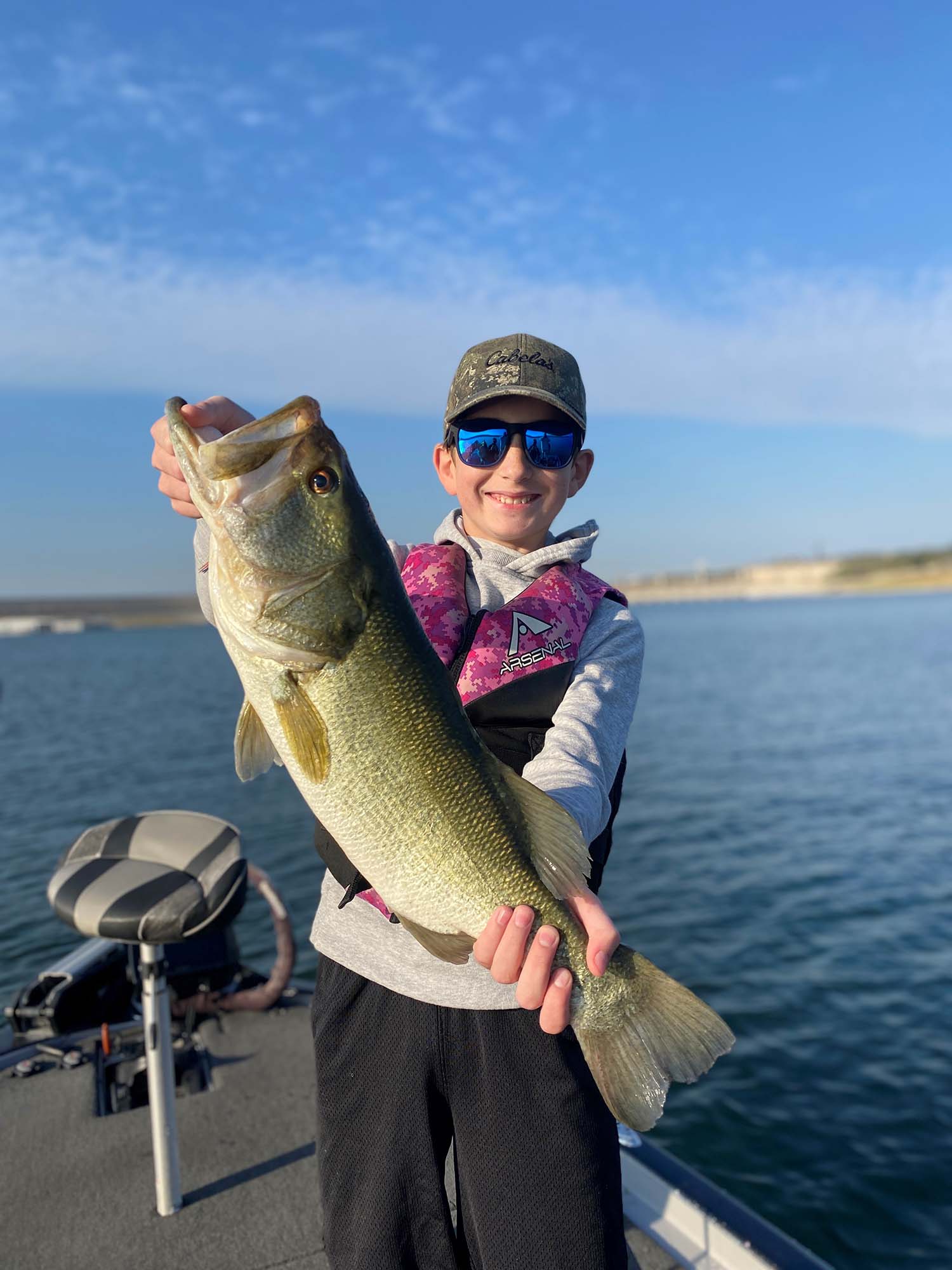
Check out the photo above of my client Brenda holding up a nice bass! Also check out the background, notice how the bank is all rock? Its the same underwater… this is what I am referring to, so look for this type of bank! Wind direction and depth along the bank is also important. I look for banks where there isn’t a super steep drop off, but I do want to find deep water (15+ feet) fairly close by.
Now that you know where to start your search let’s talk about what bait to throw. Without going super in depth (if you want that level of info consider purchasing one of my Honey Hole Reports) I recommend having a variety of crankbaits in different diving depths as well as a swimbait tied on. Early in the fall I focus heavily on shad patterns, baits with gray, silver, and chartreuse in them work well. Once the water gets into the 60’s I start throwing more crawfish pattern baits, so baits with red, orange, and brown will be good. Let this info be of help when selecting what colors of crankbaits to throw.
Choose a bait according to the depth of the bank you are fishing. Often times I will have a squarebill crankbait and a medium diving crankbait tied on ready to go and simply alternate rods as I move along the bank and change from shallow to deep water or vice versa. You want a bait that gets close to the bottom and even digs into the bottom. In some areas of the lake right now there is a lot of grass growing along the bottom. In these areas I select a bait that will stay above it and avoid fouling up the hooks.
I also mentioned swimbaits and Alabama Rigs. Both of these lures can be very effective this time of year. Small 3-4 inch swimbaits or Alabama rigs rigged with the same swimbaits are a staple of mine on Lake Travis this time of year. When there is wind I like o throw these baits, especially the A rig. Wind breaks up light penetration through the water and causes it to refract making it a little more difficult for the bass to get a good look at your bait. They can still find your lure, but I find it makes them a little less discerning and more likely to attach a fast flashy moving bait like an Umbrella Rig. There are days fishing Lake Travis that you can put on a clinic fishing an Alabama Rig in the wind!
The bass fishing on Lake Travis will stay good if not get a little bite better for the next month. Here in Central Texas we are fortunate it never gets super cold, so the water temps rarely get any lower than the mid 50’s. Until the water temps dip below 60 degrees the patterns I discussed above will be good.
Baits like jigs, dropshots, and Texas rigged craws can also be productive on days when the fish refuse to chase moving baits. Target the same areas discussed above, just a little further off the bank. Days with no wind, high barometric pressure and sunny skies will make fish move a little deeper and hold tight to cover. While I prefer throwing moving baits, sometimes slowing down will do the trick. Stick to natural colors like Green Pumpkin and Watermelon. There are several other really good different colors I have found to work when scouting recently, but those I will only tell you in my Honey Hole reports! haha
I put a lot of work into these free reports and love sharing info, however I don’t share ALL my secrets! haha However, I hold nothing back in my Honey Hole Reports. These are paid fishing reports I update every single week at 6:00PM on Thursdays. You will never be getting old out date information. Each report contains 5+ EXACT spots on the map showing you where I am catching fish with my paid clients. I also break down each spot with info on what baits to throw, colors to pick, conditions to look for, how to position your boat, what time of day to fish it, etc. I put a lot of effort into these reports and pride myself on the info contained in them. If you purchase a report and don’t think it was worth your hard earned money I will refund you no questions asked!
Purchase a Honey Hole Report
https://www.torwicksguidingservice.com/honeyholes
If you are looking for a fishing guide in Austin, TX, especially on Lake Travis give me a call or feel free to book online, I would love to get you out on the water!
September 2022

During the heat of summer I find there is usually a short period of time when Lake Travis fishes tough. Not that you can’t catch them, but you have to work hard for them. A good indication of this is if you follow my Instagram account and see me posting a lot of photos from my trips at Lake Decker! Haha I love this time of year when the weather finally starts to cool back down, the water temps start to drop, and the fish get more active. I always tell clients, spring and fall are hands down my favorite time of year to fish.
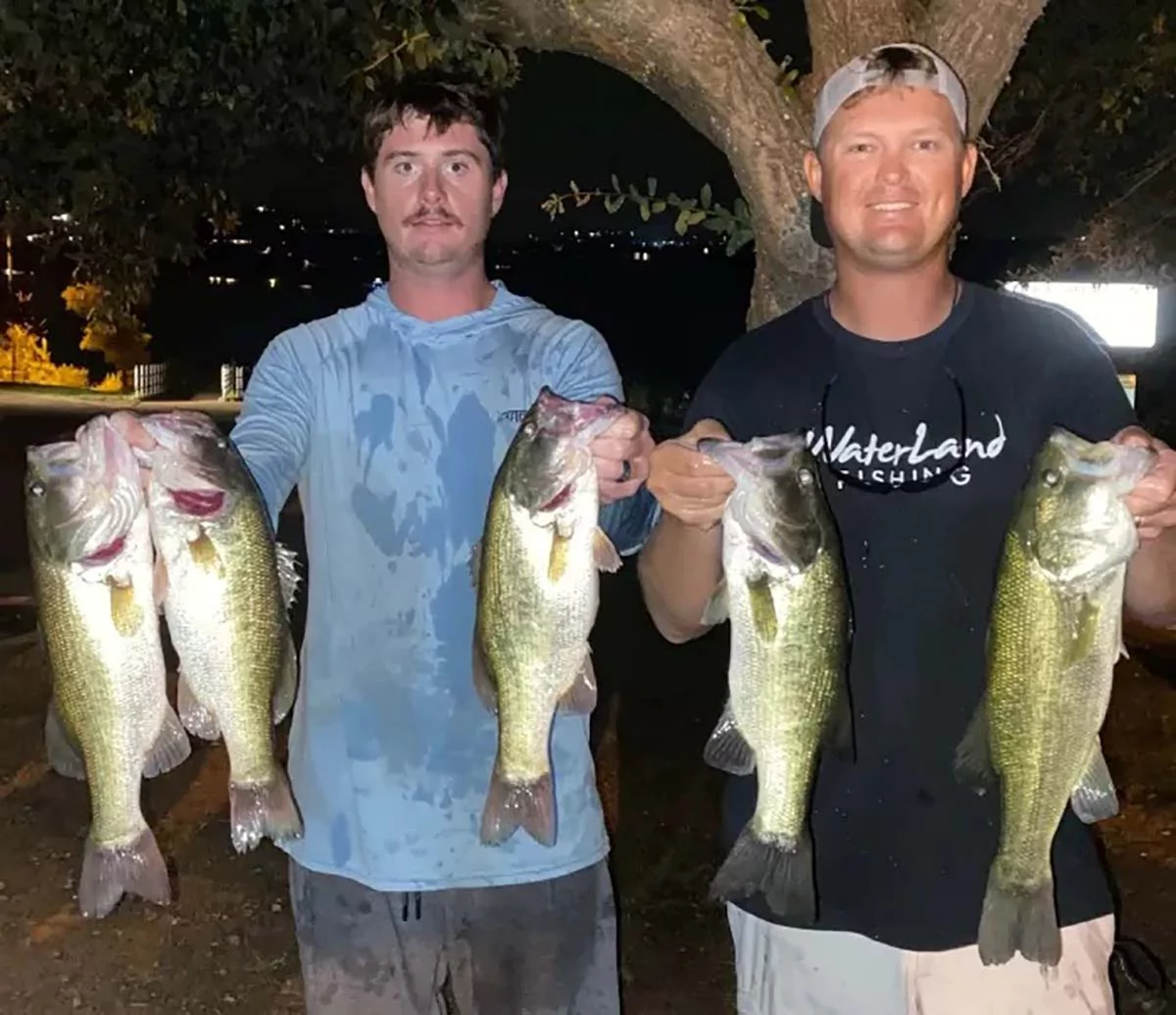
If you follow me on social media you probably have noticed a lot of posts from Lake Travis. The fishing out there has been consistently good and we haven’t even had a big cold front to cool things off. The topwater bite in the morning has been a lot of fun. Crankbaits fished in the same places I fish the topwater plugs have also been very productive.
Right now we are in the early stages of what anglers refer to as the “fall transition”. This is the time of year when the water temps start dropping from their summertime highs and some fish start moving up more shallow. One thing I always remind clients is that not every fish in the lake bee lines it for the bank. Fishing deep will still be productive and a consistent way to catch bass on those days when its bluebird skies with little wind. I know we’ve already passed up the “first official day of fall”, but keep in mind this is Central Texas. Our weather has a tendency to stay hot for a while longer, so the true “fall fishing” bite is a few weeks out. Let me break down the bite I have been on in two ways, fishing shallow and fishing deep.
Fishing Shallow
Early in the mornings and late in the evenings there has been a solid topwater bite. Honestly I have been throwing a little bit of everything as far as baits, but a chrome pop-r and a whopper plopper in a shad color has been consistently getting bit. One key to the topwater bite is finding the right kinds of banks. Avoid bluff walls and steep banks, you will have more consistent success on the more gradual sloping banks. The big difference between a productive bank, and one that will only produce a few bites is structure. Bass are ambush predators and want to be around cover. Look for more gradual banks that have rock, stumps, brush, or grass on them… the more of these things the better. As the lake level gets low on Lake Travis there are a lot of places that set up well at first glance, and on a map look fishy. But upon further inspection they are mostly sand and gravel, these areas generally don’t hold too many fish.
Weather plays a big part of how fish behave and what baits will work better to catch them. Once the sun has come out and it starts to warm up the bass tend to back off the bank and move a little deeper. Now on those overcast or stormy days this will change, but lately the weather has been pretty stable. When it’s like this, backing off the shoreline and picking up a crankbait can produce really well. I alternate between a squarebill and a medium diving crankbait. I switch between them depending on the depth of the bank I am fishing. There is also a type of grass called “chara” that grows up shallow, it’s an annoying stringy grass that doesn’t help attract fish but rather fouls up your hooks more than anything. Sometimes you come across areas where there is a lot of it on the bottom, this is when I will switch to a shallow diving crank such as a squarebill in order to avoid it. Stick to shad pattern baits until the water temps get down into the 70’s, then start throwing some crawfish colors.
Fishing Deep
As I mentioned early in this report, there are still plenty of fish living out deep. I have caught fish from 10 feet all the way down to 35 feet. With that said, focusing on the 10-20 foot depth range has been the most productive. Areas of structure such as rock piles, small ledges, or grass not far from the shallow areas I described early, will hold fish. A good ol’ Texas Rig has been working great lately. A green pumpkin Zoom baby brush hog is an excellent choice right now. One tip though, if you are fishing on the upper end of the lake where the water is a bit more stained, consider adding some chartreuse dye to the tail of your bait. I find that little bit of color makes it stand out and get a few more bites. Whatever bait you are throwing, slow way down with it and keep it in contact with the bottom. Until the water temps drop a considerable amount, a slow presentation with your soft plastics will work best.
Coves with creek channel bends, or banks with rocky veins and drop offs will be a good place to start your search for bass. While it’s still early in the fall, spend most of your time at the mouth of the coves all the way to about half way back. Until it gets a lot cooler I will not bother fishing any further back than half way into the coves. Finesse jigs, shakey heads and drop shots are also baits I will have tied on this time of year, especially on those days the fish are being a bit finicky and want something small and slow moving presented to them.
The fishing is good now, but the best fishing of the year is still ahead of us! As soon as a couple cold fronts roll through and you see the water temps drop several more degrees the fish will get moving! Fall fishing is a blast, not only can you catch them on a variety of patterns but I typically see high numbers and a larger average size fish. Spring is my busiest time of year, but October/ November is a close second. If you do not have a flexible schedule and have a particular date in mind that you would like to get out on the water, consider booking now, the further in advance the better!
https://www.torwicksguidingservice.com/honeyholes
If you have a boat and fish Lake Travis on your own, consider checking out my Honey Hole Reports. These are paid reports that I update every Thursday at 6PM and include 5+ EXACT locations on the lake where I am catching fish with my clients. These reports give you all the info on what baits I’m throwing, colors to use, conditions to look for and a ton more. I put a lot of work into these reports and share all the info on how I’m catching fish with my clients.
August 2022

If you know anything at all about Lake Travis then you know the lake is quite low right now. At nearly 35 feet low as of writing this there is a ton of new structure to fish! While I don’t like seeing the lake so low I do see it as an opportunity to get out and scout. One of the challenges of fishing Lake Travis is learning the lake at various lake levels. From year to year your favorite honey hole could be high and dry, or 30 feet underwater! This is the first time seeing the lake so low for a lot of Austin’s new residents, so get out there and fish it!
During guided trips a lot of clients ask me how I find structure, how I know where the good ledges are, and where the productive rock piles are at. While this isn’t the only way, I take advantage of years when the lake is low to learn the shorelines in preparation for when the lake fills back up. I mention all this because I hear about a lot of people fishing elsewhere due to Travis being low. As long as you stick to the main river channel, watch for hazard buoys, and keep your lake map up while driving, it’s still a very safe lake even as low as it is.
Current water temps on Lake Travis are in the upper 80’s, anywhere from 85-88 degrees depending on the time of day. Water clarity is still very good, Lake Travis is known for being very clear, but at the present time can be a bit more cloudy in some areas depending on the wind. The shoreline of Lake Travis is mostly limestone and as the lake drops exposing new rock and the wind creates chop it tends to make the water a bit more cloudy than normal.
Currently I have been finding most of my fish deep, we are still very much in a summertime pattern. Largemouth bass prefer cooler water which also contains more dissolved oxygen. In an effort to find this, some bass will seek out deeper areas of the lake to live. During the summer understanding how a thermocline affects where the fish live is important. To give you the Cliff Notes version of a thermocline, it is a divide in the lake where the cooler more dense water settles to the bottom, and the warmer less dense water rises to the surface. This divide in the water column can vary in depth from lake to lake and is affected by turbidity, current, and temperature. Currently the thermocline on Lake Travis is around 40 feet deep. The reason I mention this is because largemouth bass do not like to live below the thermocline.
When starting your search for deep summertime bass try targeting areas 20-40 feet deep, there is no need to look deeper unless there is no thermocline present. Offshore areas such as humps on the bottom with rock, small ledges where fish can set up to ambush prey, or bluff walls with docks that provide shade are all places I have been catching fish. Finesse fishing excels this time of year, there are lots of other baits I throw, but what I call the “holy trinity of finesse fishing” is always on the deck of my boat; a shaky head, a drop shot, and a ned rig. These three rigs are very effective at getting down deep, being fished slow, all while presenting a smaller easy to eat meal for those sluggish bass.
With the clear water I have been doing well with natural colors like red bug, watermelon black seed, and green pumpkin. I do experiment a lot with colors and changing them up, but when in doubt one of these three colors will get you bit.
The last but biggest bit of advice I can give you is to slow down! When you think you are fishing slow enough, fish slower! Subtle movements with your rod tip, smaller dragging motions to the side, and a slower reeling presentation with moving baits tends to do better when the weather is hot and the water is hot. I promise you a slower presentation for the next month will get you more bites.
Get out there on the water and go catch a few! If you are looking to learn the lake better and would like to get out with a professional fishing guide, please visit my website for more information on booking a trip.
July 2022
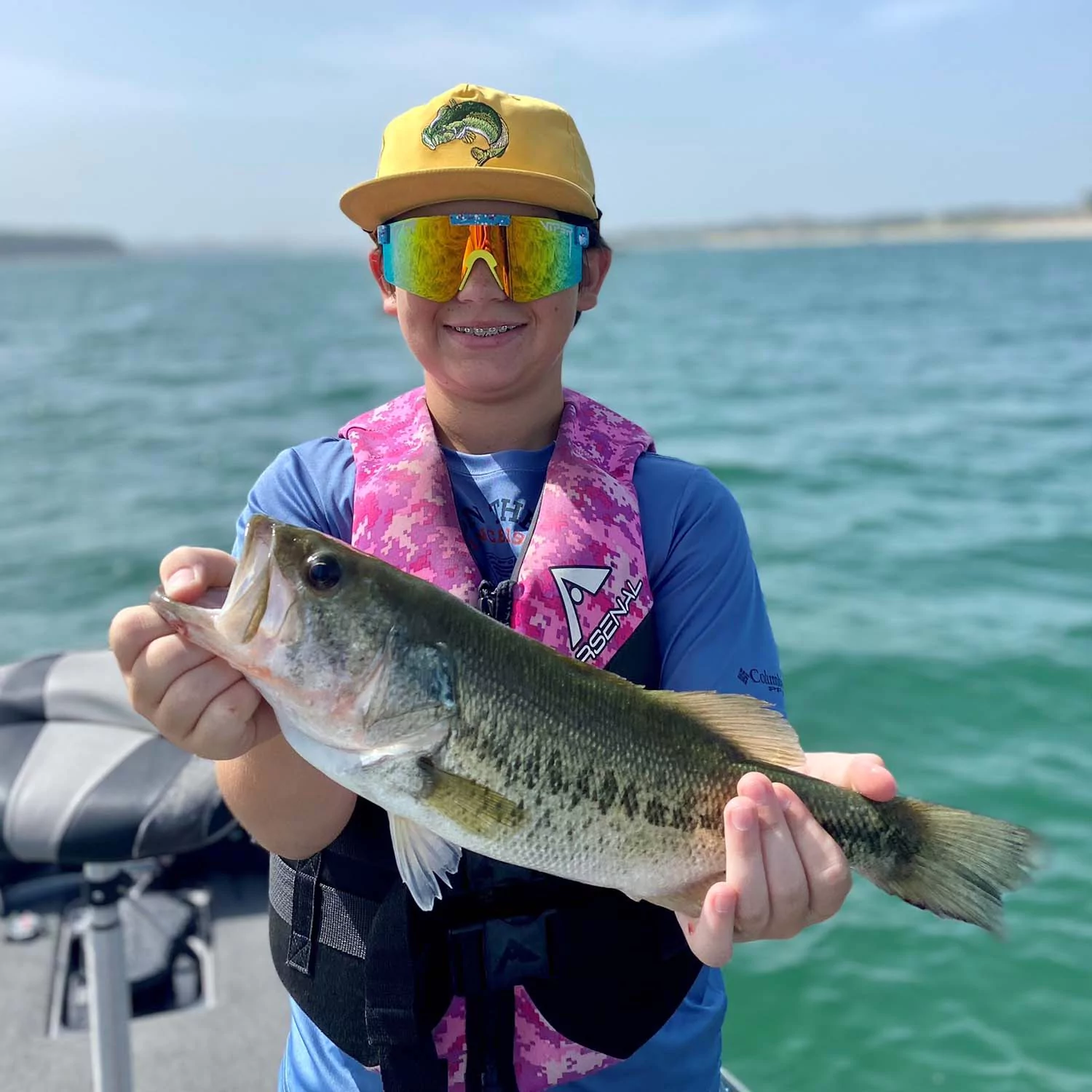
July fishing is notorious for being challenging. During the peak of summer the lake temperature is at its hottest, lately I have been seeing water temps in the upper 80’s. Boat traffic is at an all time high, especially on weekends which can also be detrimental to the bite. Hot water holds less dissolved oxygen and is also less appealing to largemouth bass, they would prefer cooler temps. Due to this then move out deep seeking cooler water. While this may all sound like doom and gloom, fear not! Those fish may have moved out deep but they still have to eat. I have some tips for you that will help put more fish in the boat.
During the summer most of my focus is out deep. Before getting into that I should touch on the morning bite. Early in the morning bass will move up shallow to feed. They take advantage of the cooler temps and low light conditions to feed up. A topwater bait can be productive, but that bite is mainly limited to the first hour of daylight. I recommend getting on the water at gray light, I’m talking about being launched and ready by 6AM. For me a bone or shad colored topwater walking style bait such as a Heddon Spook is a prefered bait. Stick to colors that imitate the threadfin shad in the lake. Look for areas up shallower where there is deep water nearby. Structure such as shallow brush, rock, or a drop off is ideal… just be thinking about where a bass could position themself to be hidden from their prey. Cover as much water as possible and fish fast!
As for the deep bite, this has been the most consistent pattern for me lately. 20-35 feet of water is where I have been finding the most fish. There are three types of offshore/ deep structure I look for, ledges, secondary points, and bluff walls with docks.
Ledges
Look for ledges that sit in 10-20 feet of water on top and drop off deeper. Typically the edge of the ledge will be the most productive area. It’s not uncommon though to get bit at the base of the ledge if the ledge isn’t super deep. On windy days, especially when you get a drop in the barometer, I have found bass positioned suspended off the ledge willing to eat a moving bait like a crankbait or swimbait. For the most part though I stick with a drop shot, a Texas Rig, and a Carolina Rig. Zoom trick worms in natural colors like green pumpkin or watermelon black seed have been good options for the dropshot. For the Texas Rig and Carolina Rig I like a Green Pumpkin Zoom speed craw or senko. Fish these baits very slow and maintain that bottom contact, that is the key.
Secondary Points
Secondary points are points underwater further away from a primary point, often separated by a flat. Areas like this are natural places for bass to congregate since it’s typically the only ambush spot on the bottom in these areas. During the summer the bass spend a lot of time just hanging out in small schools. Ambush points are always good places to look, but sometimes they just relate to structure since it’s instinctual, not always to position themselves to feed.I approach these the same way I approach ledges as far as baits. These spots tend to be deep, so selecting a rig I can get down to those depths and effectively present the bait is most important. You need to have the confidence that you can feel your bait hitting the bottom and be confident it’s down there where the fish are. I look for secondary points in 20-35 feet of water… so pretty deep. I recommend upping your weight if need be in order to maintain that bottom contact. Another bait I throw is a ½ or ¾ ounce football jig in brown/ black. I love these since I can cast them far, feel the bottom easily and they don’t get snagged too easily. Try fishing secondary points later in the day as these are usually places bass hang out once they have moved out deep.
Bluff Walls
Lake Travis has a ton of bluff walls, but not all of them are created equal. Look for bluffs with docks on them. The angle of the bank also makes a difference. I look for steep banks, but not sheer cliffs. Ideally I want the front of the docks to be sitting over about 40 feet of water, too deep and these areas are tough to fish. When fishing these I position my boat so that I can make forward casts more parallel to the bank. I want to keep my bait in that 20-35 foot depth range. If you position your boat too far off the bank you spend more time letting the bait sink, or worst case, just swinging back towards the boat not even on the bottom. For these spots I recommend a drop shot, a shakey head, and a ned rig… what I call the “Holy Trinity of Finesse Fishing”. Smaller subtle baits tend to get bit better this time of year. Look for bluffs with docks as the bass will oftentimes hangout under or around them for the shade. Casting up near the back of the docks near the staircases is always a good spot! (just watch out for those dock cables)
My biggest piece of advice this time of year is to get out early while its cool, avoid the weekends when it’s busy, and pack lots of cold drinks! If you know me you know I HATE the cold! I’ll take 100 degree temps over snow any day. While the weather may be hot, the bite can sometimes be just as hot! We’ve had some really productive trips lately, so don’t let the fear of summertime fishing stop you from hitting the lake.
For those of you with a boat headed out to the lake, consider checking out my Honey Hole Reports. These reports are updated each Thursday at 6:00PM with fresh info. Each report contains 5+ EXACT spots with all the information needed to fish them. I divulge everything I have been doing that week with my paid clients during my guide trips. These reports go into extreme detail compared to the free reports you here or on my website. Consider purchasing one today! If you do not feel it was worth your hard earned money I will gladly refund your money.
https://www.torwicksguidingservice.com/honeyholes
June 2022
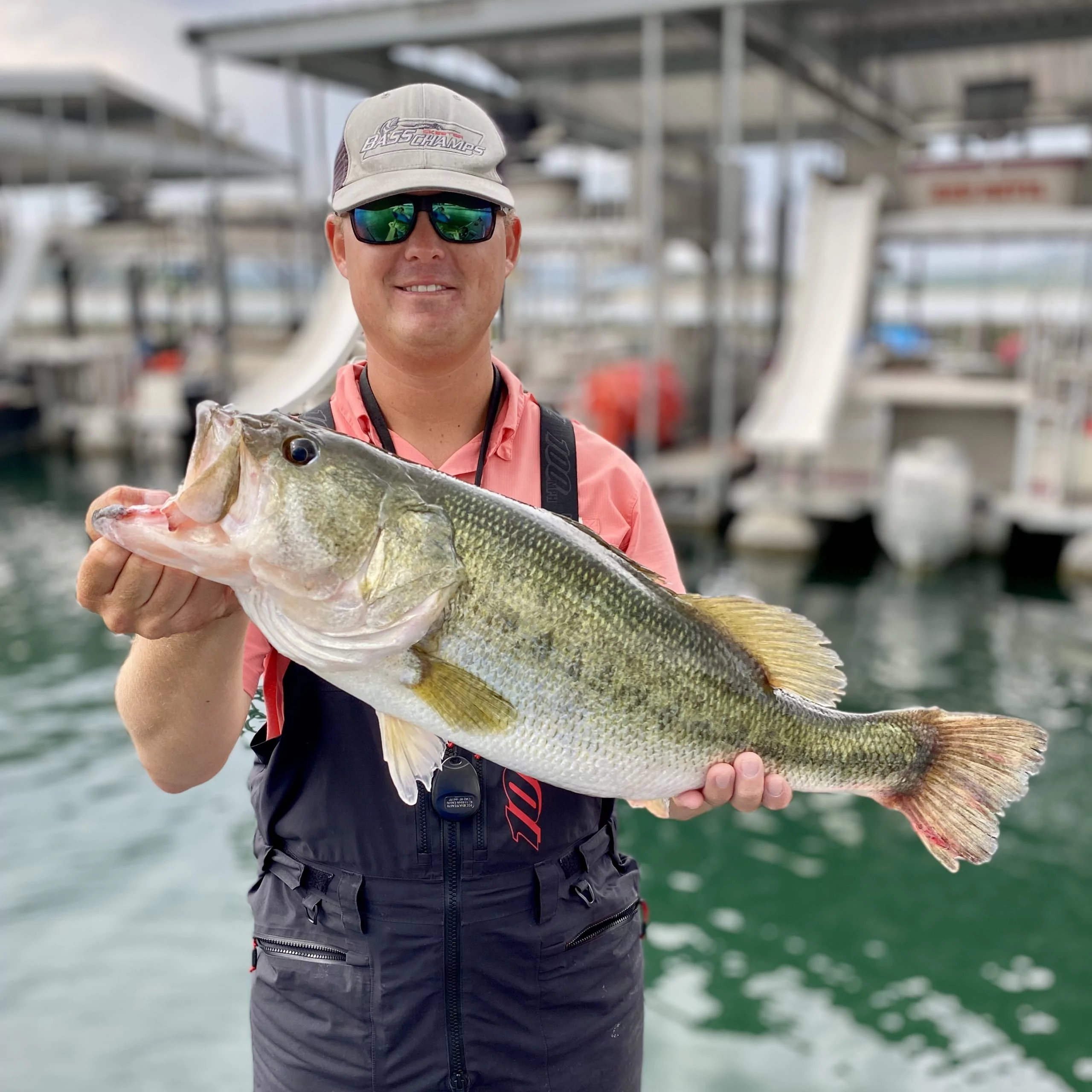
June marks the beginning of summer, and with the warm weather lately the fish know that! Warm water temps drive fish deep in search of more comfortable conditions. Currently lake temps are in the low 80’s but are on the rise. The current lake level is about 28 feet low, but by the time you read this it may be a couple feet lower! During this time of year, there are two main patterns I fish in order to consistently find fish.
Schooling Fish
During the summer months the bass take advantage of the cooler temps in the early morning and late evening. They also prefer low light conditions to feed. During these periods of the day you can find bass patrolling marinas that sit over deep water. These areas typically hold schools of threadfin shad, which is one of the primary food sources for bass. Live sonar is very effective for finding these fish, but simply paying attention to the water and looking for splashes can also give away the bass’ location. Small paddle tail swimbaits, casting spoons, and topwater baits can be effective in targeting these fish. Long accurate casts are the key to catching these fish. When you see them jump, throw right into the middle of them. When they are not on the surface, make long casts and let your bait sink 8-12 feet deep before beginning your retrieve. Stick to colors that resemble a threadfin shad, these tend to get bit the best.
Deep Offshore Fish
Once the sun has come up and it has gotten hot again the fish tend to move fairly deep. With the lake so low there is a lot of good structure at the right depth out close to the river channel on the main lake. Look for ledges and secondary points in anywhere from 15 to 35 feet of water. Bluff walls and creek channel bends where the shoreline is fairly steep can also be very productive. For this type of fishing there are four baits that are my go-to’s, but there are plenty of others that will work. A drop shot, a football jig, a Carolina rig, and a deep diving crank bait can be very effective. Choose a bait that will get down to the depth the fish are at, oftentimes bottom contact is key to getting these fish to bite. Summer fishing often requires a fair amount of graphing with the sonar before making a cast. I will usually make several passes over a point or ledge trying to pinpoint the bass’ location before ever making a cast. A slower retrieve with your baits such as the drop shot or jig will work best on those hot days when the bite is slower. On days when we have weather moving through or some cloud cover, that deep crank bait can work well to fire up a school of hungry bass!
Something new this year I am offering are what I call my “Honey Hole Reports”, these paid fishing reports are much different than the reports you can find here. These reports are updated weekly on Thursdays at 6:00PM and contain a minimum of 5 pins on the map showing you EXACTLY where to fish, what bait to throw, what color to use, how to present it, what time of day to fish the spot, etc etc. These are extremely detailed reports where I give you the info on what is working to catch fish right now! These aren’t community holes, these are spots I am catching fish with paid clients. Use code “LAKETRAVIS.COM” for 10% off your first report!
If you are new to Lake Travis and want to learn to fish the lake more effectively, consider booking a trip with me! My trips are geared around education, and I promise I can cut your learning curve drastically. Please feel free to visit my website, or give me a call!
Tight Lines!
May 2022
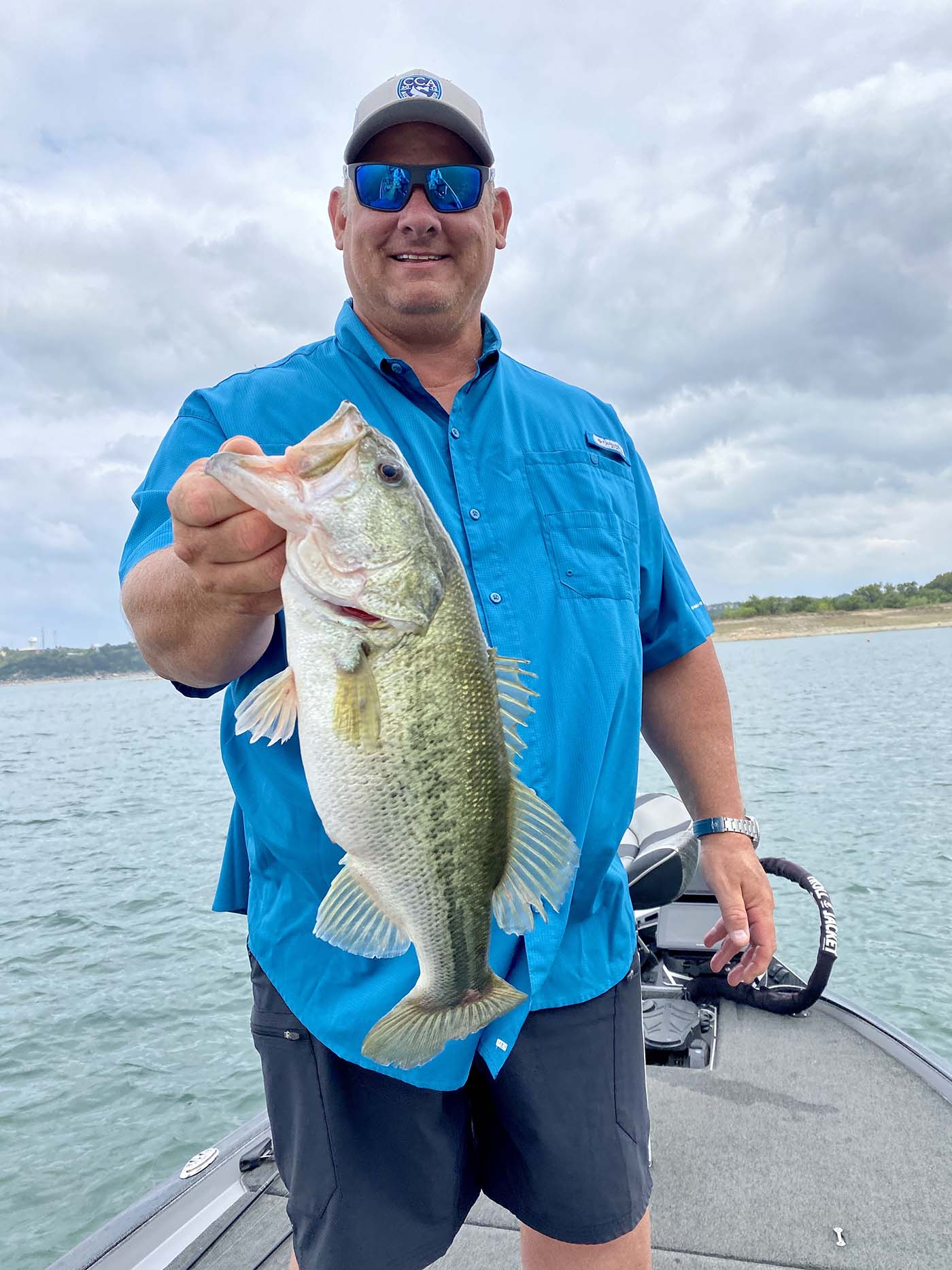
If you follow my reports you know Spring is my favorite time of year to fish. May in particular is one of my favorite months! Why is that?… Well that’s because it’s a great time to get bit throwing moving baits and on topwater. As the water gets into the 70’s the bait fish in the lake spawn. Wind blow shorelines and big marinas can hold a lot of bait fish, which in turn attracts the bass. Don’t get me wrong, I love fishing jigs, Texas rigs, drop shots, etc… but getting slammed on a moving bait like a swimbait is a blast since there is no doubt when you get a bite!
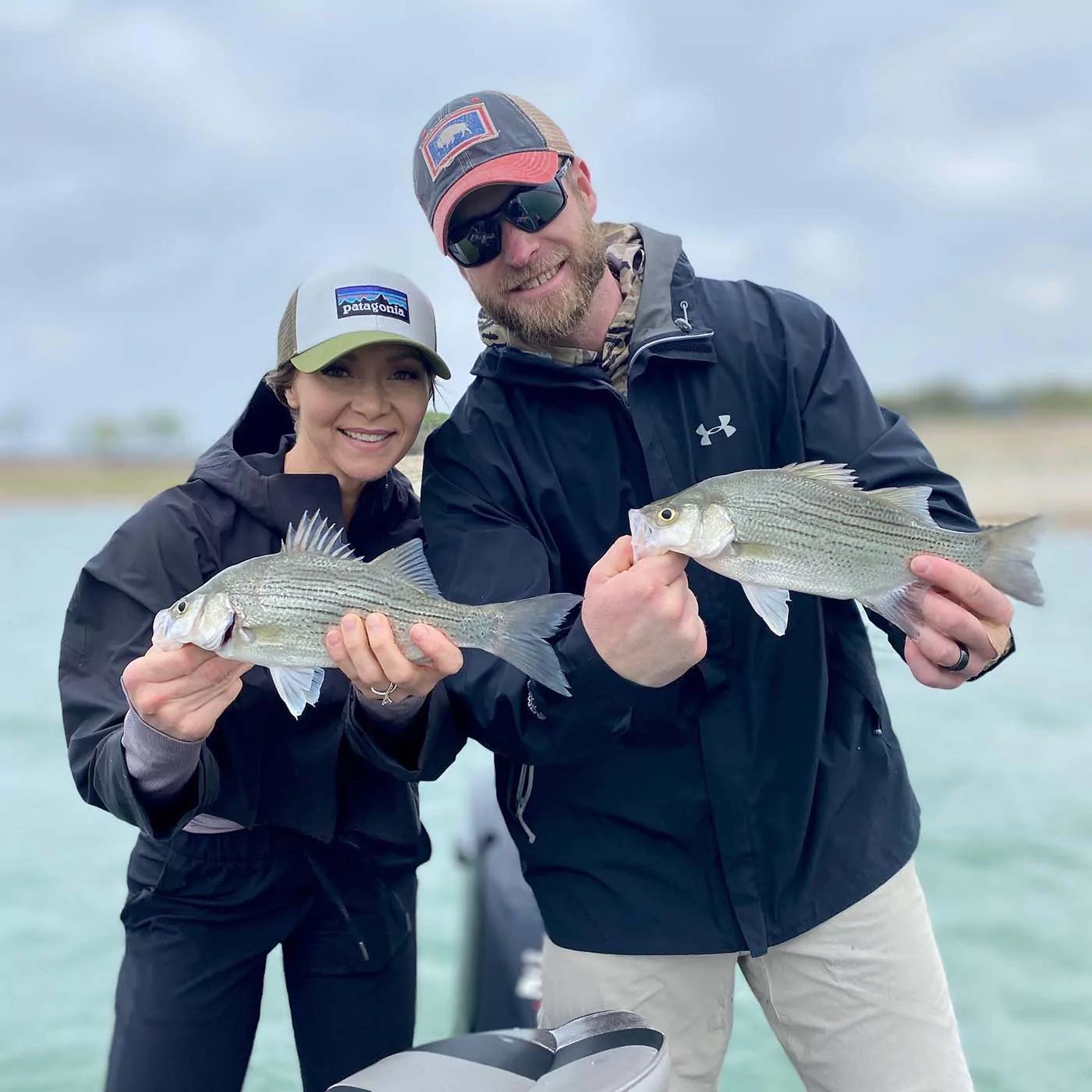
During the month of May there are two patterns I would recommend you stick to. The first being throwing moving baits. When I say this I am referring to baits you cast and retrieve that mimic threadfin shad. There are four baits I recommend you have tied on at all times.
- A swimbait- I like to throw a 4” paddle tail swimbait rigged on a ¼ ounce lead head a lot. It casts far, covers a lot of water, and looks very realistic. Focus on rocky shorelines that are not super steep. Areas getting hit by the wind are usually the best. Make long casts with the swimbait around cover and work it over any drop offs you find underwater.
- A fluke- A Zoom fluke in a baitfish color is a deadly bait fished up shallow. Areas such as shallow points or drains outside of spawning areas will hold bass this time of year. I like to rig a fluke weightless on a 4/0 hook and fish it similar to a jerkbait. I prefer the weightless presentation, but in the wind I will sometimes switch to an Owner twist lock hook with a small belly weight. It is very light, but that little bit of lead helps it cast far.
- Alabama Rig- This bait has a reputation as a cold water bait. I completely disagree! I fish this bait around docks and marinas to mimic the schools of bait fish that are also living around them. You can cover a lot of water with this bait and trigger reaction bites with it.
- A Heddon Zara Spook- A bone colored spook is one of my favorite topwater baits. The ability to “walk the dog” with it, then pause and kill it every once and a while is very enticing to spring time bass. Fish this bait over and around cover can trigger some exciting blow ups.
The second pattern I recommend is slowing down and fishing a Texas rigged plastic craw. Throwing the moving baits is more fun in my opinion, but sometimes the fish get lethargic or the conditions just call for slowing down. Rig up a Texas rig with a ¼ or 3/8th ounce bullet weight (the windier/ deeper the heavier I go) and a 4/0 EWG hook and a craw style bait like a Zoom speed craw. Focus on rocky areas outside of places you have found bass historically spawning. The fish are post-spawn at this point so they will be making their way back out to the main lake and feeding up. Lake Travis is mostly rock, so there is a large population of crawfish in the lake. While the shad pattern is very popular to fish this time of year, imitating crawfish can also produce some nice fish!

Do you fish Lake Travis often but unsure where to fish? Something new I am offering on my website is what I call “Honey Hole Reports”. These fishing reports are different from the free reports you get here! These reports give you 5+ EXACT spots on Google Earth showing you exactly where to fish. They also go into extreme detail telling you what baits to throw, what colors to throw, how to position your boat, what conditions to look for etc. Each paid report comes as a .KML file opened in Google Earth, accessible on both desktop and mobile. With this report you even get the exact GPS coordinates of where I recommend you fish! Visit https://www.torwicksguidingservice.com/shop-2 to check out these reports!
Good luck out there on the water!
April 2022
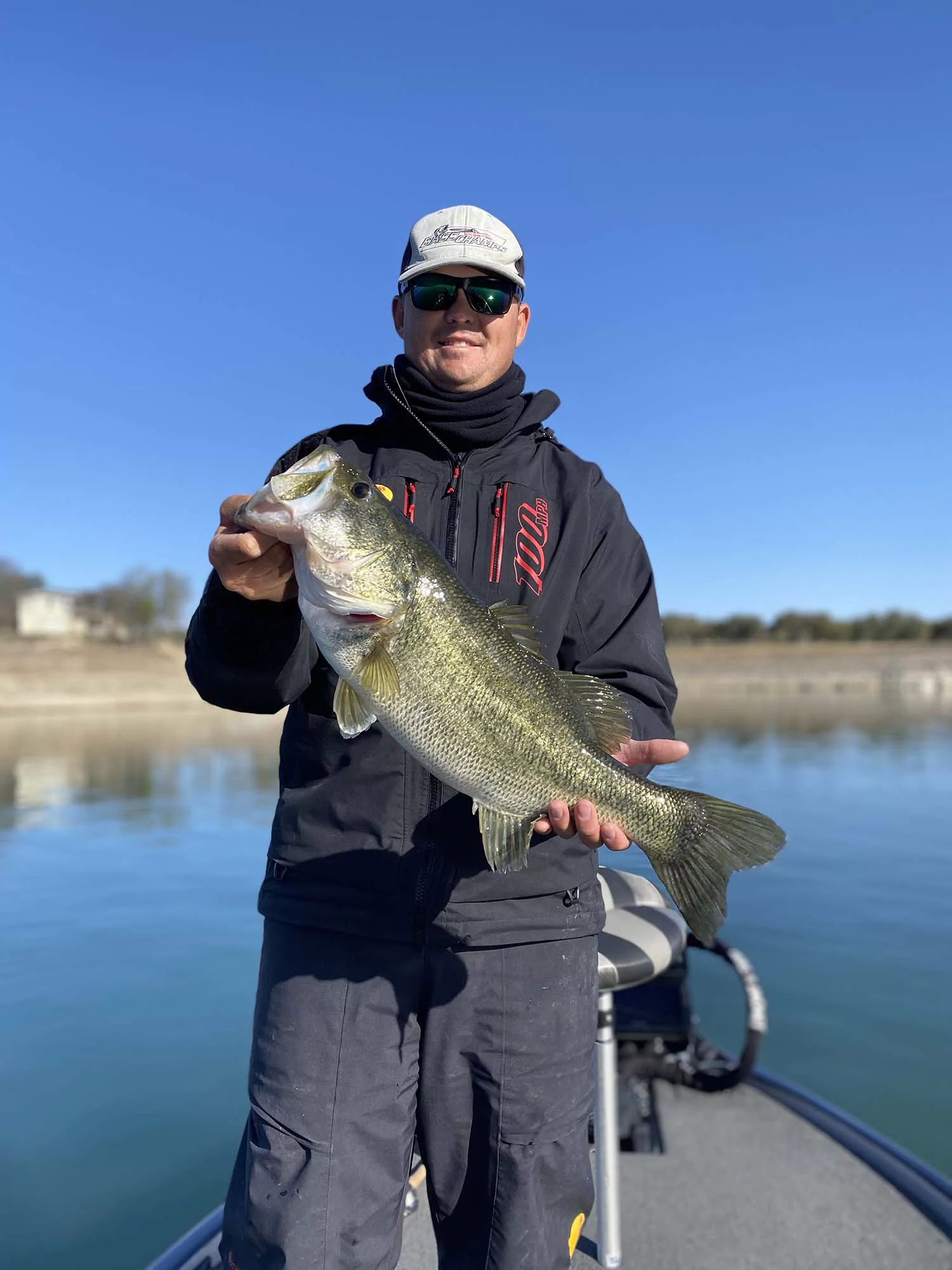
April is an excellent month to fish on Lake Travis! By this time the bass have begun spawning and will continue to do so the rest of the month. Towards the ends of April you will also begin seeing Threadfin and Gizzard Shad spawn in the lake. These are the primary species of baitfish that bass feed on in Central Texas. With water temps in the low to mid 60’s and water clarity anywhere from 6-15 feet depending on what end of the lake you are fishing, the conditions right now are good!
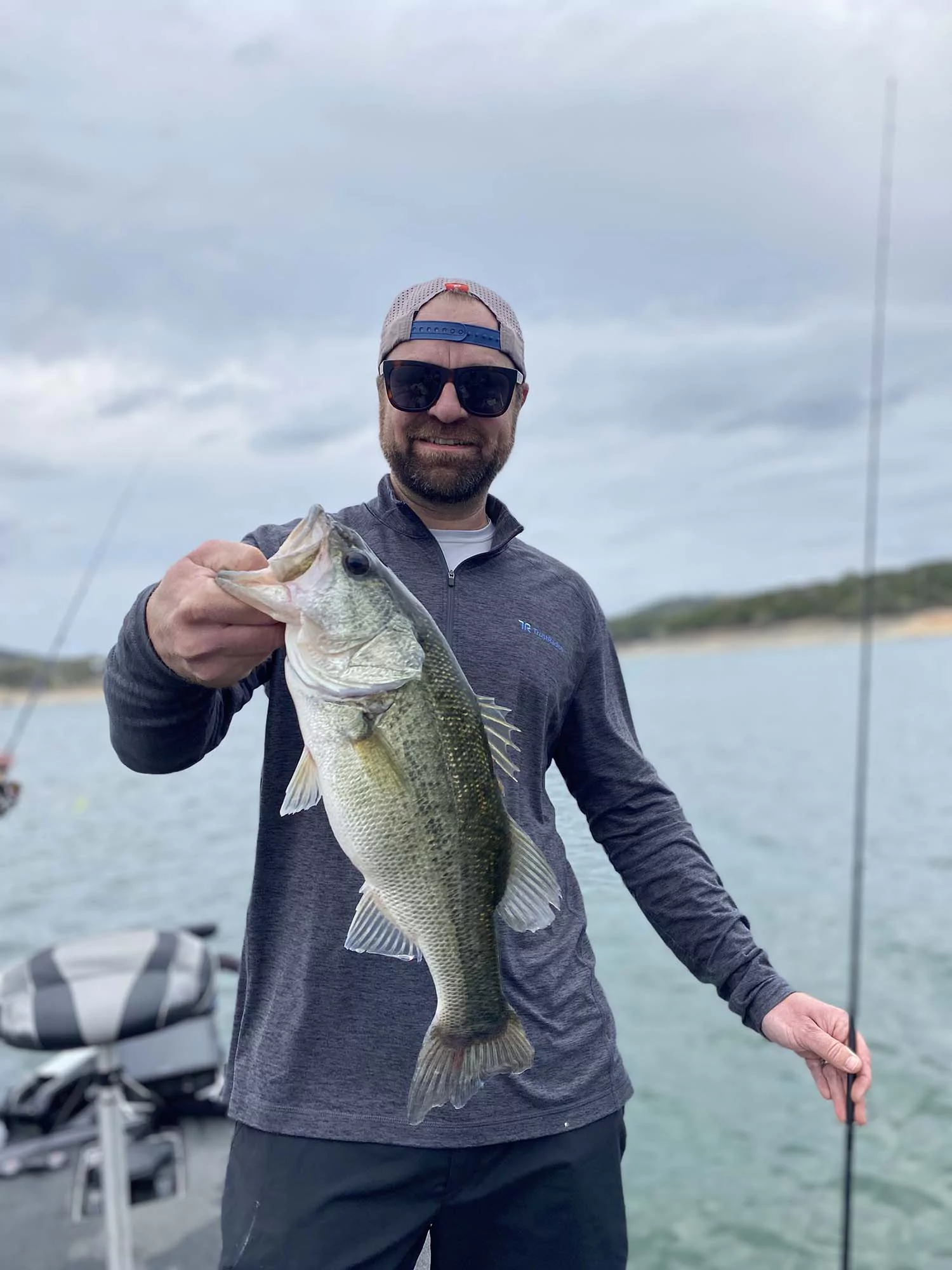
Currently there are two main patterns I would use when targeting bass on Lake Travis.
1. Targeting spawning fish on nests
During the spring bass move up shallow to build nests and lay their eggs. When they do this you are able to sight fish for them and catch them off their nests. Keep in mind during this time the fish are not focused on feeding, rather they become very territorial of their bed. This is why you can pitch a bait into their bed and agitate them into biting.
Where to look: I recommend searching for beds in the back of protected coves and on spawning flats. The fish will seek out protected areas away from wind and boat traffic where they will not be disturbed. Often times they like to make their nests directly next to some cover such as old stumps, rocks, or shallow anchor blocks from docks. Keep your trolling motor on low and put on a pair of polarized sunglasses to aid in seeing the beds on the bottom of the lake.
What to throw: I recommend a craw style bait rigged on a Texas rig or a drop shot with a very short tag end between the hook and weight. I like to use bright colored baits such as white and bubblegum. I use these bright colors since they are easy for me to visually see on the bottom of the lake. It is common for the bass to pick up and bite you lure very quickly, then spit it back out. They are not interested in eating it, just hurting or killing it. Because of this, you need to be quick to set the hook. A bright colored bait lets you see it disappear in their mouth easily. Pro tip: if the fish is being finicky and not biting the bait but is expressing interest in it us a scent. I like to use a crawfish scent on my plastics to make it a little more enticing. You may also get more aggressive with your approach and hop the bait more erratically and even try to bump the bait into the fish’s nose.
One other important thing to mention! Once you catch a fish off a nest, please return them to the lake quickly. Don’t put them in your livewell, don’t stress them out taking a million pictures… let them go so they can repopulate our lake with more bass!
2 Target fish feeding on Shad
During the Spring months bass tend to feed heavily on fin bait. Throwing small swimbaits that mimic threadfin shad can be a great way to cover a lot of water and catch a lot of fish. I recommend a 3.5 or 4 inch paddle tail swimbait rigged on a ¼ ounce lead head. Stick to colors that imitate a baitfish, anything white, grey or silver will work well. Focus on rocky shorelines with a more gradual slope to them. Areas where there are small drops offs that allow fish to sit at the base of them waiting to ambush prey are even better. Make long casts and use a slower retrieve. Anytime you see shallow structure in the lake such as brush, anchor blocks, or isolated rock piles, make sure to cast at those. Repeated casts alongside structure like this can often lead to a few extra bites.

I hope these tips help you catch more fish! April is a busy month at Torwick’s Guiding Service, but I do have a couple dates open towards the end of the month! Visit www.torwicksguidingservice.com to book your trip.
March 2022

March and April are historically some of the best months to fish Lake Travis. They’re my personal favorite at least! Spring is in the air, the weather is finally warming up, and the water temps are slowly rising. When bass spawn varies slightly year-to-year depending on if we have a warm winter or not. One thing I always notice is when the trees start getting little green buds and flowers on them, the fish will be moving up shallow. Warmer water instinctively tells the fish that it is time to build nests and lay eggs. When this happens the fishing gets good!
During March there are two patterns I focus on… pre-spawn and spawn fishing. Let’s start with pre-spawn. This is when the bass make a migration out of deep water where they have been living during the winter. They are going to slowly move back into the creeks and coves in search of spawning areas. Largemouth build nests up shallow in areas protected from the wind and waves. The backs of creeks also tend to warm up quicker than the main lake since they are not as deep. To know if you should be looking for bed fish or be targeting pre-spawn fish, keep any eye on the water temps. Once water temps reach the low 60’s you will find fish on beds. Until then, you are best off targeting pre-spawn fish.
When it comes to pre-spawn bass there are a lot of lures you can throw, but I will limit it to my top three baits: a Medium diving crankbait, a jerkbait, and an Alabama Rig. What all three of these have in common is that they are moving baits and allow you to cover water quickly. Alternate between these baits and target points and drains outside of areas bass spawn. Fish will not bee line it back into the coves, they will move to the mouths of the coves and stage before actually building a nest. First I look for places I have historically found a lot of bed fish, then work my way out. Identifying areas close to creek channels, but up shallower are also good areas to look for fish this time of year. Structure is always something to be on the look out for as well, rock piles, ledges, or brush close to these areas will attract the fish and are high percentage places for you to cast.
I prefer the crankbait and Alabama rig when there is a little bit of wind or cloud cover, I find those conditions help. When its more calm or the bite is slower a jerkbait allows me to cover water, while still fishing slower since I’m able to pause and suspend the bait when fish aren’t as aggressive. For the A rig and jerkbait stick to colors that imitate a threadfin shad. As for the crankbait, I like to throw mostly craw imitation colors such as red/ orange and brown.
Later this month I expect to start finding fish up on beds. Coves that are protected from the wind will be the first places I look. For this style of fishing it’s all about visually seeing the fish. Polarized sunglasses are a must! Get on your trolling motor and quietly move around docks up inside the coves looking for white spots on the bottom. Male bass will clear away debris and sediment on the bottom of the lake creating a nest for the female to lay their eggs. When bass are spawning they are not hungry or fixated on feeding, rather they are territorial and will attack something that poses a threat to them. Because of this, a well-presented bait can work well to catch them. There are a couple baits that I like to throw in particular when the bass are spawning. A Texas rig with a creature bait and a pegged weight can work very well for making accurate pitches at a bed. As far as plastics go I’m not very picky, anything that resembles a crawfish usually works well. Personally I like to use bright colored baits such as white, bubblegum, or chartreuse. Often times when the bass strikes your bait it is very quick and they usually spit it back out. They are not trying to feed, rather they are just trying to get your bait to go away. Bright colored baits allow you to visually see the fish eat the bait and thus set the hook quicker. Another one of my go to setups is a drop shot. However I rig this differently than I normally would. For this I like to fish it on a bait casting setup in order to use heavier line and have more control when I pitch this bait into the fish’s nest. Start by tying your drop shot with an exposed hook and a very short tag end between the hook and sinker. I like to keep the sinker only 4-6 inches from the hook, this way the bait isn’t up above the fish’s head. One reason that I like to throw a drop shot for bed fish is because it allows me to continually move and work the bait without actually moving the sinker and pulling it off of the nest. A wacky rigged bubblegum colored trick worm is my favorite bait for this.
The fishing is only going to continue to get better over the next couple months! If you’ve been on the fence about booking a guided trip, now is the time! I book up very far in advance during the spring. I do not have any weekends open in March, however I do have a very limited number of weekday spots open. I do have some openings available in April so don’t wait!
February 2022

It’s February and you know what that means! Spring is right around the corner! If you’re an angler like me you look forward to spring all year long. Spring means everything is green, the bass are getting ready to spawn, and the fishing is about to bust loose! In the part of Texas the bass tend to spawn fairly early compared to the rest of the country. With that said you typically don’t start seeing fish actually on nests until the very end of February. February is broken up into two main patterns, winter fishing and pre-spawn fishing. Let’s discuss both!
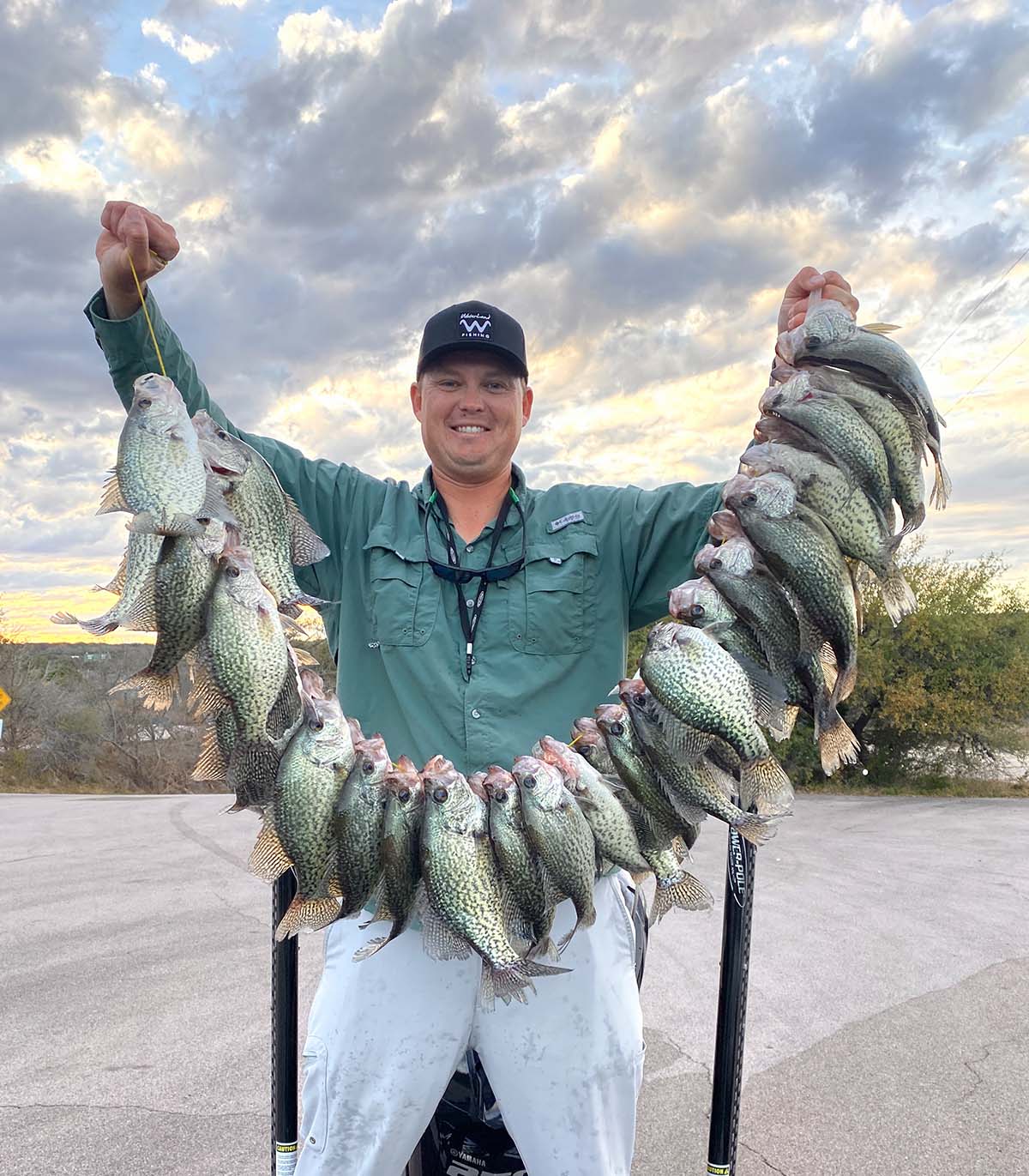
Winter fishing, if you read last month’s report this will be quite similar. During the winter months when the water is at its coldest the bass seek deep water in search of stable water temperatures that are less prone to fluctuating with big cold fronts or warm sunny days. Look for fish in anywhere from 20-40 feet of water. There are exceptions like when there is a warming trend and the fish will move up shallow to feed. For the most part though you will be more productive searching out deep. Look for structure such as main lake points, ledges, and deep rock piles. Bass will also move to cover; look for deep boat docks and staircases. (Something to note, the words get interchanged often but “structure” is technically contour changes such as points or ledges, “cover” is an object or objects that create an ambush spot for a bass… think docks, brush piles, stumps.)

As far as baits go, there are a couple that I recommend you keep tied on. A Ned rig with a green pumpkin TRD worm, a Neko rigged Grande Bass airtail rattler, and a finesse jig are all bottom baits I like to fish slow this time of year. On cold bluebird sky days you really need to force yourself to slow down and give your bait long pauses. Cold water slows the fish’s metabolism and they are less likely to feed on an erratically moving bait. On days with a little wind, cloud cover, and a falling barometer I like to throw baits that elicit a reaction strike, a jerkbait, an Alabama rig, or a small paddle tail swimbait on a ¼ ounce lead head work well. With these moving baits stick to colors that resemble a threadfin shad. (i.e. silver, white, smoke)

This style of fishing will last a few more weeks. Keep in mind though the seasonal transition these fish make has to do with water temperature and not the date on the calendar. If we have several more cold fronts it could push back the spawn. Keep your eye on the water temps, once the temps start creeping back up into the high 50’s low 60’s the pre spawn bite will kick off.
Pre-spawn fishing is a blast and it often presents you with the best chance of catching a BIG bass! Largemouth bass are at their heaviest when they are full or eggs but have yet to lay them. During this phase of the spawn they make a migration from their winter deep water homes, to areas close to spawning coves and flats. If you are fishing later in February start looking for the tops of small ledges that are close to deep water. You want to look for places where it’s convenient for the fish to move out of deep water and still be close to areas they would eventually build a nest in. I recommend starting at the mouths of coves and working your way inside. Bluff walls near the mouths of spawning coves can also hold a lot of fish early in the pre-spawn phase.
As far as bait selection goes, I also break it down into two categories, baits fished on the bottom and moving baits. Texas rigged creature baits, football jigs, shakey heads and drop shots are all effective baits. Despite the fish getting a bit more active, I still recommend fishing these slow. With that said, let the fish tell you what they want. If you notice the majority of your bites come on the pause, fish even slower! Whereas if most of your bites come when you are actively moving the bait, you can pause less and fish a bit faster… when in doubt fish slow though. When the moving bait bite is good I like to tie on a red/ orange squarebill, a white spinnerbait, a 4” Keitech on an underspin head, or a fluke rigged on a belly weighted hook. These baits will let you cover water quickly, but once you catch a fish slow down and make repeated casts in that area. During late February bass feed on both crawfish and shad, so I like to mix it up with the colors I throw.
As a little “bonus report” I also have some info on Lake Travis crappie fishing for you. While I do not offer guided Crappie trips, there are some nice ones in Lake Travis. The Crappie bite has been good on small 1/16th ounce jigs with chartreuse and blue or black and chartreuse jigs. Small minnows fished on a 1/16th ounce lead head have also been very productive. Look for docks in 20-35 feet of water that have metal staircases under them, use your side scan sonar to find the schools of Crappie and drop your baits down into the middle of the schools.
I recently made a in-depth video on how to find and catch these fish, so check it out!
Each year I look forward to this month because it’s a sign that spring is on its way, the bass start moving around and transitioning, and the fish are at their heaviest! Get out there and catch a few! If you are interested in booking a trip with me, visit my website via www.torwicksguidingservice.com and click that Book Online tab!
January 2022
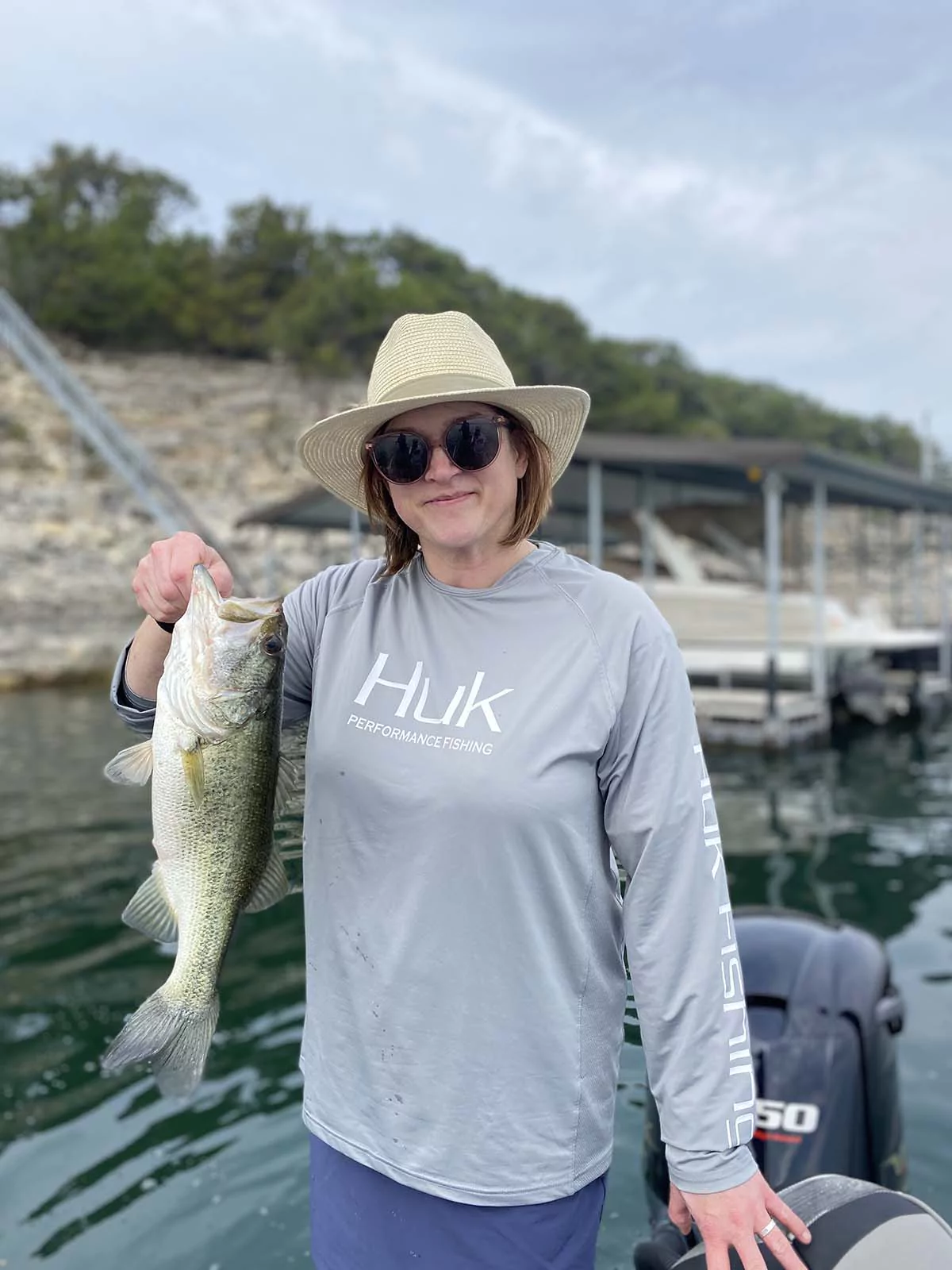
Happy New Year everyone! The fishing on Lake Travis has actually been really good lately. Personally I prefer winter fishing to summer fishing, but as water temperatures drop, the fish’s metabolism slows. This normally means slowing way down with your presentation or going with a bait that will trigger reaction strikes. With that said, it has been unseasonably warm. As of writing this at the beginning of January, water temps are still in the mid 60’s! I’ve even seen a couple bass beds, indicative of spawning behavior… talk about some confused fish!

Right now the fish are a little mixed up. I have been catching bass off both fall and winter patterns. My biggest piece of advice when on the water is to keep moving, change baits often, and think outside the box. Don’t get fixated on throwing just one or two of your favorite baits. I have found fish out shallow and out deep, so being versatile is key to consistently catching good numbers of bass.
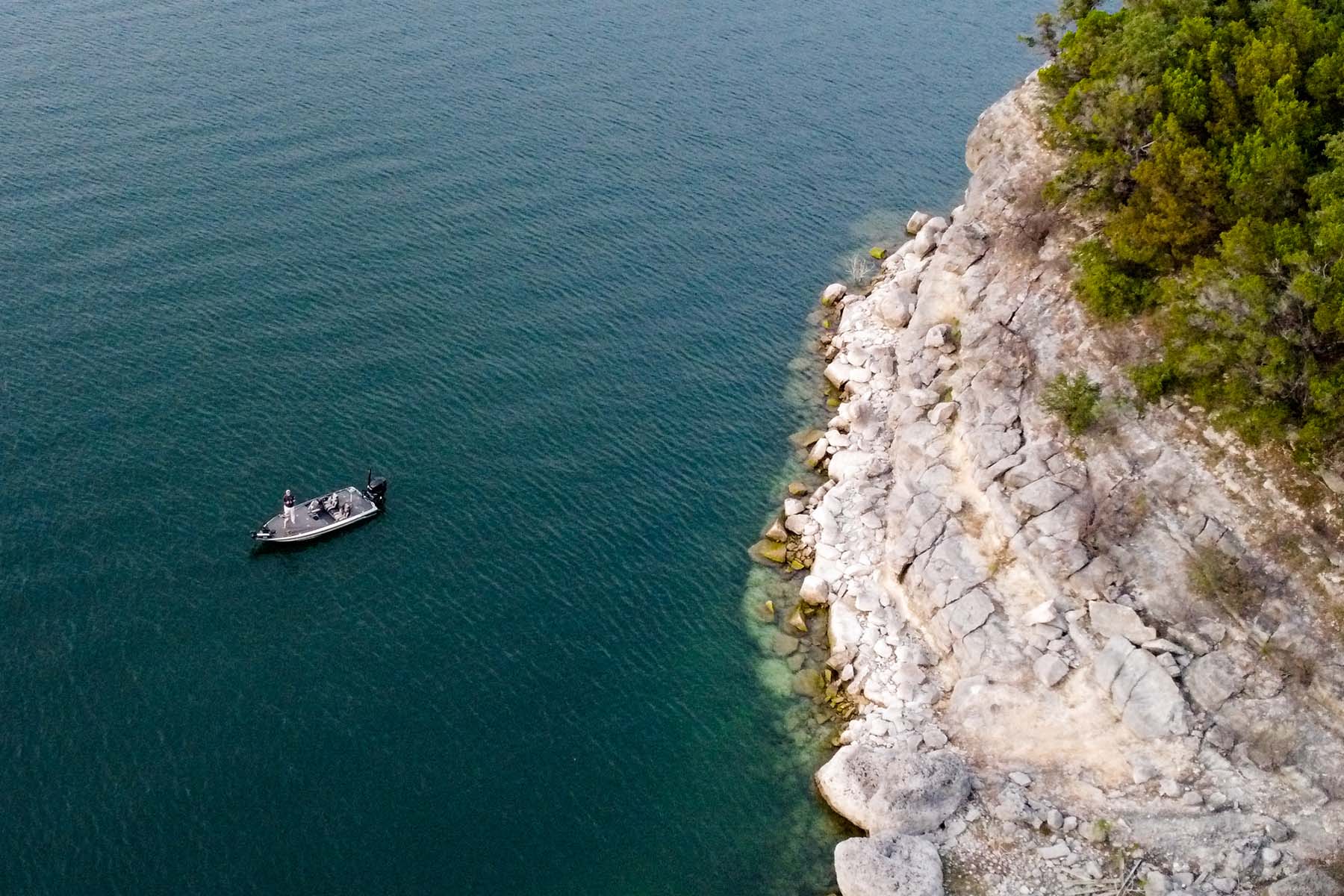
Let’s start off with our bottom baits. Right now you can get bit fishing around docks on bluff walls in 15-30 feet of water. If the fish are a bit more active I prefer to fish a small football jig. I recommend downsizing to a 3/8th ounce jig, trimming the skirt down and using a smaller profile trailer. Getting that jig as close as you can to the backs of the docks near the staircases is going to get you bit. If you lack confidence in a jig you can substitute it with a Texas rigged craw style bait with a 3/8th ounce weight. Green pumpkin speed craws are an excellent option.

When the bite is slower I will rotate between what I like to call “the holy trinity of finesse fishing.” Which are a drop shot, a Ned rig, and a Shaky head. These three baits never leave the deck of my boat no matter the time of year, when fishing Lake Travis. Travis is a gin clear rock fishery and finesse baits excel. Stick to natural colors like green pumpkin, watermelon, or variations of those. I especially like the drop shot when fishing around docks as you can effectively fish it close to the docks. With all these baits, slow down and give the bait long pauses. Watch your line to make sure you are maintaining bottom contact, especially when you get down deep with the bait.
Conditions like wind, a drop in barometric pressure, or a drop in temperature can often get fish active. This is when I like to pull out the moving baits, which is my personal preference for catching bass. This time of year I recommend having an Alabama Rig, a jerkbait, and a medium diving crankbait tied on. Focus on more gradual sloping shorelines that have rock along them, but are adjacent to deep water. Bass will move from the creek/ river channel to feed up shallow. Cut them off by targeting the areas they can easily move to. The A rig and the crankbait are effective ways to burn the bank and cover water. For the crankbait, alternate between a crawfish and a threadfin shad colored bait, select a bait that will dive to +/- 15 feet. I like to throw the jerkbait across points and up in the backs of small drains. It is a bait I pick up selectively, throw three or four times, then set it down. I run Garmin Panoptix on my boat (for those unfamiliar with it, it is live view sonar). Occasionally you will come across small schools of suspended bass. I find a deep diving jerkbait like a Megabass Vision 110 +2 to be a great option to trick them into biting. Make a long cast past the school and get it down to depth before you bring it through the school of fish. Play around with the cadence, but I find a 2-3 second pause between twitches to be sufficient. As it gets colder later in the year, you may consider pausing it longer.
Winter is my slow season here at Torwick’s Guiding Service, but one of the best times to get out on the lake with me! Most weekdays we have the lake to myself aside from a few dock builder’s boats. I offer what I call a “coaching trip”. If you are taking the time to research a fishing report, this trip may be just what you need. These trips are geared around education and not running my honey holes. We will cover a wide variety of topics including tackle selection, rigging, what bait to throw and why, understanding seasonal patterns and how they affect bass behavior, how to read the conditions to develop a pattern, how to read your electronics more effectively, and much much more. I am an open book with my clients and will treat the day as if we were practicing for a fishing tournament. I can cut your learning curve of fishing Lake Travis in half… but don’t take my word for it, check my reviews online! If interested in booking a guided fishing trip, please visit my website www.torwicksguidingservice.com
December 2021
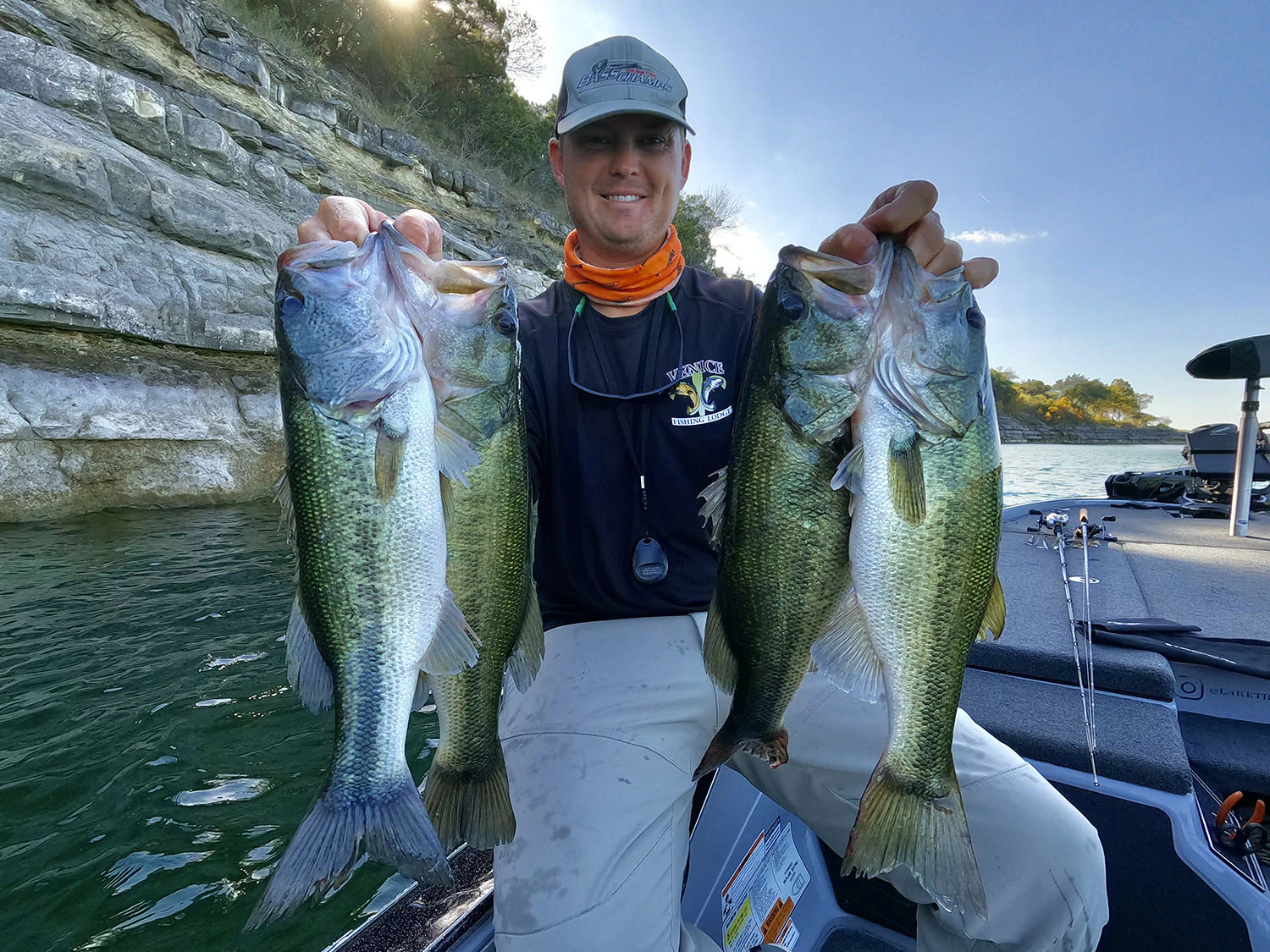
In most of the country December means winter fishing. Cold water typically means fishing reaction baits or fishing plastics and jigs super slow. While you can get bit doing some of those things at the moment, that’s not the main way I am fishing. Here in Austin, we are fortunate it doesn’t really get that cold. Right now Lake Travis is very much in a fall type pattern. So what does this mean for the bass fishing right now?
The water temperature on Lake Travis is currently around 64-66 degrees. I’ve seen it as low as 61 degrees recently though. Keep in mind that during this time of year cold fronts, rain, and wind can cause the lake temp to change more than normal. Paying attention to these factors, and especially the water temp helps me decide on where I want to be fishing. During the fall, weather plays a huge role in how I fish and what baits I tie on.
On windy overcast days, especially if the barometer is dropping from weather moving in, I like to get on main lake points and shorelines getting hit by the wind. I look for areas where bass can move to feed on bait that moves into these areas. Often times the choppier and windier the better. An Alabama rig is my go to bait for this type of situation. A jerkbait and a swimbait on an underspin head can also be very productive. Fish baits that are fast moving, throw off a lot of vibration, or have some flash to them. You are getting these fish to react to it.

On those calm days I tend to slow down a bit, however a crankbait can still be very productive. I recommend rigging up a ½ ounce jig in a brown or green pumpkin color and working banks with large rock. Make long casts to get away from your boat and target 10-25 feet of water. Fish the bait slow and really try to get a feel for the bottom. Bites will be subtle but typically they’ll feel like one light thump. Hook sets are free! Don’t be afraid to swing away. When I have clients in the boat who can cast well, I love to cover water with a medium diving crankbait. A Rapala DT-10 or a Storm Wiggle wart are two good options. Have a crawfish pattern and a shad pattern ready to go. I typically start with a brown craw color this time of year, but if I’m not getting bit on it I will quickly switch to a shad pattern.
This time of year can be very productive! Don’t let some cooler weather stop you from getting out there. Some of those days with less than ideal forecasts can be some of the best fishing! Winter is my slower season and I have more open dates. If you’ve been wanting to get out of the house and catch some fish, visit my website and book a trip!
November 2021
November is one of my favorite months to fish Lake Travis! Fall is finally here and the water temps are down into the mid 70’s and will continue to get colder with these shorter days and chillier nights. With the water cooling the bass’ metabolisms will speed up and they will get more active. This translates into catching more fish, bigger bass, and being able to throw more moving baits.
Where to Look For Bass
Largemouth Bass are going to start moving up into coves to continue feeding on baitfish. This time of year I will focus on points and ledges close to the mouth of coves. I will also start moving up further and further into the backs of coves as it cools down. As of right now, I have been doing best targeting the points at the entrance to coves and fishing as far back as about halfway into the coves. As it gets colder I will continue going further and further into the backs of coves.
The reason for this is due to the water temperature. The backs of coves will stay slightly warmer than the deep part of the main lake. This allows the plankton in the lake to bloom longer. This is the bottom of the food chain and what species like threadfin shad eat. Predator species like bass will move into the coves to follow their food source. During the fall bass eat a lot of shad, however they still continue to feed on bluegill and crawfish.
What Baits to Throw
During the fall there are several baits I always keep tied on, but to keep this short I will focus on three main baits.
Medium Diving Crankbait
A crankbait is one of my favorite ways to catch bass in the fall. You can cover water quickly, you can trigger reaction baits by choosing a bait that will bump into the rocks on the bottom, and the come in tons of realistic colors. I mostly stick to crawfish patters, browns, oranges, and reds are all very good colors. Shad patterns work well too, but something about a crawfish colored crankbait bumping along the bottom kicking up sand and silt just triggers those bass into biting. A Storm Wiggle Wart in brown craw is one of my favorite baits, but there are tons of great options out there. A Rapala DT10 is another very good option that most sporting goods stores offer. Choose a bait that will dive to 10-12 feet and fish it along rocky shorelines with drop offs along them. Run the bait more parallel to the shoreline and try to get it to grind the bottom. When fishing it I prefer a medium speed retrieve but I stop and start the bait a lot as well as very the retrieve by speeding up and slowing it down often… keep the retrieve erratic and avoid just reeling it in over and over again at the same speed.
https://www.youtube.com/watch?v=CgP4t5LSesM
The link above is a great video I filmed last year teaching you how to fish a crankbait this way.
Football Jig
During the fall, crawfish become a large part of a bass’ diet. Lake Travis is mostly rock and has a healthy population of crawfish in it. Texas rigged craw style plastics work well too, but a personal preference of mine is a jig. Football jigs and finesse jigs with a craw style trailer work very well and tend to draw larger bites. I stick with a ½ ounce football jig in very natural colors. A jig with a light brown skirt with some orange or red it in works very well… think natural! Fish that jig along rocky banks and over rocky veins along the shoreline. Slow down and don’t over work it. Too often I see clients fishing the jig very fast, lifting it off the bottom quickly and practically swimming it back to the boat. Make sure you can feel the bottom, maintain that contact with the rock, and give it plenty of pauses. A slower retrieve gets more bites in my opinion. I prefer a ½ ounce football jig most of the time, but on days with no wind and high barometric pressure I go to a round ball 3/8th ounce finesse jig in the same color.
Swimbait
A small swimbait is another bait that works year around on Lake Travis, but especially excels in the fall. Keitech is my brand of choice, but there are lots of other good options. I stick with a 3.8 fat swing impact of a 4 inch Easy Shiner in shad colors. Keitech makes a ton of excellent colors, so stick with something that looks like a baitfish. Most of the time I fish this bait on a ¼ or 3/8th ounce lead head. On cloudy days or when the fish are being finicky and I just want to try something different I change to an underspin. An underspin is just a swimbait lead head that has a small willow blade attached to the bottom of it. It throws off more flash and vibration and at times can make a big difference. Fish these baits with a medium speed retrieve and a steady wind. Make long casts up forward of your boat and get close to the shoreline. These baits and rocks don’t mix, so do not let it hit the bottom. However, you want to let it sink and try to follow the bottom contour keeping it a few feet up off the rocks. When fishing steep banks, I will sometimes pause and take the reel out of gear halfway back during the retrieve. Let it take line and sink out to help it get deeper. During the fall the fish move shallower, but keep in mind on Travis “shallow” is a relative term. Fish live deep on this lake all year, so catching them in 20 feet of water right now is not uncommon at all.
Fishing has been getting good and will only get better until it gets really cold! I am pretty booked up this week and part of next, but I have openings after that! If you would like to get out on the water or learn how to fish the lake more effectively give me a call or book online via my website!
September 2021

With the end of summer approaching the patterns us anglers are focusing on will start to change. The water temperatures will remain warm for a while longer, but as the summer drags on, the bass’ internal clock tells them fall is approaching. September is typically a transition month here in the south. Some fish will stay out deep offshore in their typical summertime homes, while others will make a transition and move. When fishing this time of year there are two main patterns I recommend you focus on, deep offshore fish and shallow structure oriented fish.
As I have said many times before, water temperature is the biggest factor affecting how fish behave. As long as the water remains hot, a portion of the bass population will remain out deep in search of cooler more comfortable water. I recommend fishing deep secondary points, ledges, and the middle of creek channels. During this time of year I rely heavily on electronics to help me find the fish and not waste time fishing empty water.
Once you have located an area with fish, I recommend either fishing very very slow, or rather quickly. You are trying to trigger a fish into naturally feeding, or illicit a reaction strike from a fast moving lure. Football jigs, Texas rigged stick baits, and drop shots are some of my go-to baits to fish this way. All of these baits can be fished deep effectively yet slowed down to maintain bottom contact. Long casts, subtle movements of the bait, and lots of pauses work well when fishing this way. Change baits often and rotate through your arsenal of lures to draw bites. Generally offshore fish tend to be sluggish and not active feeders. They will eat though if something easy to catch goes past their face. Once you get a bite, take advantage of the feeding frenzy it can often trigger. Get your casts back in there ASAP as its not uncommon to hook another fish when you get one from the school to bite.
If the slow presentation won’t draw a bite, switch baits to something fast moving. A deep crankbait, a fluke on a heavy scrounger head, or a Biffle bug on a swinging jig head fished on the bottom can work well. These baits stay deep where the fish are, but will make bottom contact while moving to try and draw a reaction strike.
The second pattern I recommend is focusing on structure. During the late summer some fish will move up shallower and will orient around isolated structure. Brush piles, rock piles, docks, staircases, etc. are all structure I find bass on. Make sure you are getting your casts very close to the structure, the closer the more bites you will get! A Texas rigged curl tail worm, a wacky rigged senko, and a flipping jig are all baits I like throwing around this kind of cover. Repeated casts to high percentage targets, fishing quick, and rotating baits often will also help get you more bites.
As fall gets closer the topwater and crankbait bite will also improve. That is still a little ways off with as hot as it’s been. For now, focus on these patterns to put more fish in the boat!
Unlike some fishing guides, I offer what I call a “coaching trip”. For these trips the focus of the trip is to teach you to be successful on your own. We will cover patterning bass, understanding the current conditions, what baits to throw and why, where to look for bass deepening on seasonality, and so much more! Feel free to reach out to me !
August 2021

The dog days of summer are here and it’s hot out! With these hot temperatures naturally comes warmer water temps, which is one of the number one things to affect fish and how the behave. Numerous things affect bass behavior, but water temperature affects the metabolism and how active/ inactive they will be. This is why times of year like the spring are notorious for great fishing. During the winter they fish slow down due to cold water, then fire back up as it warms in the Spring. Right now you have the opposite affect going on. Summer has the water very warm, as of late around 85-87 degrees, which also slows the bass down. Once Fall arrives the fishing will fire back up again since the water will cool again.
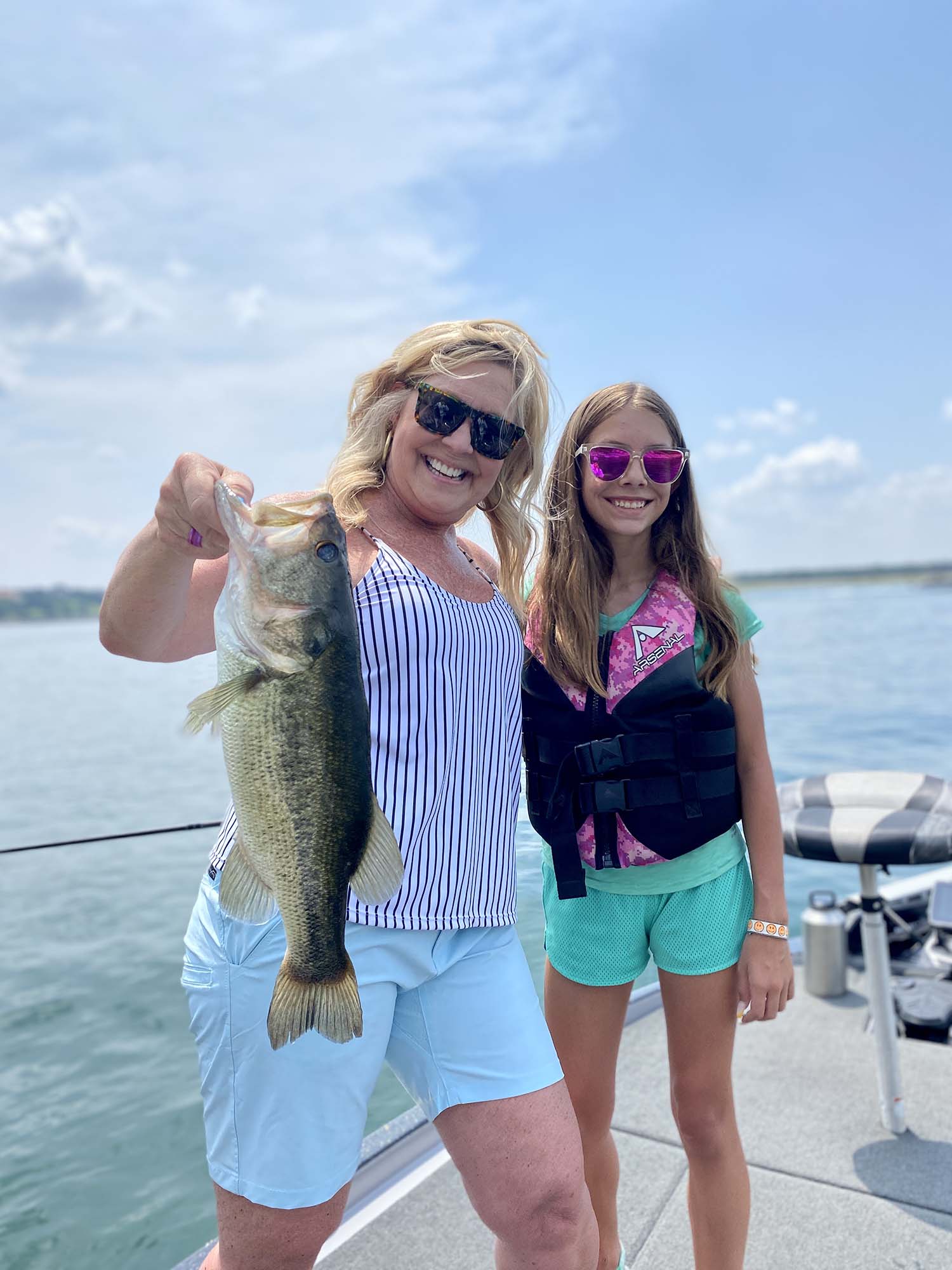
So what does this mean for bass fishing and how to target them? Fish Deep! Bass will move offshore or away from the bank to find cooler water further down in the water column. Lately I have been finding a lot of fish in that 20-40 foot depth range. Points, bluff walls, and offshore structure such as rock piles or brush piles can be especially good. During this time of year I rely a lot on my fish finders to help me locate these offshore schools of bass.

Once you have found some fish, or pulled up on your favorite spot, there are a couple baits I recommend you have tied on. A Carolina rig, a drop shot, a deep crankbait, and a heavy Texas rig are all essentials this time of year. When I find fish out deep I pay attention to how they are positioned on the fish finder to help me decide what bait to throw. If they are higher up off the bottom, the deep crank can work well to get the school fired up. Do not expect to get bit on your first cast by any means. These offshore fish tend to be lethargic and it can sometimes take a lot of work to get them fired up and chewing. Once you catch one, get back in there quick with a follow up cast as you can often trigger a feeding frenzy. These feeding windows are often short lived, so don’t waste time taking selfies, measuring the fish, or Face Timing your fishing buddies, get back to fishing!

If the bass you are targeting are not getting fired up with the fast moving bait, slow down. A slow dragging presentation with the Carolina rig or subtle twitches with the drop shot can be very enticing to a bass. Small movements, long pauses, and constant bottom contact are key. A trick worm in Green Pumpkin or Red Bug is an excellent soft plastic to throw this time of year. It is subtler moving, as they don’t have lots of appendages flapping around. For the Texas rig I recommend a senko rigged on a small tungsten bullet weight. Go with as light of a weight as you can and still feel the bottom. The slow fall of the bait can often get you bit.
Early in the mornings there is still a marina bite to be had. If you are out there early either fishing from your boat, or at your marina getting ready for a fun lake weekend, have a rod at the ready rigged up with a small 3” swimbait… smaller the better. Lately I have found more success downsizing my swimbait selection to mimic the little threadfin shad the bass have been feeding on. Keitech is typically my favorite brand, but any small paddle tail swimbait in a shad color will work. The key to getting bit though is a well-placed cast. If you see fishing jumping you need to be quick and accurate. Cast right on top of them when they are boiling on the surface. If you are too slow they will go back down deep and never see your swimbait. If you are not seeing fish busting on bait, get your casts close to structure such as the sides of docks or behind boats. Look for places you could imagine a bass concealing themselves in preparation to ambush a baitfish.
While the bite this time of year can be a little more hit or miss, if you put in the work you can still have some very rewarding days on the water!
Fall is just around the corner and I am already starting to get bookings that far out! Historically some of the biggest bags I have caught on Lake Travis have been in the fall, so don’t be afraid to book in advance if you don’t have a flexible schedule and want a certain date! Check me out online at www.torwicksguidingservice.com
Tight Lines!
July 2021
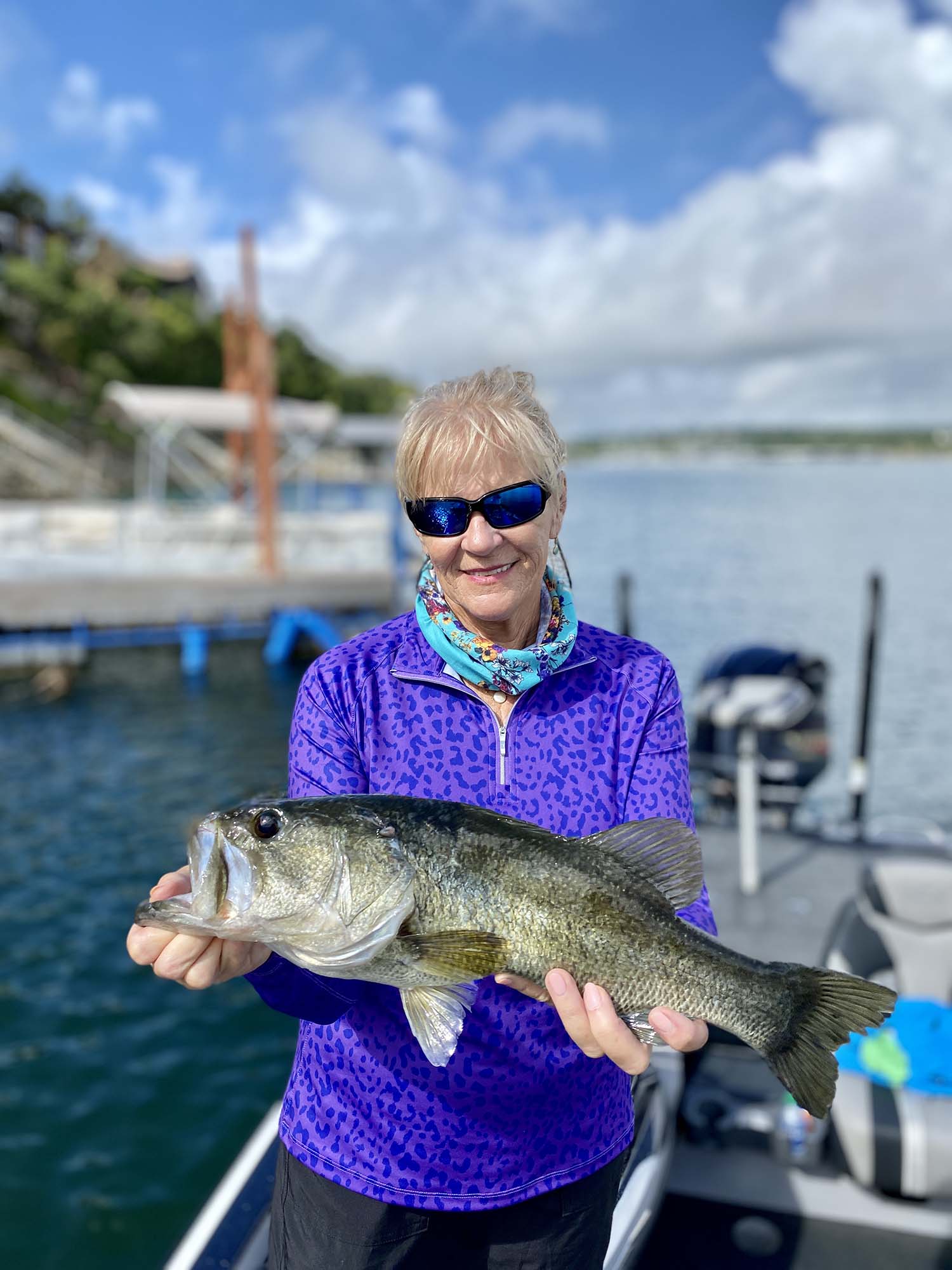
It’s hot out, but so is the bite on Lake Travis right now! Water temps on Lake Travis are in the mid 80’s currently and will continue to rise as summer progresses. Water clarity is typical Travis conditions, gin clear on the lower end of the lake and a bit more stained the further up the river you go.
With this heat and warm water, the bass have been moving around and a couple new patterns are working well. Summertime fishing can be hit or miss for a lot of anglers, but I promise you, if you put in the time and learn how bass behave and why certain conditions make them behave a certain way, you will be more successful.
Early in the mornings bass relate to marinas heavily on Lake Travis. Not all marinas are created equal, but certain ones are holding large schools of baitfish, which attracts predator fish such as largemouth bass and white bass. Look for fish busting on the surface to give away their location. Live view forward facing sonar such as Garmin Panoptix has been vital to catching these fish when they are on the move chasing bait. Small swimbaits and spoons that imitate the threadfin shad they are feeding on work well to trick them into biting. Quick, accurate casts into the schools of bass hitting the surface are key to getting bit. If you can hit the fish on the head with your bait right after they jump, you will get bit almost every time. As soon as the bass catch the shad they are after they go back down 10-15 feet deep, so being fast to cast is critical.
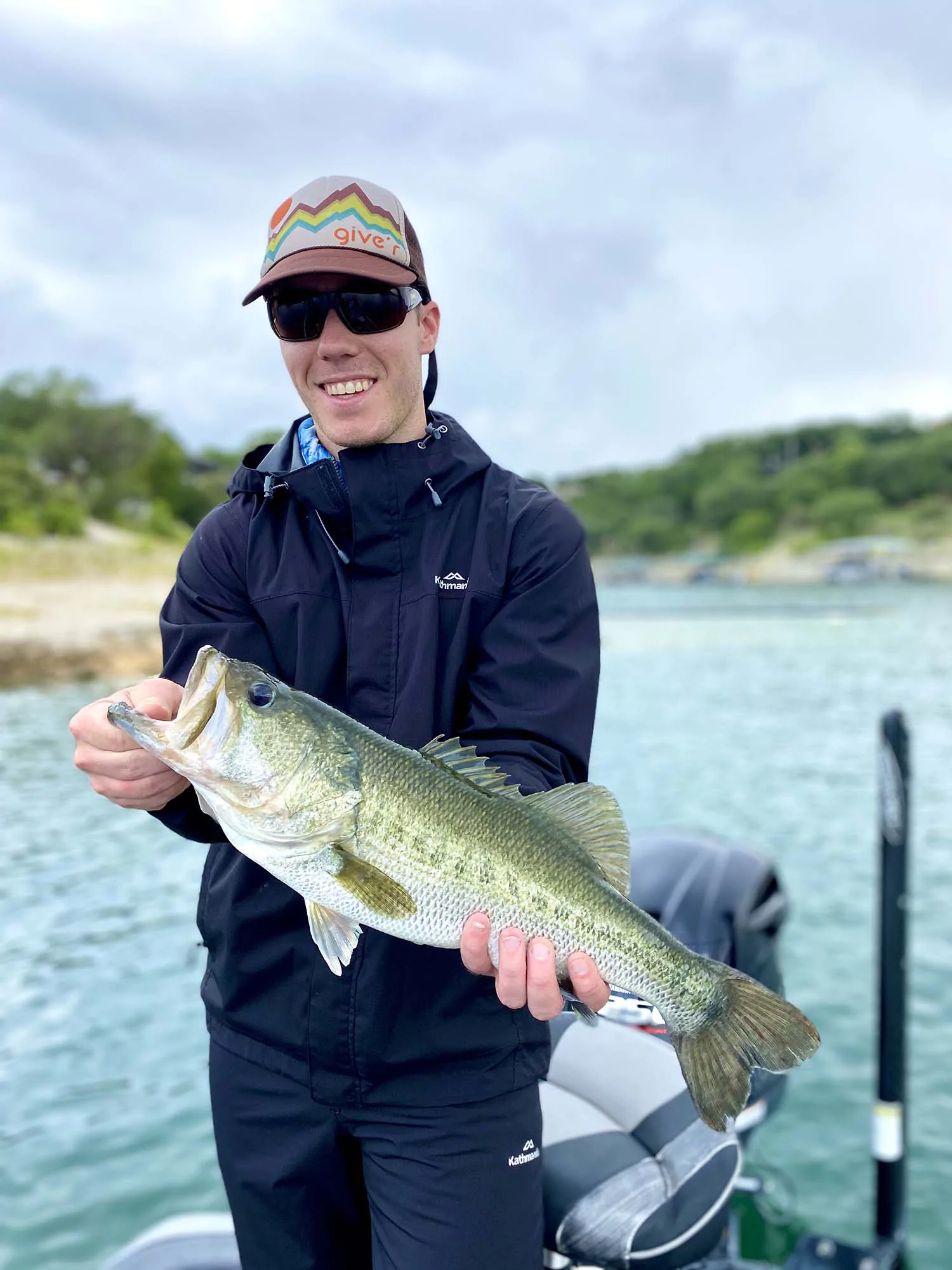
Deep boat docks on the main lake will also hold suspended fish this time of year. A wacky rigged worm on a 1/0 weighted wacky hook fished as close to the sides of the docks as possible is a good way to catch these lethargic suspended fish. I tend to find them suspended 10-20 feet under the docks in the shade. Be patient and make sure to let you worm float down to that depth before slowly twitching it back to the surface. Watermelon and Green Pumpkin have been the best colors lately with the water being so clear.
Lastly, fishing offshore bottom contours such as secondary points, ledges, and creek channel drop offs are good places to look for fish. Not every deep spot like this is loaded with fish, but when you find the right one they can be loaded. I have been using my electronics lately to graph for these fish, and have found schools as big as 40+ fish. Getting them to fire up and bite can be tough at times. When they move offshore they usually are not super active even though they are schooled up. A deep crankbait and a Carolina rig with a fluke are two things I like to throw through the schools to fire them up. Hit them with a fast moving reaction bait, they follow up with a more subtle plastic. These fish will move on you when you find them, so if you don’t get bit after 10 minutes of fishing, graph them again. They typically don’t go far, maybe only a few hundred feet away, but if your casts are not through the middle of the school you won’t get bit.
This time of year can hold some very good fishing! Come on out and book a trip. Some clients opt to take a lunch break midday and stop at one of the many great restaurants on the lake. Bring your swimsuit and jump in the lake to cool off before getting back to fishing! All fishing trips include rods, reels, tackle, and a cooler of cold bottled waters. Don’t let the heat stop you from booking a trip and getting out on the lake with me this month!
June 2021
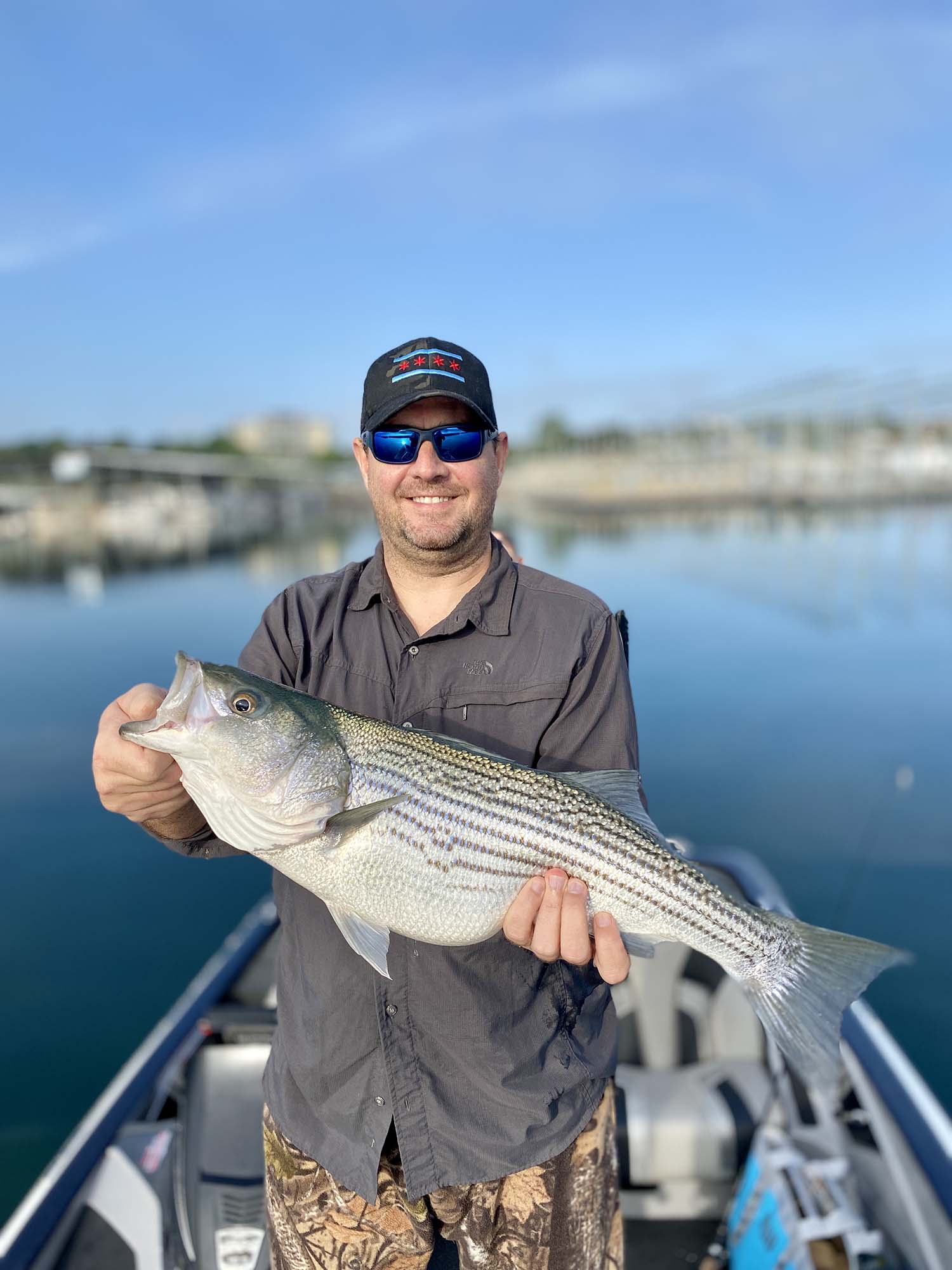
The bass fishing on Lake Travis continues to be good! With summer approaching the water temps are in the mid 70’s and rising. Water clarity is great as always; expect to find visibility 5-10 feet on the lower end of the lake, and slightly less as you get further up river, especially past the split. With all the recent rain expect some areas to be slightly more stained and more debris in the water. This generally clears up pretty quickly though. As water temperatures increase, you will find a change in the fish’s behavior. There are a couple key patterns that I recommend you try.
Mornings
Early in the morning I like to start out looking for schooling fish or throwing a topwater bait. The tail end of the shad spawn is still going on, so pay attention to the shorelines early in the morning for signs of this. If you are not seeing any baitfish activity, keep moving. A topwater plug such as a bone colored spook, or a pop-r in chrome or a baitfish pattern are good options. Personally I love throwing topwater since it is so much fun seeing the fish hit it on the surface! To cover water more quickly a paddle tail swimbait such as a 4.2 Keitech Fat Swing Impact rigged with a belly weighted hook can be deadly. I recommend this style hook as opposed to a lead head in order to prevent snags. The fish will move up shallow early in the mornings. With the lake having risen recently due to the rain, there are a lot of weeds on the edge of the lake. To prevent snagging those I like this way of rigging my swimbaits.
As for schooling fish, certain deep water marinas on the lake have been holding large schools of largemouth and white bass. You can find them hitting the surface on and off, live sonar such as Garmin’s Pantopix is also very useful to find these fish. A small spoon or swimbait works well to target these fish. If you find them jumping, get your cast as close to the fish as possible as quick as you can.
Mid Day
Once the sun comes up and the morning bite slows, I like to back off the bank. Steep shorelines that bottom out before going to the river/ creek channel, ledges, and points have all been great places to look for bass. As they leave their post spawn homes, the bass will begin moving deeper and relating to steeper bluffs. Areas with a lot of rock attract the fish as it provides habitat as well as hold forage they feed on.
Ned rigs and drop shots are a staple on Lake Travis. These two baits are perfect for putting numbers in the boat. If I am targeting a little better grade of fish, I like to throw a Texas rigged senko. For these baits stick to natural colors like green pumpkin or watermelon. Fish slow and really pay attention to the feel of the bait hitting the bottom. The bites can be very very subtle.
Evenings
The evening bite has been very good. I fish it kind of as a combination of how I fish the morning and mid day bite. Fish will move up shallow again to feed so moving baits like topwater and crankbaits can be productive. You will also find a population of fish that stays out deep, even when its getting closer to sunset. Shallow areas near deep water are especially good places to look as this is the first place fish will move out of that deeper water to in order to hunt for food.
Towards the end of this month I would expect more and more fish to be pulling offshore. I have been catching fish out deep on deep diving crankbaits, and as the water gets even hotter, more fish will begin that migration.
If you are visiting the area, want to try your hand at fishing Lake Travis, or want to book a coaching trip to get better at fishing, I would love to take you! Torwick’s Guiding Service is a full time licensed and insured fishing charter and specializing in guiding on Lake Travis.
May 2021
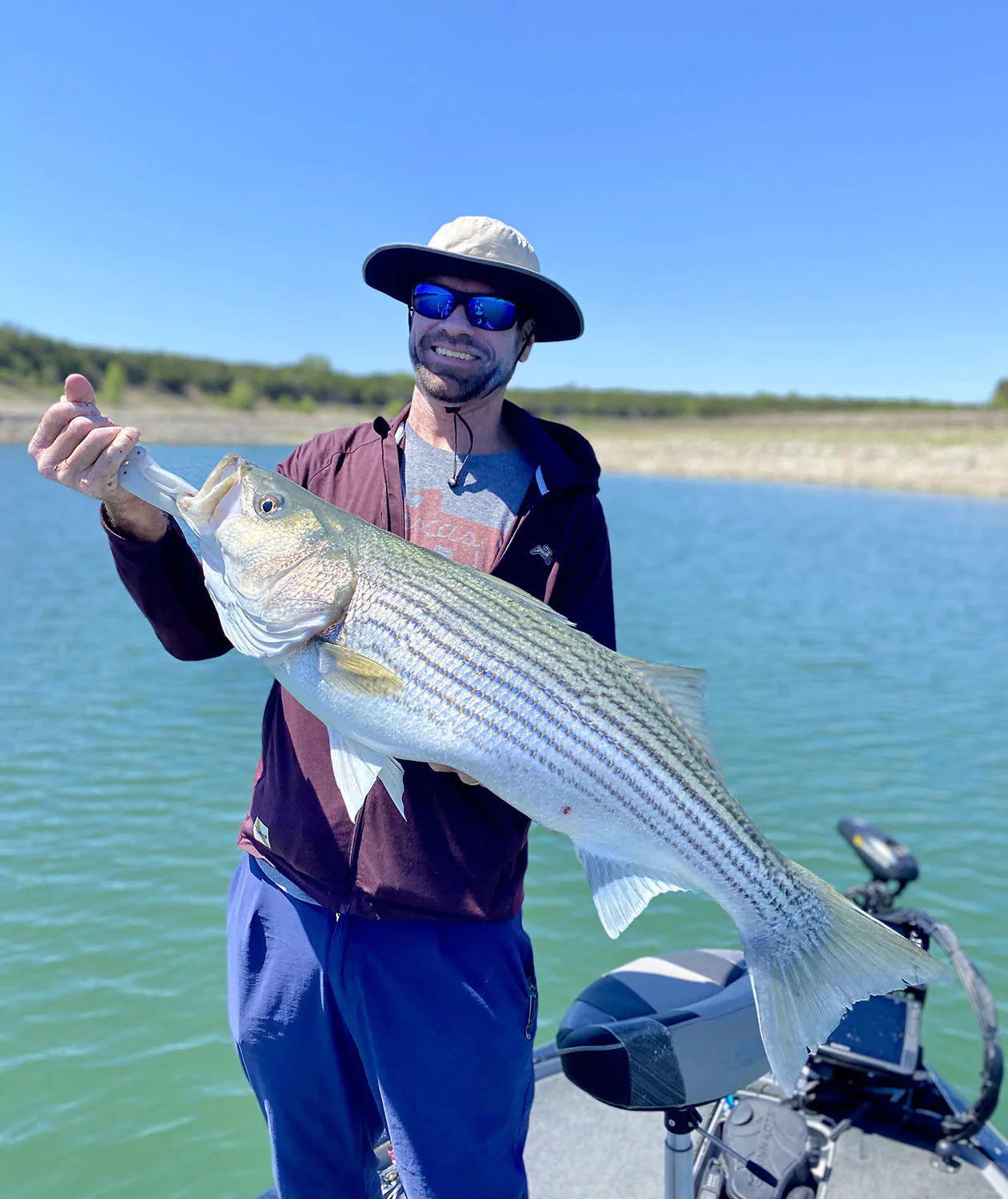
The bite on Lake Travis has been great and will only get better for the next month! Water clarity is the typical Travis gin clear water; 8-12 foot visibility on the lower end of the lake is pretty normal. Water temperatures are currently between 67-69 degrees, but with temps forecasted in the 80’s all next week I expect to see temps finally get over 70. Seventy is a magical number on Lake Travis as that is the temperature needed for the shad to begin their spawn.
The shad spawn on Lake Travis is one of the best bites of the year in my opinion. Largemouth bass love eating shad, Threadfin shad is like candy to them! These small baitfish move in schools and will move to docks, marinas, and windy blown rocky shorelines to lay their eggs in the algae that grows on the rocks. Topwater baits such as pop-r’s and spooks in bone or chrome are very fun baits to throw early in the morning. Small spoons and little swimbaits are two of my other go-to baits bait when trying to mimic shad. Fish these baits tight to cover or as close to the docks as you can cast. On the upper end of Lake Travis where the water is more stained and there is a little more brush in the water, a white swimjig or chatterbait is another lure I like throwing.
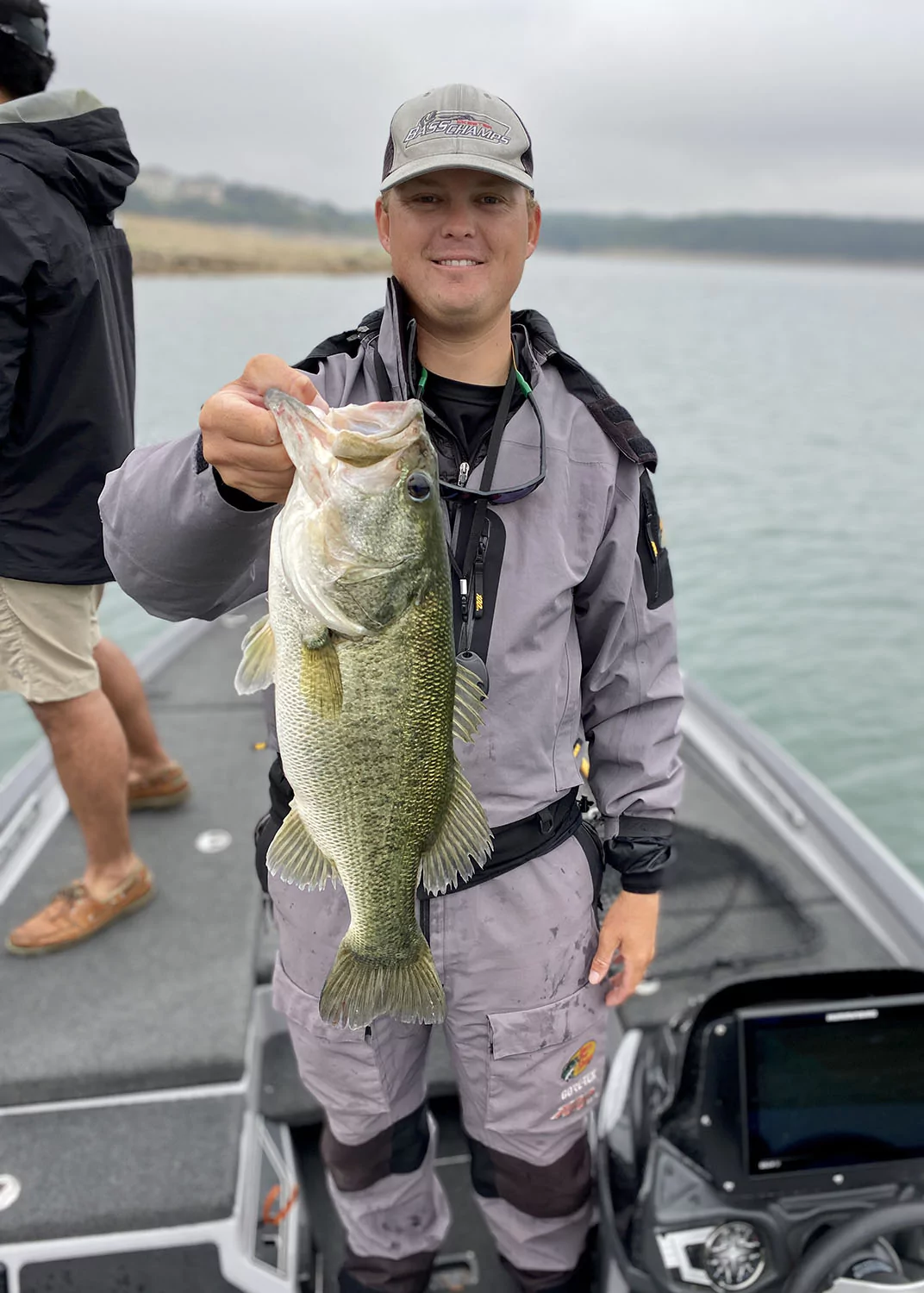
Currently with the water still just below that temperature needed for the shad to spawn, the bass in Lake Travis are post-spawn. I recommend targeting the mouths of spawning coves. Main lake points, drains just inside large coves, and small ledges are all places these fish will move to after spawning. A Ned rig and a Texas rigged creature bait are both baits that have been putting a lot of fish in the boat for me. With the water being so clear, stick to natural colors like green pumpkin and watermelon. On windy days I like to pick up a crankbait or a jerkbait and cover water. Once I find the fish I like to slow down and pick the area apart with a slower moving bait, then go back to the moving baits.
I have a couple dates still open in May so don’t procrastinate! Check out my website and book now!
In addition to your normal guided fishing trips, I also offer what I call my “Coaching Trips”. These are trips geared towards teaching you how to fish Lake Travis and not just running you to my honey holes. We will approach the day almost as if we were practicing for a tournament. We’ll go over understanding seasonal patterns, how to establish a pattern, and how to understand how it positions the bass and where to look for them. We will also cover bait selection, colors I like to throw, how to rig your gear, but most importantly the “why” behind all of that. I also offer electronics coaching and will round out the last hour of the trip going over how to more effectively use your graphs. If you fish Lake Travis but struggle to consistently catch fish, consider booking me for a coaching trip… I encourage you to Google my guide service, as I am confident my online reviews will speak for themselves!
I also encourage you to follow me on Instagram @LakeTravisFishingGuide I post daily on there with tons of great Lake Travis fishing content!
April 2021
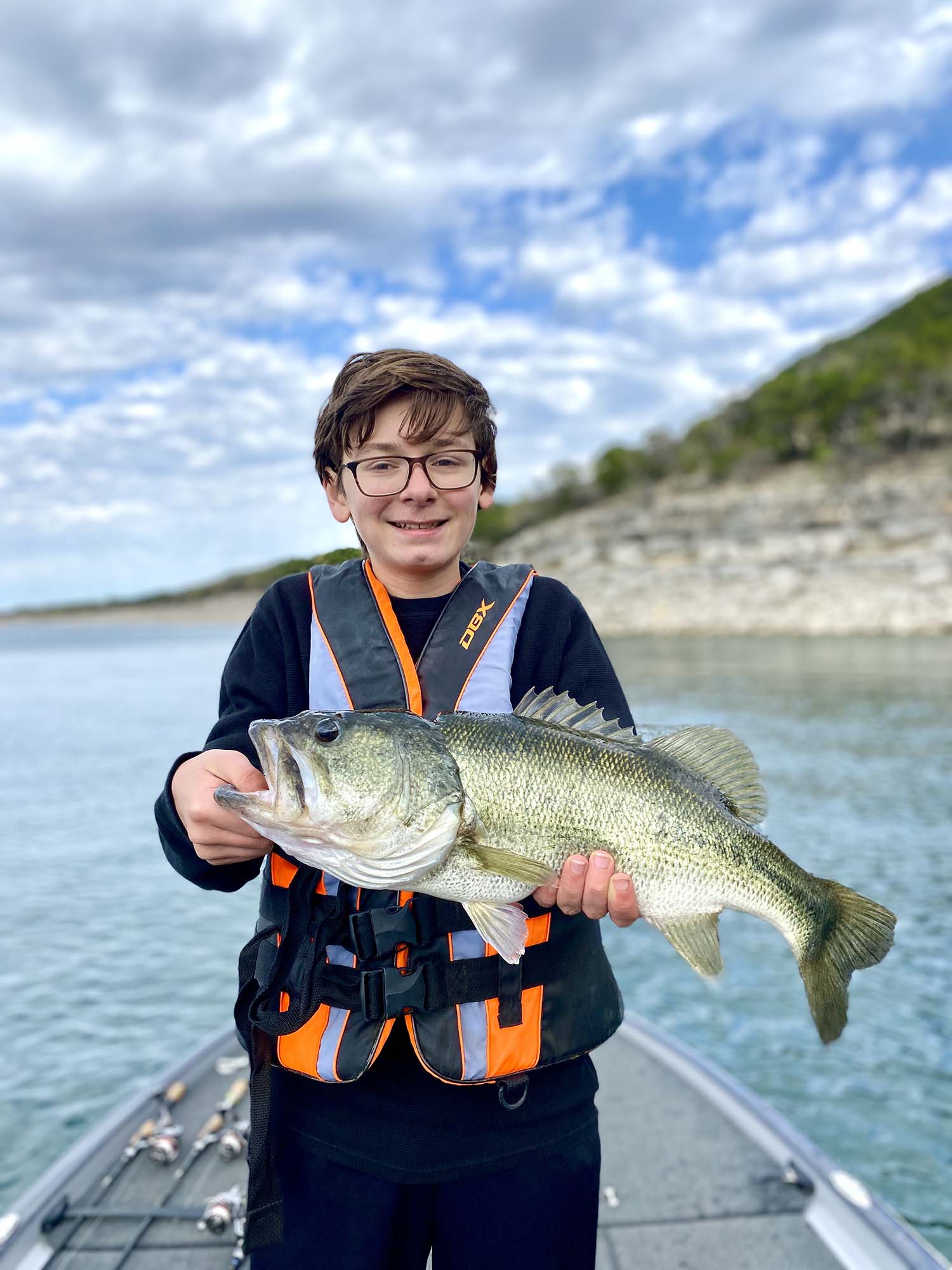
The bass fishing on Lake Travis has been great, and will only continue to get better throughout April! As the water warms up the bass become more active and begin to feed more and more. Currently water temps are around 60 degrees on the main lake, up to 64 degrees in the backs of coves. Of course, this fluctuates if it’s a hot sunny day, or if it’s early in the morning right after a cold night. Pay attention to the water temp where you are fishing as this can help you decide how you should be fishing. Water clarity is the typical gin clear Lake Travis. I have seen water clarity as good at 12 feet on the lower end. If you luck out and get on the lake when there is little wind, bed fishing is a blast since you can see the fish very easily.
Currently there are three patterns that I am focusing on to catch the majority of our fish. Let’s break down these three patterns and discuss them a bit.
Spawning Fish
Currently the bass are spawning on Lake Travis. With water temps in the low 60’s this is the prime time of year if you want to sight fish for Largemouth on beds. I love this type of fishing, but don’t always get to do a ton of it. When guiding I want everyone to have fun and be fishing. When fishing for bed fish one person gets to be up on the bow trying to catch the fish off the nest while I coach them, while the rest of the group gets to watch. When I get solo clients or groups with only two anglers we’ve been catching a lot of fish off beds. The bass are spawning all the way from the dam on up to Marble Falls, so it doesn’t matter what end of the lake you are fishing! When I get groups of three anglers I usually only go searching for spawning bass if they ask for it… making two people sit and watch doesn’t make for a memorable trip.
Pre-spawn Fish
The majority of the fish I have been targeting are still pre-spawn. Bass tend to spawn in waves, with fish moving up at different times throughout the spring. What this means is that your typical pre-spawn spots will reload quickly with different fish. This is especially nice as I am able to return to a spot multiple times during the week without wearing it out.
Look for points and drains close to spawning coves with deep water nearby. These are typically the first areas bass move to in order to make their way to where they’ll ultimately build a nest and spawn. The shoreline directly adjacent to these points is also a very good place to look. In particular, I look for shorelines that have small rocky drop offs, or “veins of rock” as I refer to them. Next time you are fishing a shallow sloping shoreline on Lake Travis take a look at the rocks. I guarantee you’ll notice there are small ledges made up or rock with usually 10-20 feet of gravel and small chunk rock above or below those veins of rock. There are more of these below the water line, and this is where the fish congregate. Those areas of gravel, sand, and small chunk rock don’t really provide anything for the bass. They don’t hold baitfish, they don’t provide habitat, and they are not good ambush points for the fish. Those rocky veins on the other hand provide all of that! Next time you are targeting pre-spawn fish look for these and target your casts along them. You can find these by using your side scan sonar, or even just looking on Google Earth at old satellite imagery from when the lake was low.
Medium diving crankbaits, small swimbaits, flukes, and plastics fished along the bottom are all good ways to target these fish.
Schooling Fish
During spring, one of my favorite ways to chase bass is when they are schooling. There’s nothing better to get clients excited than when the bass are literally jumping in front of you! A lot of the deep-water marinas on Lake Travis hold schools of baitfish, which attracts the bass. Oftentimes, early in the morning, you can find bass chasing shad feeding up for the day. They will usually be down deep, and once they find the shad, they push them up to the surface chasing them.
Small swimbaits, topwater lures, and jerkbaits can all be excellent baits to target these fish. This is one of the absolute best places to have Garmin Panoptix in your boat. I can’t tell you how easy this has made this type of fishing for me! In the past I would wait until the fish jumped to start casting. Once they go back down you are kind of just blind casting. Now all I have to do it pan my transducer around and tell you exactly how far away and how deep the fish are. When fishing open clear water like this I can easily see out to 80 feet away from my boat with the forward facing live sonar. If you don’t have one of these graphs yet give me a shout and I will help you get set up through Mealey Marine.
Next time you are out fishing Lake Travis give these three patterns a try! The bite has been good and will only continue to get better until about June. The bite is still good during the summer, but it’s hard to beat springtime fishing!
If this fishing report helps you, please consider sharing it on your social media! Your support helps me a ton and I greatly appreciate it!
– Torwick’s Guiding Service, Tyler Torwick
March 2021
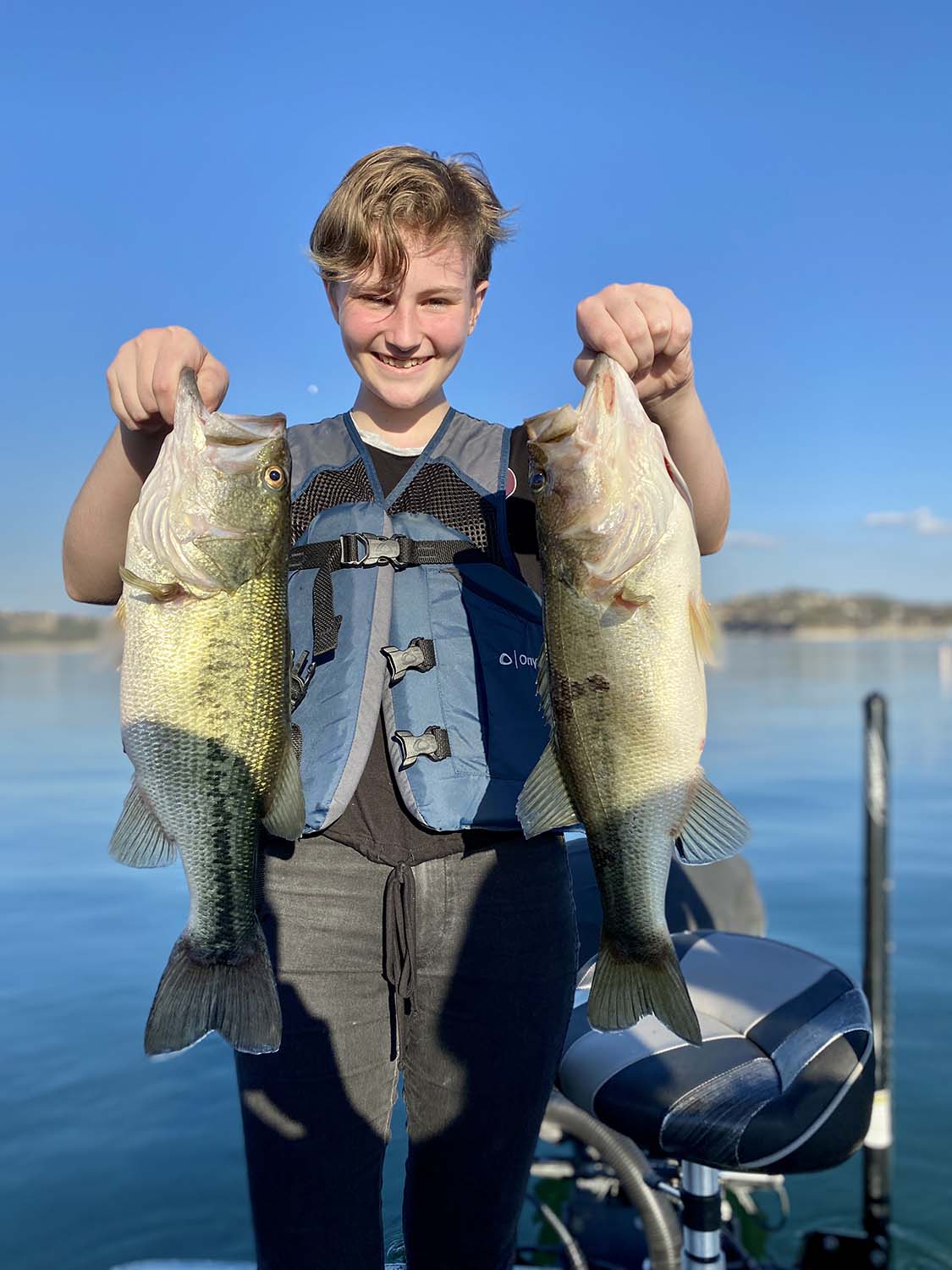
Some of the best fishing of the year is almost upon us! March is always a special month on Lake Travis as it is when a major transition in the lake occurs.
Water temps throughout the winter have been cold. This year they have been in the mid 50’s with exception of right after that last winter storm we had. As water temps warm up, largemouth bass will make a push up to the bank in preparation to spawn. This is when they move to the shallows to build a nest and lay their eggs.
Everything during the spring revolves around the water temperature. A bass’ eggs will not hatch until the water temps are in the low 60’s. Once you see water temps get above 58 degrees give or take, you will see what is referred to as “pre-spawn” behavior.
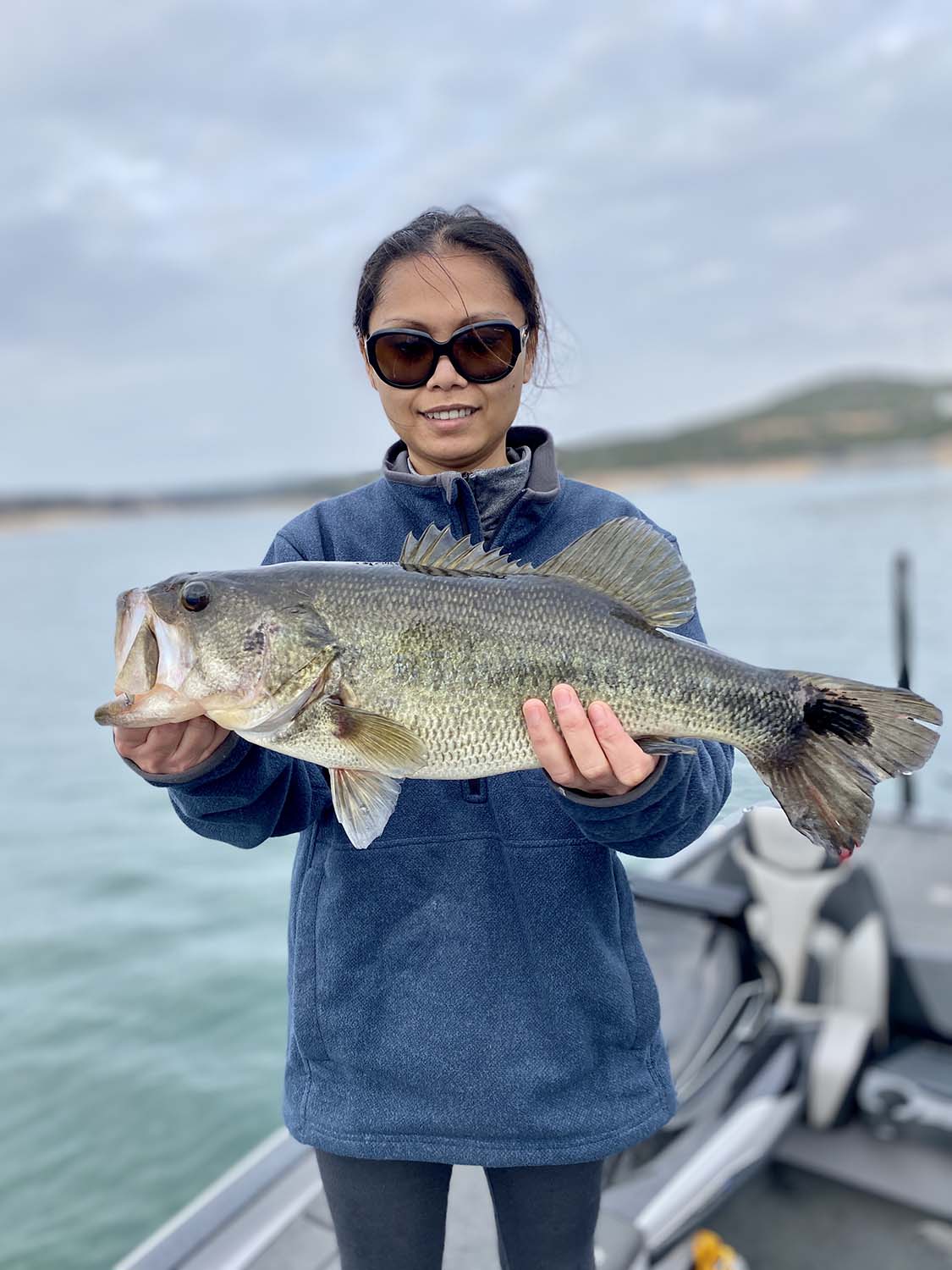
When the fish get in pre-spawn mode, I recommend looking for main lake points and the areas directly adjacent to that point. Typically the shoreline 100 yards inside and outside of the point will be the first place these fish will stage in preparation to move further back. In addition to this, cuts and secondary points close to the mouth of a spawning cove, docks, and rock piles in the same area will also hold fish.
A craw colored crankbait, a jig, or a Texas rigged plastic can all be great ways to target these fish. I will typically start with a search bait such as a crankbait, then gauge their interest in it. If I am not getting bit throwing a moving bait, I will then slow down and switch to working the bottom with one of those other baits.
Normally I see this behavior on Lake Travis in late February. With that winter storm bringing abnormally low air temps and lots of ice and snow, that has delayed this. So expect to see these pre-spawn fish over the next week or two.

Once you see the water temps get warmer here further into March the bass will commit to the spawn and they can be found up shallow. Look for coves that are protected from both boat traffic and the wind. Bass want to build their nests in places they feel safe and protected. Typically these nests will be up along the shoreline in 5 feet of water or less. Look for bright spots on the bottom where the male bass has cleared away sediment from the rock with his tail. This is where the female bass will move to in order to spawn with the male bass.
This type of fishing is all visual. You need to be wearing polarized glasses in order to bed fish effectively. When bass are on a nest they become very territorial. Try throwing a bright colored bait directly onto their nest to trigger them into striking it. I recommend a bright color such as white, bubblegum, or merthiolate as it is easy to see underwater. You are looking for the bait to disappear in their mouth rather than feel for the bite. A wacky rigged senko, a rage craw, or a jig are all good options for this type of fishing. If I may offer one suggestion… once you catch a fish off a bed, take a quick photo if you desire, but get them back into the water ASAP. These bass are there guarding their eggs, and fish like sunfish and bluegill love to eat their eggs! Getting them back into the lake as soon as possible ensures the safety of those eggs, and the future bass population of Lake Travis!
If you are interested to know more about catching bass off a nest, visit the “Article” page of my website. There is write up on there I did last year covering this… it’s a long read, but well worth it!
If you have ever considered booking a fishing trip with me, March is the month to do it! Nearly all my weekends are booked up, but I have quite a few openings mid week. (Which in my opinion is better fishing anyways due to the lake being empty) March through May are some of the best months to bass fish in Austin, so get out there on the water!
Related Links:
Lake Travis Lodging
Lake Travis Marinas
Best Lake Travis Boat Fuel Docks
Best Lake Travis Lakeside Restaurants
Best Lake Travis Parks
February 2021
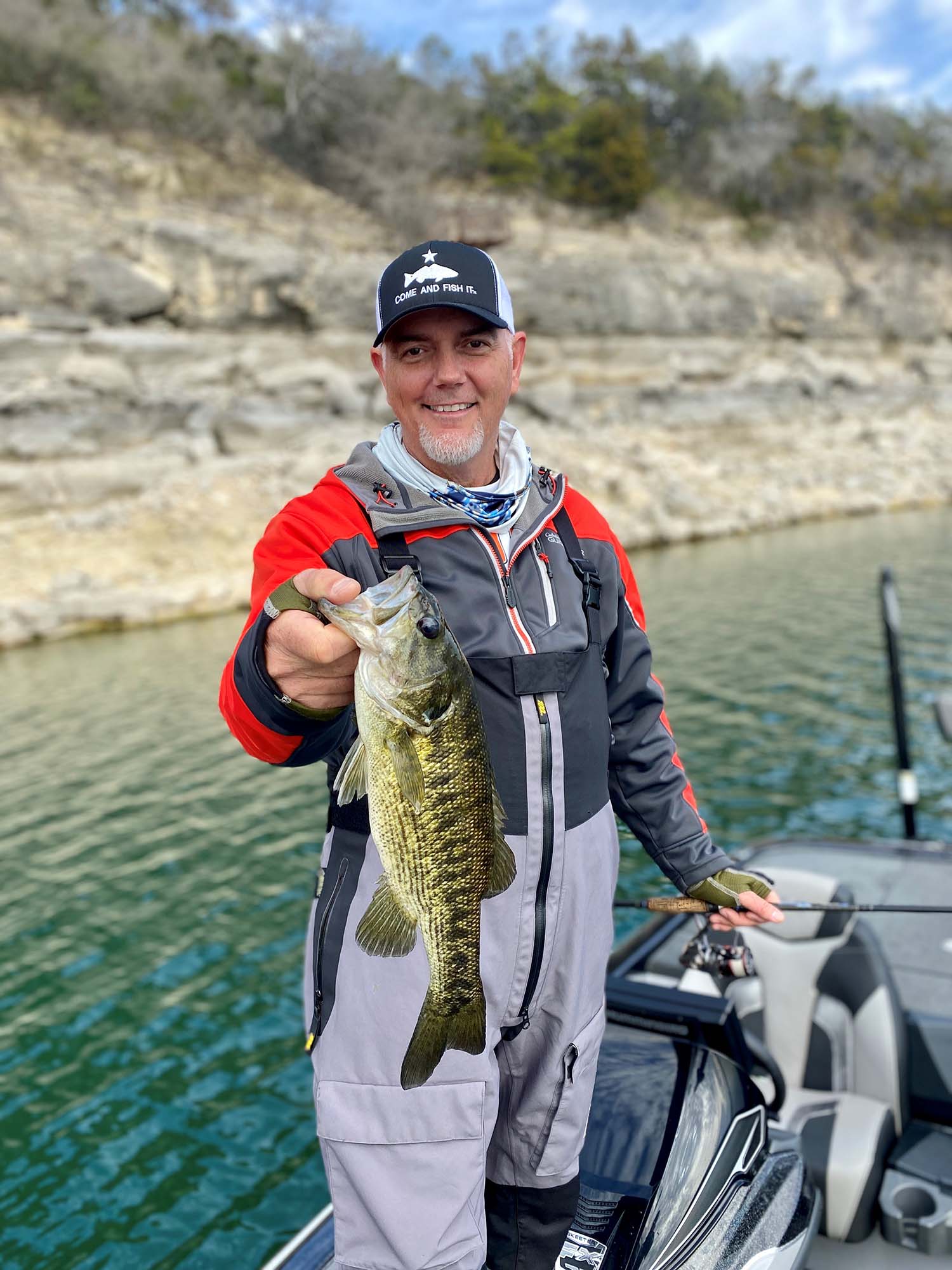
The fishing on Lake Travis has been decent as of late. The fish are still very much in a wintertime pattern, but you can still have some great days on the water! February is always a transition month on Lake Travis. What I mean by that is that the behavior and location you’ll find fish is going to change a lot throughout the month. With spring around the corner the fish are going to be on the move once you see water temperatures begin to increase. This will vary depending on weather and if we get more cold fronts. In this report we’ll discuss both what the fish are currently doing as well as what they will be doing.

As I mentioned earlier the bass are very much in their typical winter time pattern right now. With that said, I would expect to see pre-spawn fish getting active within a week or two unless a cold front comes through. Water temps today were up to 55 degrees in the afternoon. Once you see water 59 degrees or higher you can expect a change in the bass’ behavior. Things are getting ready to bust loose!

If you read my last report I mentioned deep and slow being the key. That still is the most consistent pattern for me, with a few exceptions, which we will get too. Small baits fished deep and around docks is a consistent pattern on Travis during the colder months. Today that was really the key for us, especially fishing isolated docks.
A little tip for you guys… docks can be very good places to find bass, but especially when they are isolated docks. What I mean by this is when you find a stretch of shoreline where there is only one dock on it, that will be a hot spot. If the fish want structure or shade, that is where they are forced to go. This also applies to the first dock in a row of docks when you enter a large cove. Generally the very first dock, closest to the mouth of the cove will be the best. Keep this in mind the next time you are fishing docks!
On Lake Travis there is an abundance of bluff walls. These hold fish almost year round. Obviously there are times these aren’t the best places to be fishing, but for a lot of the year, especially times when fish favor deep water, these can be the ticket. Lately I have been fishing certain areas of the lake following this pattern, targeting bass anywhere between 15-40 feet deep. Slowing down your retrieve, especially on calm sunny days can be the key. There are a variety of baits I throw but especially jigs, dropshots, ned rigs, and neko rigs. Natural colors like green pumpkin have been best, however add some orange to whatever bait you are fishing. I had several bass spit up bright orange crawfish last week. Orange Spike-It dye is a must have in your boat for dipping your soft plastics in. If you don’t have any of that try using red, they carry it at Academy around here. Finding where there are ledges and drop offs along these bluff walls has been one of the best ways to target these fish.
January 2021

Winter is definitely here and the fish in Lake Travis know it too! Expect to see water temperatures anywhere from the low 60’s to the mid 50’s. Water clarity in the winter is usually very good, so on the lower end of Lake Travis don’t be surprised if you see visibility in excess of 10 feet. With this colder water you can expect the bass in Lake Travis to be a little more lethargic and tougher to catch.
Water temperature is by far one of the largest factors that influence how the bass behave and what they do. Water temperature affects dissolved oxygen levels in the lake, where the baitfish live, and the slowing of the bass’ metabolism.
Largemouth bass are cold blooded and as the fish get colder their metabolisms slow causing them to be more lethargic. This isn’t to say they won’t feed, but they do become more selective and less aggressive. You will notice fish become more aggressive during brief feeding windows rather than feeding all day long.
This year I am making an effort to produce more videos for y’all! Please check out my most recent video on fishing Lake Travis in the winter. In this video I cover my top 5 baits to have tied on.
When the fish are like this I approach them in two ways. Either I fish very slow, or I fish very fast. Jigs, ned rigs, drop shots, and Texas rigs are all good ways to present a bait slowly along the bottom to entice that feeding bite. During the winter I will pause my bait a lot longer than I normally would. Its not uncommon for me to let my bait sit there for 5 to 10 seconds before moving it. One, this helps maintain bottom contact, and two it makes the bait easier for the fish to catch up too. During winter I often fish deep, which on Travis can be 30-45 feet of water. For some anglers this can make staying on the bottom a little tougher, this long pause helps over come this.
For largemouth bass winter time is about survival. Their goal is to expend as little energy as possible, burn as few calories as they have to, yet still feed. A slow moving bait paused on the bottom makes for an easy meal. Another little tip for you to go along with this… if they bite is tough when you are out on the water, try downsizing baits. This is where the ned rig and the drop shot come into play. These small easy to eat morsels are perfect for finicky bass.
As I mentioned earlier, you can also catch bass fishing fast this time of year. Bass are instinctive creatures and will hit a fast moving bait not because they are hungry but because its in their DNA. This bite is referred to as a reaction bite. When I find fish on the graph, especially if they are suspended this is how I like to try and catch them first. A Picasso School-E rig is my favorite Alabama rig to throw this time of year. A crankbait and a jerkbait are also in my top baits. Crankbaits are excellent search baits to cover a lot of water. My video covers a lot of great info about selecting a crankbait during the winter, so let’s skip to a jerkbait.
If you need a refresher, here is a video I filmed last year with a lot of details about how to fish this bait. Give it a watch!
Spring is right around the corner! This is by far the best time of year to fish. I am accepting reservations now. If you want to fish on a weekend I recommend booking well in advance. My Saturday and Sunday trips book up fast!
December 2020
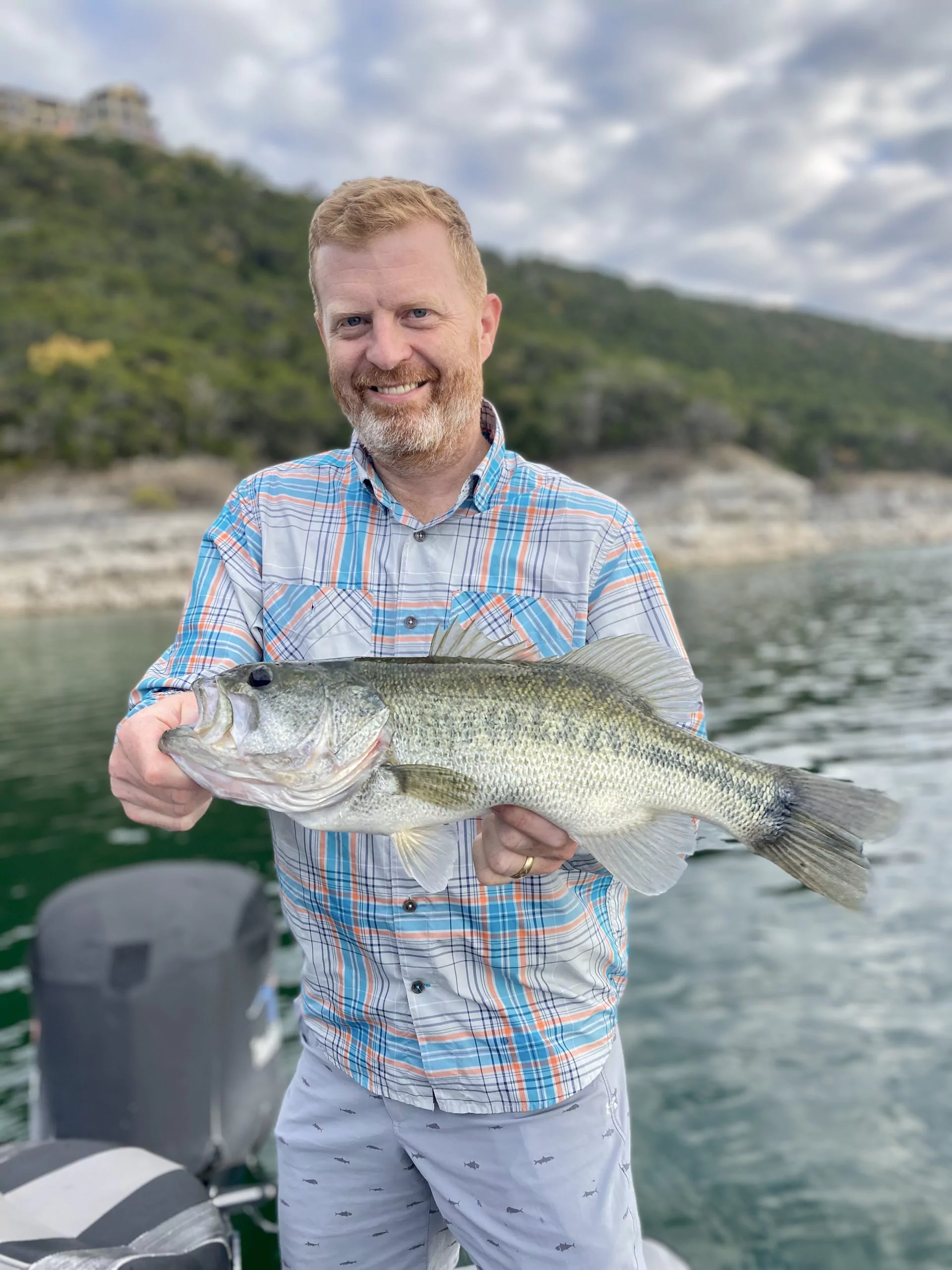
These recent cold fronts have brought colder water temps, and with it the bass in Lake Travis are changing their pattern once again. Recently I have seen water temps as low as 61 degrees first thing in the morning. Water temperature is one of the biggest factors in understanding how bass behave and where they go throughout the year.
In my previous report we discussed how the fish will move back into the coves to follow their food source of shad. Until the water gets a little colder, they will continue to do so. So expect to find fish up inside your favorite large coves. Baits such as medium diving crankbaits, Texas rigged plastics, and drop shots are all good options to target these fish. With the lake level so low, there is very little isolated cover in the lake such as brush or trees. When the water is low I focus more on man-made structures such as docks, staircases into the lake, concrete walkways, etc. As more and more fish move up to the banks in these coves, looking for cover to cast at is key.
There is also another population of fish that shouldn’t be overlooked. That is the fish that make their home on the main lake. There are seasonal patterns to every lake, but not all fish make a migration to those textbook spots at the same time, or at all for that matter. Coves will be an important place to look for the next few weeks until winter really sets in. However, if you see me out on the lake fishing main lake spots, don’t be surprised. In fact, this past week with the very cold temps, I have been catching more fish consistently deep. I caught a bass November 30th in 61 feet of water on a drop shot!
Lake Travis has an abundance of deep points and deep ledges. These are places that I have been focusing on heavily during my guided trips as of late. During late fall and into winter it is common to find schools of bass suspended out deep off of these kinds of spots. Look for ledges and points that are close to a creek channel and you will likely find these fish. Now with that said, these fish are not easy to catch. I rely heavily on my electronics this time of year. When bass are suspended the $10,000 worth of fishing electronics I have my boat rigged up with are crucial. I recommend graphing these areas and paying attention to your 2D sonar and side scan to identify where the fish are positioned.
As of last month I have a new tool in my boat… Garmin Panoptics Livescope sonar. This sonar returns images in real time and you can literally see the fish moving on the screen. On several occasions I have watched my bait fall down the screen, watch a fish move up to it on the graph, then set the hook…. This technology is incredible. I find that when fishing these suspended fish it is an invaluable tool. I can literally pan the transducer around and see exactly where the schools have moved to in order to make a more accurate cast.
When fishing for these bass I recommend having four baits tied on, a swimbait, an Alabama rig, a jigging spoon, and a drop shot. The first two baits are my search baits when I first pull up on a ledge or point after finding the fish with the electronics. I like to keep my boat as far away as possible and make long casts with the swimbait or Alabama rig and run it right through the middle of those schools of bass. When graphing for them make note of the depth you are seeing them at, it is common to find them fairly deep, which means you will need to give your bait plenty of time to sink to the depths they are at.
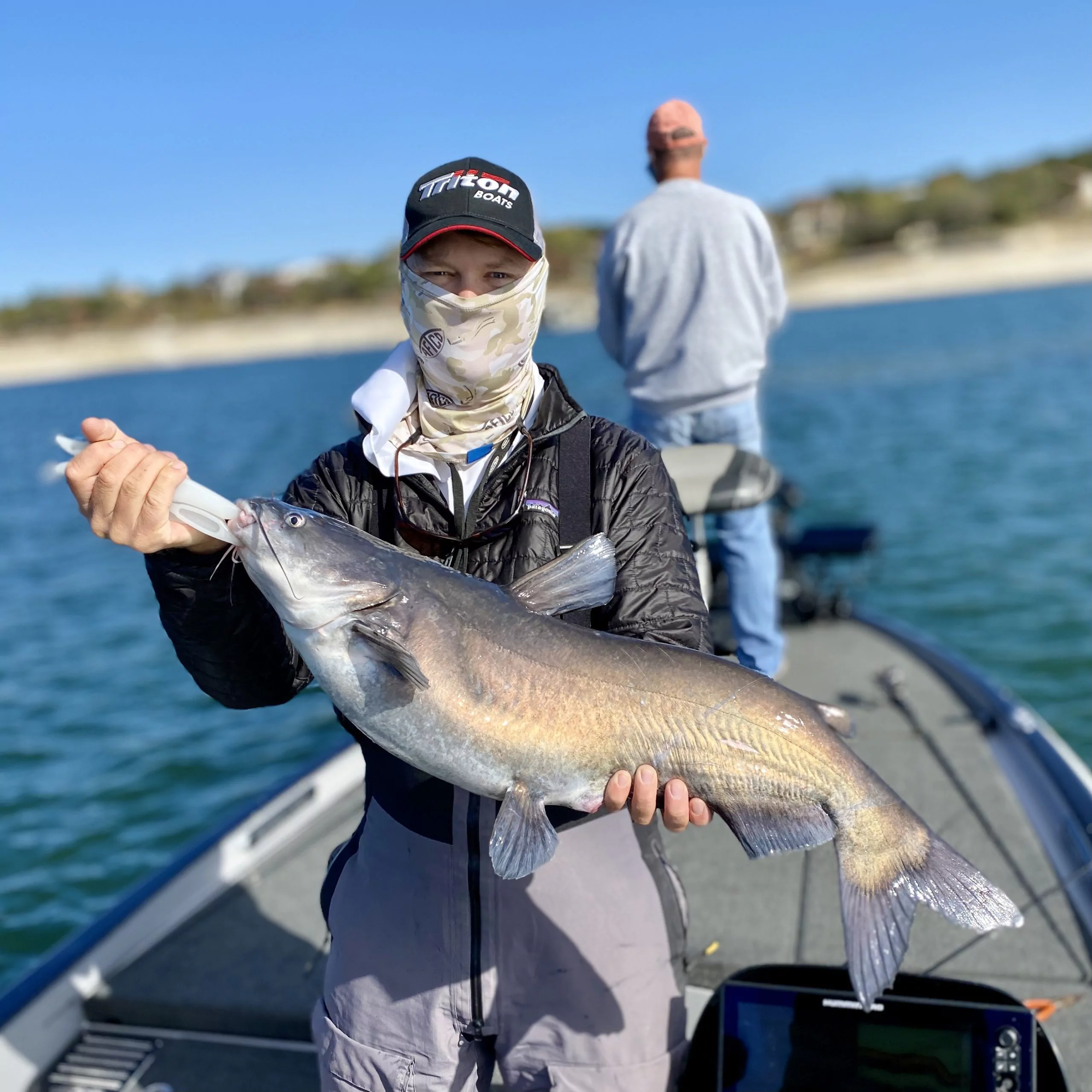
My next two baits are for once you have made numerous casts at the schools and are now ready to get directly over the top of them and fish vertically over them. For this I recommend turning on your 2D sonar and Livescope if you have it. Get right over the schools of bass and drop your bait down close to your transducer so that you can see it go down the screen, stop it once you are at the same depth as the fish. For more aggressive and active fish I like to jig a silver ½ ounce jigging spoon around these schools of fish to trigger bites. When they are more lethargic I like to drop a small fluke on a drop shot down to them. Fish it with small twitches of the rod top and don’t be too aggressive with the bait.
As I mentioned in my previous report, my approach to bass fishing has a bit of a scientific twist to it. Understanding their environment and how the conditions affect the fish makes them more predictable. As the water gets colder you will start seeing these fish move out deeper, but why? Well, largemouth bass are cold blooded and as the water cools their metabolism slow. During the winter time the lake has no thermocline and the water is cold from the bottom of the lake to the top of the lake. However, the top part of the water column is the most prone to temperature fluctuations. Freezing temperatures over night can drop the surface of the lake several degrees, whereas a warm sunny day can do just the opposite. Bass like stability; so going deeper provides them with water that is not prone to change a whole lot. This is favorable to them and directly relates to the places they live during these colder months.
As the water gets colder expect the fishing to slow down a bit for the average angler. Beating the bank gets tougher as many of these shallow fish have moved, and you really have to work for every bite. While I personally hate the cold, I love wintertime fishing! There are several ways I have figured out how to catch them and have produced some very big limits this way. Don’t be afraid to get out on the lake and go fishing, you can still catch some really nice fish!
Here in Austin we are fortunate to not have to winterize our boats, and can use them pretty much year around. If you find yourself struggling to catch fish please consider booking a trip with me! I would love to get you out on the water and educate you on how to catch these fish, that way you are successful the next time you are out on the lake by yourself.
November 2020
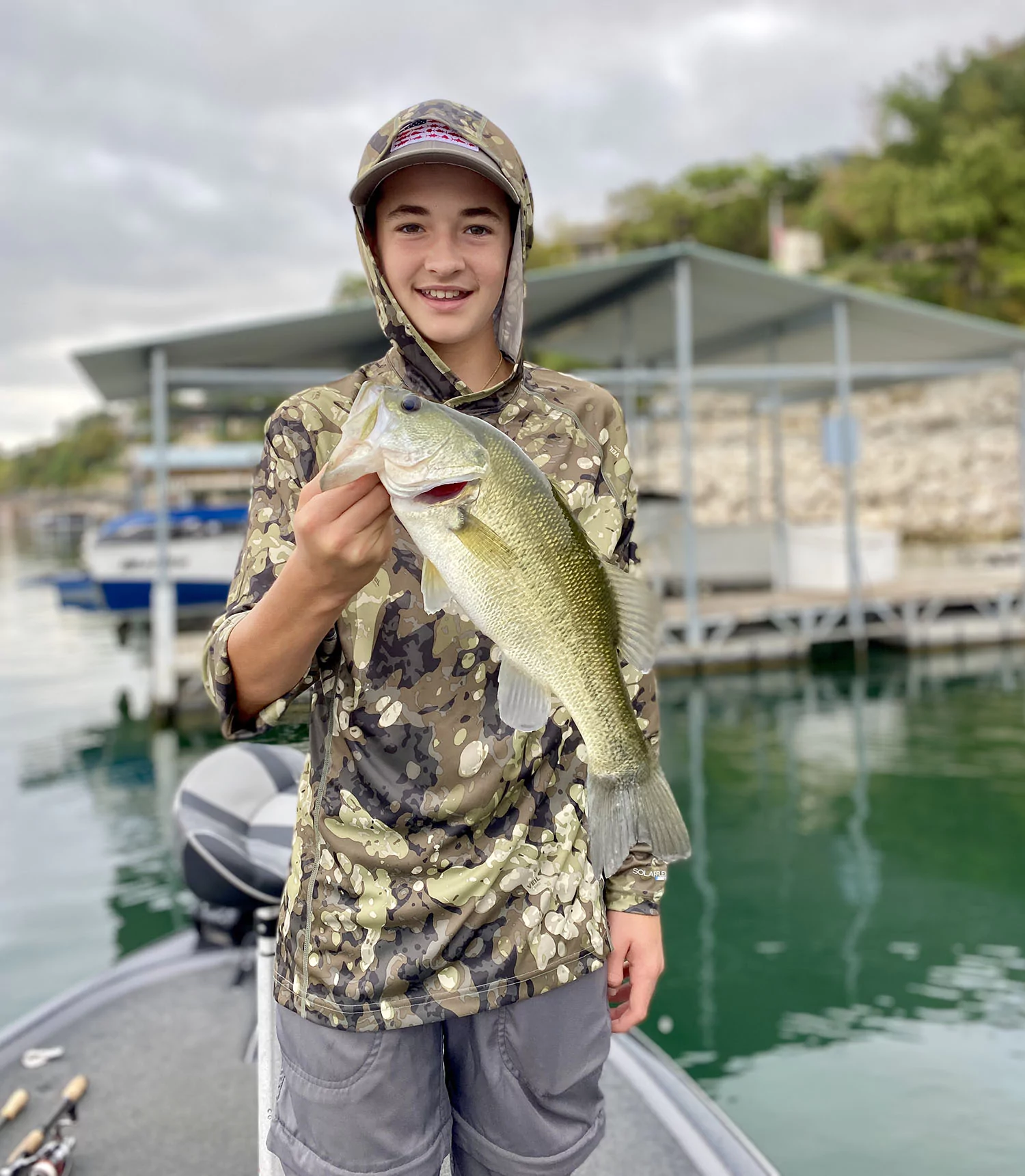
The fishing on Lake Travis has been phenomenal the past few weeks! Like clockwork, every year at the beginning of fall, there is a couple week period where the water starts to cool and the fish get active. Fishing gets stupid easy and largemouth feed up gorging on seemingly any bait you throw at them. The past few weeks the water temps have been in the mid to low 70’s. As of this report though, we finally have our first “real” cold front. I’m talking air temps in the upper thirties, the kind of weather where we Texas finally pull out our heavy jackets and coats. This will drop the water temps into the mid to upper 60’s.
So what does this cold weather mean for the bass fishing?
There are a couple things you can expect. First off, while we are experiencing this cold front expect the bite to change and the fish to react to it. In my experience it throws off the bite and makes it a little tougher. This is only for a day or two while the cold front rolls through. These fish rebound very quickly and will continue to feed until winter. Once you see water temperatures down in the high fifties you can expect the bite to slow. Until then, get out there on the water and keep fishing!
So where do the fish go?
If you read fishing blogs, my reports or watch Youtubers, you’ve probably heard that the bass move up into the backs of creeks and coves. Everybody is saying this, but I rarely see anyone explain why the bass do this. Nowadays I feel like so many anglers simply regurgitate the same info over and over. So it begs the questions, why do they do that? Well, it’s to follow their food source!
During the fall there are two main forages the bass prefer; crawfish and threadfin shad. As the water cools you will find these shad moving from deep water, which in the case of Lake Travis will be the river channels and major creek arms. (Remember, arms of the lake such as Sandy Creek or Cypress Creek are as large as some small lakes!) You will find schools of baitfish making a slow migration back into the coves, which in turn attracts bass. Their lives revolve around their diet, so if you find the bait, you’ll find the fish!
These threadfin shad feed on plankton and are moving in search of that. During the summer the warm water and sunlight provide ideal conditions for plankton blooms and an ample food source for these hungry shad. As water temps during the fall drop the main lake cools faster than the backs of the coves, which in turn allows plankton to keep growing. Since the shad move back here for their food source, predator species such as bass and crappie follow.
My approach to bass fishing often involves the science behind it, and not just whatever the latest fad on BassMaster is. Understanding what is going on beneath the surface of the lake, not only with largemouth bass, but also with the other species of fish in the lake, can help you become a better angler.
So what should you throw to catch these shad hungry bass? Well, there are several things I like to throw, but let’s go with my top three.
- Topwater Spook – I love throwing a shad colored walking style bait such as a Zara Spook, Sammy, or Gunfish. Long casts with this style bait, covering lots of water, are very effective. Focus on the mouths of small coves, points within a these coves, and drains along the shoreline in these coves. Look for structure that provides an ambush point for a bass to attack their prey. Typically the topwater bite is best in the morning or evening. However, on overcasts days you can get them to bite it all day long. I especially like it if there is a little wind blowing into the area I am fishing.
- Crankbaits- Medium diving crankbaits can also be a terrific bait to throw at these shad hungry fish. I should note, I also throw this bait a lot in red and orange as well, to imitate crawfish. When trying to mimic shad though, go with natural colors such as chrome, white and black, or something with a little purple in it.
- Flukes and Senkos- a fluke makes sense to try and imitate a shad right? Duh of course! But a senko? Yep, when these fish move up shallow but the bite is a little tough, I like to break out a wacky rigged senko. For this though, I will throw colors like Smoke or Natural Shad. The slow enticing fall of a senko can be deadly even though it is not shaped like a bass. I especially like this bait because it is the perfect bait to fish near docks. Cast it right up against a dock and let it fall. For docks sitting in water deeper than 15-20 feet I will often add a small tungsten nail weight into the senko to make is sink slightly faster. I recommend throwing this on braided line with a fluorocarbon leader. Use braid that is white or yellow as it is easier to see. Watch for a tick in the line or it to stop falling prematurely; if you see anything odd lift your rod tip and feel for pressure… if you feel anything weird don’t forget hook sets are free!
As for the fluke, I like to rig this on an Owner twist lock hook and make long casts with it. If its windy or I want to get the bait a little deeper I will opt for the hook with the belly weight. Fish this bait like you would a jerkbait with a twitching motion of the rod tip, as well as numerous pauses.
These are all excellent options when trying to match the shad the bass are feeding on. As I mentioned earlier though, crawfish are a large part of their diet too. With Lake Travis being so rocky, there is actually an abundance of crawfish in the lake.
A crankbait such as a Storm Wiggle wart or Spro Rock Crawler in a crawfish color is an excellent bait to cover water with and quickly work a rocky shoreline. The same locations as before apply, however you are trying to get this bait down to the rocks and get it to bump into the bottom. Let the bill of your bait hit and deflect off rocks; this will often trigger bites. I will switch baits depending on the depth of the rock I am fishing, so I recommend having several similar colored baits, but with different diving depths.
A football jig or a Texas rigged craw will also work extremely well. If you have ever fished with me you know I love to throw jigs. I even pour my own jigs! A ½ ounce brown and orange football jig with a speed craw for a trailer is a deadly combination. I find year after year my largest fish come off this bait. Fish it slowly around rock and make certain to maintain bottom contact.
As for the Texas rig, this bait is often times interchangeable with a jig. Mix it up and experiment to see what the bass like. For this set up I typically throw a 3/8th ounce tungsten bullet weight and a Rage Craw or Zoom speed craw.
A little tip for your bass nerds like myself… get yourself a crawfish trap from Academy. Bait it up with some canned cat food and leave it out over night. I like to catch crawfish from time to time and see what color they are, in order to get a better idea of what color baits I should be throwing. With the clear water on Lake Travis, throwing something that looks just like what the bass are feeding on can make a big difference.
Spring and fall are my two favorite times to fish here in Austin, TX. Just because the weather is a little cooler and a little more unpredictable, does not mean you shouldn’t get out there and go fishing!
If you are looking to up your game I would love to be your fishing coach! I love teaching new and veteran anglers alike. My approach to guiding is educational, so if you are looking for more than someone who will hand you a rod and tell you where to cast, give me a call.
If this report was helpful and you enjoyed it, the biggest “thank you” you can give me is to share this on social media!
October 2020
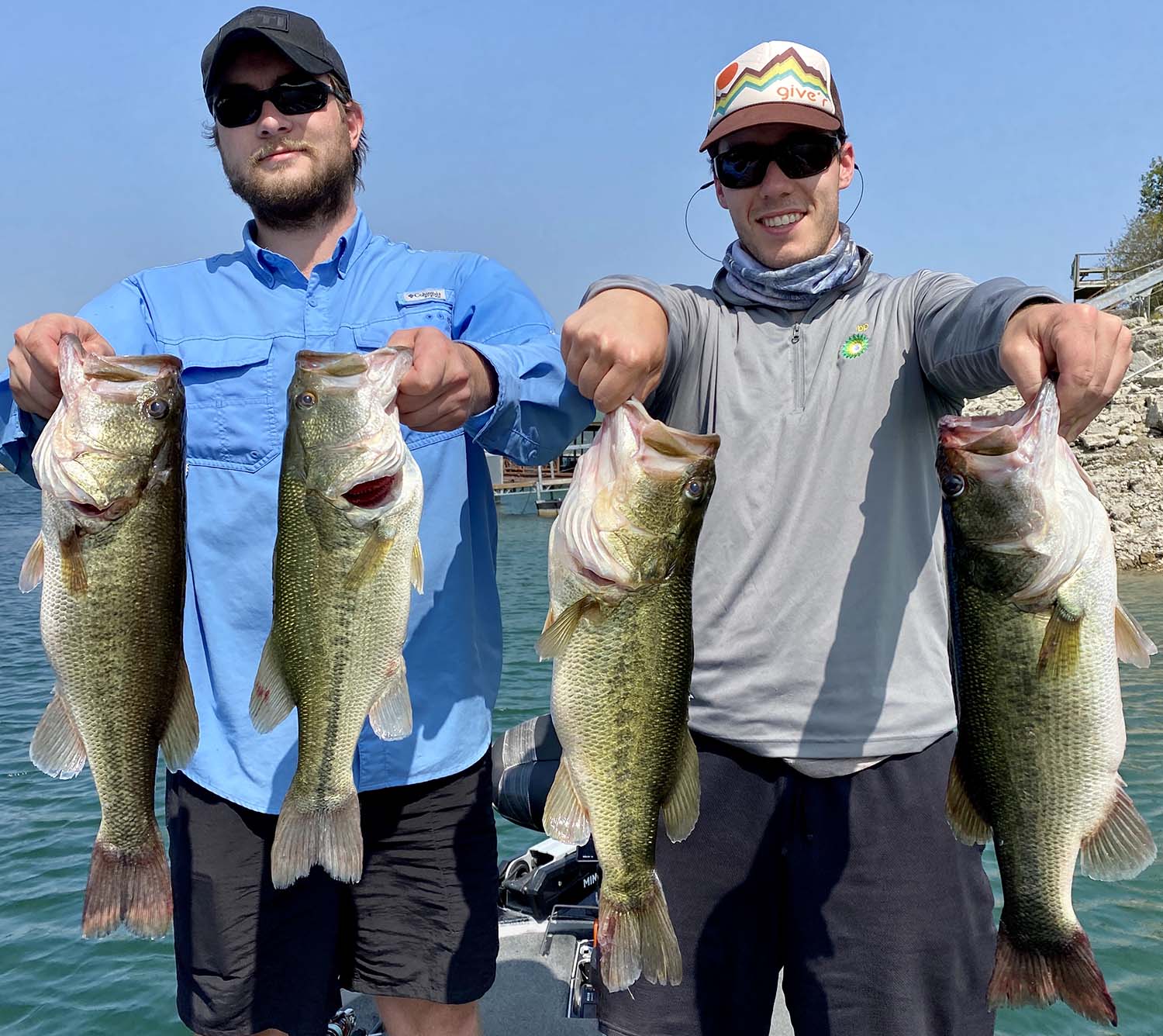
Lake Travis has finally begun what I refer to as the fall transition. During the end of September and the beginning of October, depending on when we first start seeing cold fronts, the lake temps will start to drop. Typically it takes several cold fronts and several days of extended cool temperatures before you see the surface temp of the lake actually start to drop enough to have an effect on the fish.
With this cooler weather I have been seeing the lake temperature around 78-80 degrees. Once you start seeing these temps the bass start to get more active and move up out of their deep summertime homes. During the hottest months of the year the bass go deep to offshore points, humps, ledges, marinas and bluff walls.
Now that its that time of year for these fish to start transitioning you can expect to find some populations of fish moving closer to coves. I recommend looking for large coves and trying the points and sections of shoreline directly adjacent to the point. Creek channels are a major factor during the fall, as these fish will move up into the creek channels and use them to move from the main lake to the backs of the coves. Here on Lake Travis a lot of our coves are very deep and are basically flooded canyons. For coves like this stick to the points and nearby shorelines. However, for coves that do have a defined creek channel, look on the map and look for the places closest to the mouth of the cove that have a bend or ledge. Then find shallow water closest to that! That is a high percentage spot for those fish to pull up on.
The top water bite has been exceptional as of late, and will continue to be a major pattern until December. Typically this is a morning or evening pattern, however on days with lots of cloud cover and wind, you can get them to bite a topwater plug all day long. Recently I had a day with a morning and evening trip… we caught numerous fish, up to 5 pounds, on a spook all throughout the day.
Clients always ask me my favorite time to target largemouth bass on Lake Travis. My answer is always the same… spring and fall. Fall is a close second to springtime for me as the numbers of fish you catch are excellent, and later in the fall you start to see lots of big fish being caught.
Cooler water temps tell the fish’s biological clock that winter is approaching and that it’s time to start fattening up. Come December through February the fishing will slow down a bit as the fish get more lethargic. (With that said, some of the absolute best fishing I have ever experienced on Travis has been during the winter.)
As far as bait selection goes, a topwater walking style bait is hard to beat. Of the various styles of topwater lures a classic spook is my favorite. There are a lot of versions of this bait, a vixen, sexy dawg, spook, rover, dogma, etc are all good choices by various bait companies. I like this style bait since I can fish it fast making it “walk the dog” back and forth, but not fish it back towards me out of the strike zone too quickly. Bone or a shad color is all you need.
A drop shot is also hard to beat. I know I sound like a broken record, but I throw a drop shot with success year around on Lake Travis. A small roboworm or trick worm in something watermelon, green pumpkin, or purple is a sure fire way to put fish in the boat.
The last bait I recommend is an underspin. This is a lead head with a willow blade under it that you rig with a small paddle tail swimbait. I like an underspin over a normal lead head since I believe the flash from the blade helps trigger more bites. A 3.8 size Keitech fat swing impact in electric shad is a deadly combo. I like this bait since I can cover a lot of water quickly and the strikes tend to be very aggressive.
A fishing report can only help you so much. If you would like to get out on the water and learn way more than the internet could ever teach you, consider booking a trip with me and let’s get out there!
September 2020
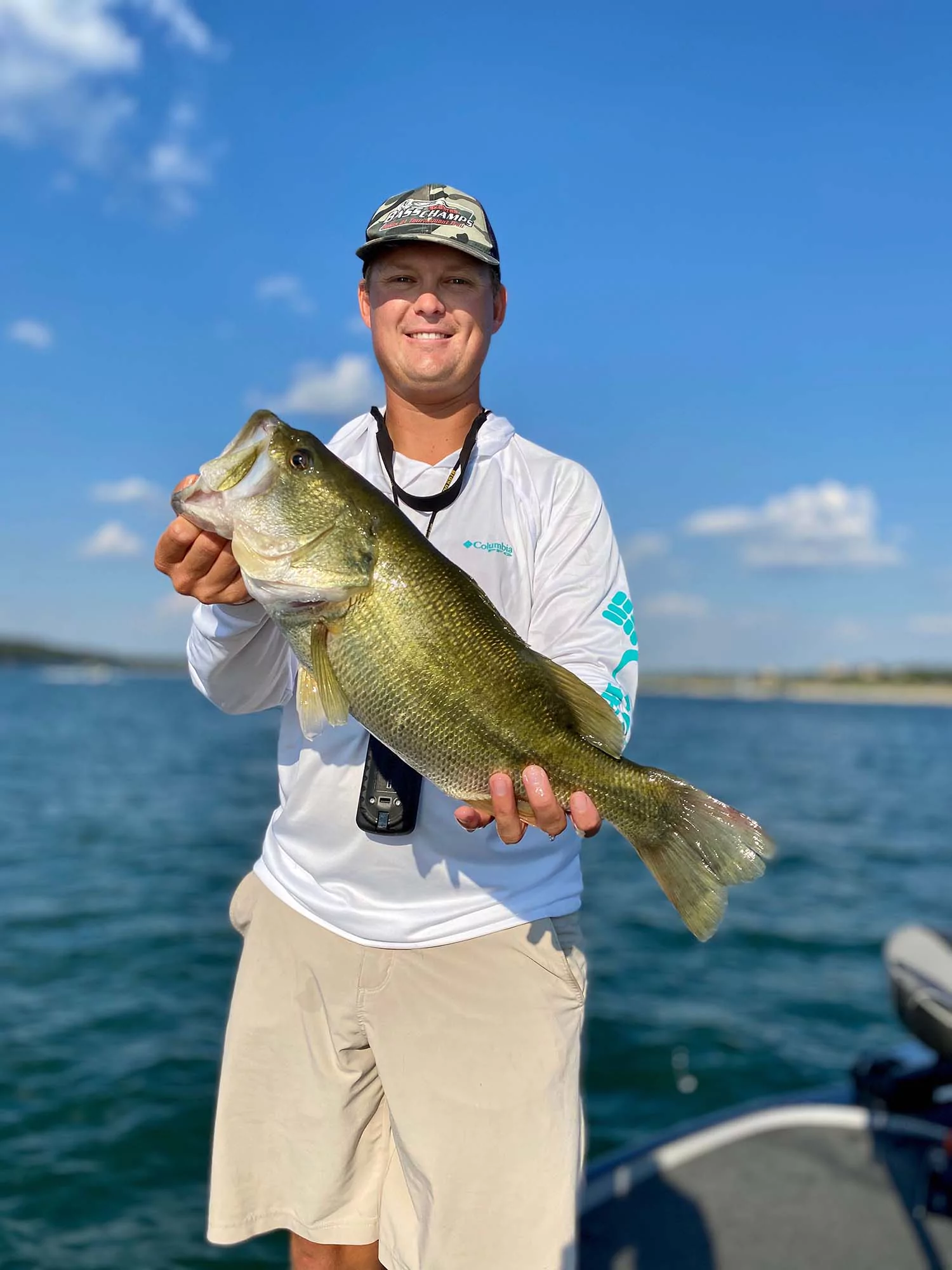
Bass fishing in September on Lake Travis can be a very fun time to hit the water! Currently water temperatures are in the 85-88 degree range with temps varying slightly depending on the time of day you are on the water and what end of the lake you are fishing. Water clarity on Travis is generally very clear year round. Currently water clarity is 5-10 feet depending on what end of the lake you are on. The lower end of Lake Travis closest to the dam is typically much clearer than the upper end of the lake closest to the Perdenales split. Increased boat traffic on the weekends can also muddy up the water so be mindful of that.
Topwater Bite
During the summer month’s fish tend to move offshore in search of stable cool water. With that said, some largemouth bass will make a migration to the shoreline early in the morning and late in the evening right before sunset to feed. I recommend getting out on the lake right at first light and tying on a topwater spook. A walking style plug such as a Zara spook in a natural shad color has been consistently putting fish in the boat! Bone or any translucent colored bait that mimics the color of a threadfin shad will get bit.

Make long casts with your spook across main lake points or ledges adjacent to deep water. When scouting I recommend utilizing tools like the Navionics web app or Google Earth to find new areas like this. Look for creek channels or big drop offs, then find the nearest point or ledge where a fish could pull up to in order to ambush prey. Spots like this are higher probability to hold bass as these fish living out deep don’t have to travel far to find shallow water to feed in. The shorelines of Lake Travis hold all types of forage including threadfin shad, sunfish, bluegills, and cichlids that these bass will hunt for.

Find Fish Out Deep
With water temps this warm expect to find most of your fish out deep once the sun comes out. Ledges, points, bluff walls, and rockpiles in 25-35 feet of water are your best bet. The deeper you go the cooler the water is and the less it is prone to fluctuating with cool evenings or scorching afternoons. With that said, hot surface temps can cause a thermocline to develop in the lake. When a thermocline is present fish will go as deep as the can without going below it. A thermocline is essentially a divide down deep in the lake between the cooler dense water and the lighter warm water. When this phenomenon is present the cooler water below the thermocline will hold very little dissolved oxygen.
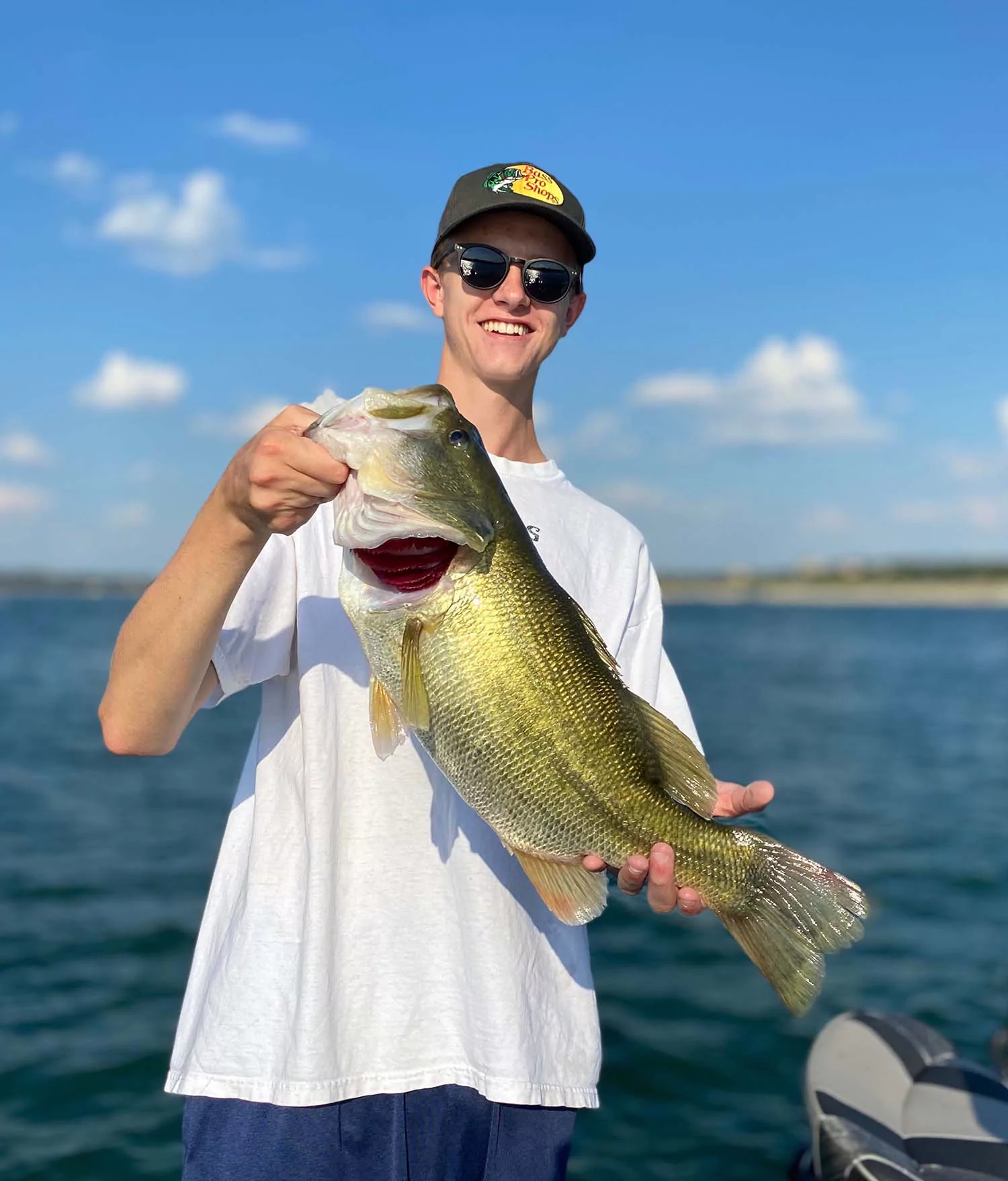
Knowing when a thermocline is present can help significantly in figuring out how deep to fish. Knowing how to determine when a thermocline is present is something I cover during my guided trips.
As far as baits go, I recommend a dropshot with a small straight tail worm such as a Roboworm, a Texas rig with a curl tail power worm, or a Carolina rig with a creature bait such as a lizard or baby brush hog. These three rigs will cover a wide array of spots on Lake Travis. During this time of year bass also tend to hang out in schools out deep. It is not uncommon to graph a point and come across large schools of bass close to the bottom. When fish are spread out or hangout higher up off the bottom I also like to throw a deep diving crankbait. A Strike King 6XD or 10XD, depending on the depth, is a great bait to cover water and get down to these schools of fish.
About Torwick’s Guiding Service
My name is Tyler Torwick, captain here at Torwick’s Guiding Service. I am the former team president of the Baylor Bass Fishing Team and fish competitively in several tournament trails in Central Texas. I also live near the dam on Lake Travis and fish the lake over 200+ days a year.
My passion is fishing and I love teaching others how to fish. My two favorite trips to guide are trips with children and my “coaching trips”. If you have young children now is the perfect time to introduce them to the sport of fishing and get them hooked on the sport that you love! For trips with children I recommend a half-day trip. My focus is to keep them busy catching fish, learning about what we are doing, and engage them to prevent them from getting bored or fussy. We will focus on learning how to cast, how to present different kinds of lures, and how to fight a fish back to the boat.
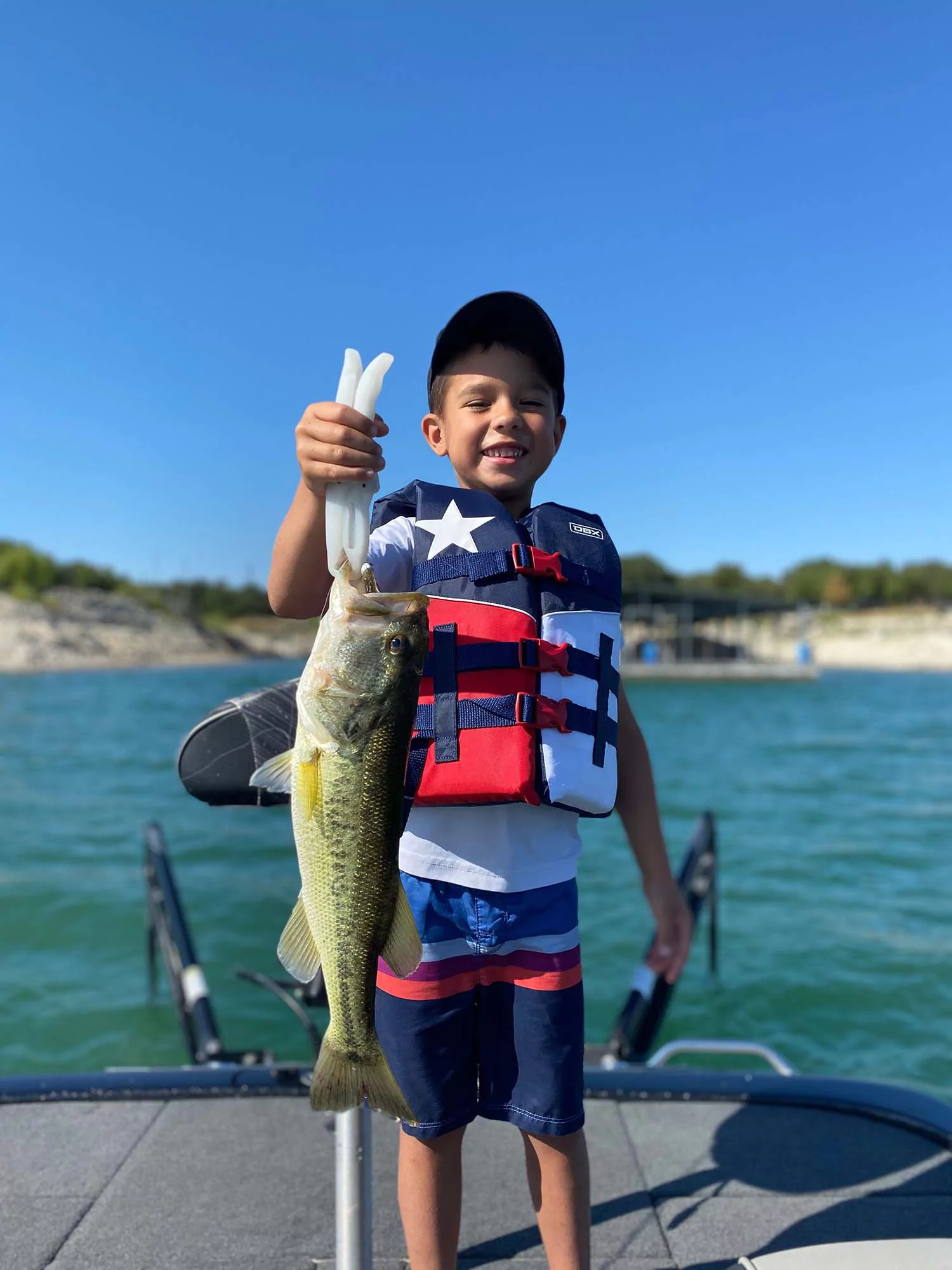
For my coaching trips I like to approach the trip as if we were practicing for a fishing tournament. We will cover things like bait selection based on seasonal patterns, ways to more effectively fish deep, what to look for based on current conditions etc. We will also go in depth about how to use your electronics to find fish. We will go over how to set up your graphs, what each sonar frequency does and when to use them, and how to interpret what you are seeing on the screen. I also am a big believer in not fishing “spots” and fishing a pattern instead. I will teach you how to figure out a pattern as you are on the water and how to build on it throughout the day in order to better predict what the bass will do, rather than just hitting the same honey holes over and over. I guarantee that this alone will be worth the price of a guided trip! If you fish Lake Travis often this can be the difference between having a good trip every once and a while, to consistently going out and catching fish.
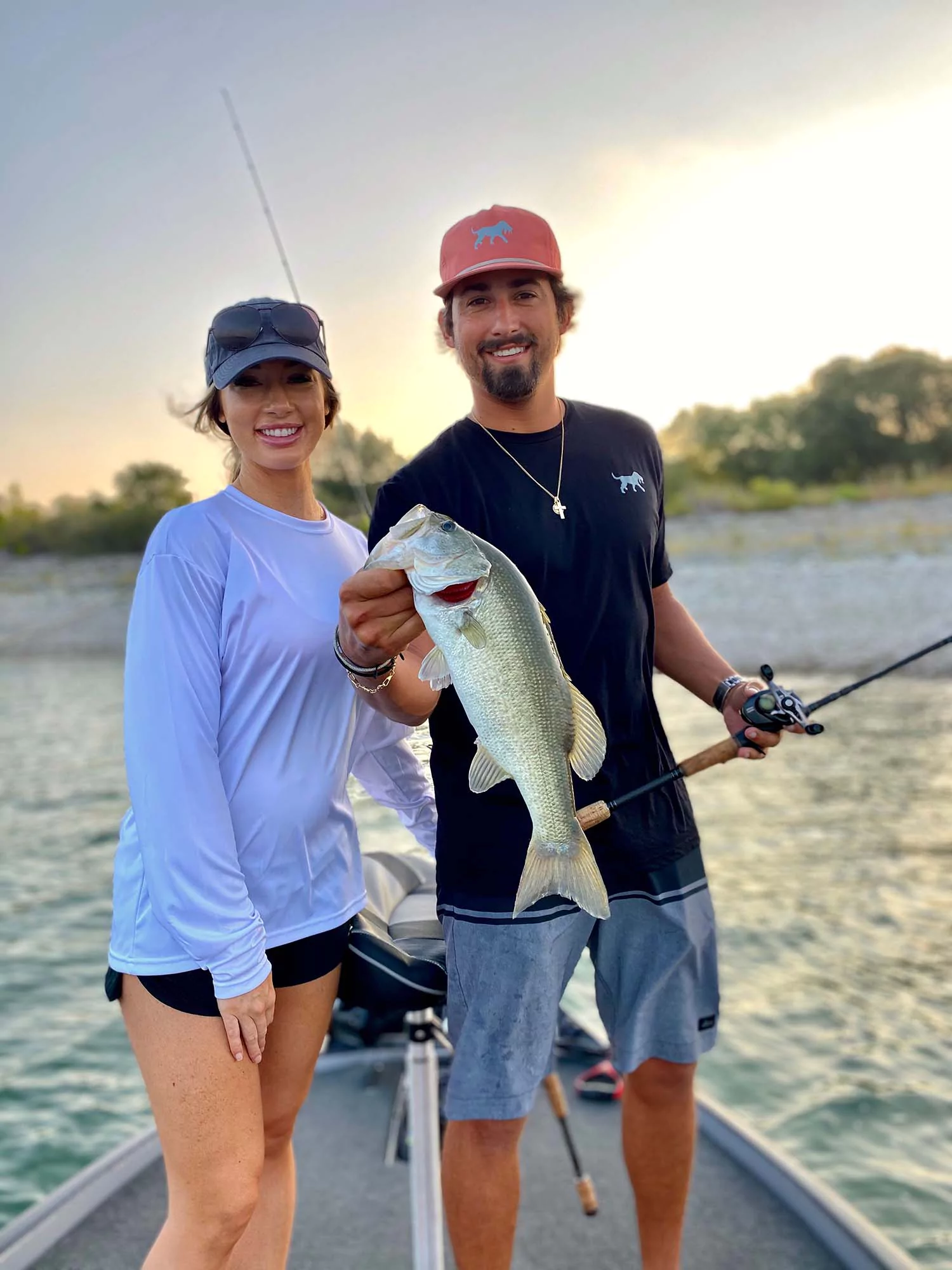
August 2020
At this point in the season, you shouldn’t be looking in the creeks at all. In my opinion, it’s a waste of time. I’m either at the mouth of the creek arm, fishing main lake points, or I’m offshore looking at deep contours. Also, I might focus on very main lake bluff type areas. Big fish become very migratory and predictable, while smaller fish can be found in the backs of creeks, year ‘round. Big fish have greater metabolic needs and leave nursery type areas to follow oxygen saturation and open water forage. The biggest fish want the best possible combination of cover and favorable environmental conditions. Thus, in middle of the Summer you need deep, cool oxygen rich water that carries a substantial food base. This will likely consist of threadfin or gizzard shad schools.
July 2020
We are now officially in the heat of the Summer. Time to buckle down and focus, because the easy fish have been picked off. The premium is now placed on utilizing electronics to discover condensed groups of fish on select pieces of offshore cover. Also, the timing for fishing these locations is important, as the heat will cause the fish to suspend and become inactive. Of course, the early and late bite are the times that you want to capitalize on. You may see a brief feeding window open up during periods of increased wind or temporary cloud cover. My go to Summer techniques are swimbaits, carolina rigs, shaky head worms, and drop shots. I mainly throw my moving baits, like crankbaits and top waters, in the mornings and evenings. However, the swimbait, which is also a moving bait, can work during the day when the wind picks up. I’m generally going to start looking for fish in the 20 ft range during this time of year.
June 1, 2020
The early summer transition has absolutely begun to take place. While the fish aren’t out on the deepest structure in the lake, they have made a significant move to the 1st major break. Depending on the water clarity, I would focus on the 15-20 ft depth range, near isolated patches of rock. Of course you can always catch fish relatively shallow, but I believe the quality bite is out a bit deeper. You can’t go wrong with a shad colored deep diving crank bait and a carolina rigged lizard or ribbon tail worm, in some variation of watermelon or green pumpkin. Also, in the heat of the day, you might wacky rig a finesse worm on light spinning tackle and target docks with plenty of shade.
May 1, 2020
The majority of Lake Travis bass have now transitioned to post spawn. I am now looking at primary points at the front of the spawning creeks with a deep water channel swing nearby. Deep docks with numerous cross members and a low platform are probably the best. Also, deep timber off of these points can also be good. I would recommend setting aside a rod with a topwater tied on so you can fire out to schooling fish off these points. But, good techniques for deep points can be deep diving crankbaits, carolina rigs, and even jigs and Texas rigs. It’s mainly about how high in the water column the fish are positioned and their level of activity. Once you determine these factors, you can select a presentation to suit the specific situation.
April 1, 2020
We are still in the season of the spawn. Although, things have changed slightly. There are now two separate and distinct approaches one can take. The first approach would be to fish shallow for females that are close to beds. The second, to fish for bass that are using staging locations. These slightly deeper, but nearby locations will contain a mix of pre and post spawn bass. However, the bulk of these fish will likely be post spawners. For the shallow bite, I’m pretty keen on the lightweight texas-rigged brush hog. If it’s sunny and clear out, I’ll move to a suspended-type presentation like my drop shot of mini carolina rig. For the slightly deeper bite, instead of the texas rig, I may focus more on the drop shot and perhaps a standard-sized carolina rig.
March 1, 2020
It’s the season of the spawn, the best time of year for the average fisherman to catch a not-so-average bass on Lake Travis.
Focus on protected pockets and stable water. Look for hard targets like stumps and or boulders, with sand and gravel nearby. Key baits this month, when the fish are on bed, are bluegill imitations like square bill crankbaits or small swimbaits. Also, baby brush hawgs can be super deadly, due to the action that the tail and appendages impart. You can never go wrong picking up a spinning rod with light line. When everyone else is throwing power fishing techniques like heavy flipping and cranking or spinner baits, the finesse presentations can be quite advantageous.
The best water temps for spawning fish, in my opinion, would be 63-67 degrees. However, this is just a ballpark figure and there are always exceptions. I do know that access to freshwater and sunlight are important for the spawn. I would place a premium on water quality. Good luck and may the best angler win!
February 1, 2020
In the south, February is the start of great things to come.
There are few hope-giving warming trends that somehow find their way through a calendar of brutal cold fronts. I’m looking to those warming trends as the critical hour for big fish potential.
Often in Southern climes, the biggest fish of the year can come during this month… And I don’t mean your 5 pounders. I’m talking about the 7’s, 8’s, and 9+’s. I think the biggest fish of the year spawn first. While they may not be locked on bed at this time, they will hover in and out of the areas which they will be spawning in.
You have to train yourself to move a lot this time of the year, because you can bet the fish are. They move from creek channel to flat, and back to creek channel, constantly. This is dependent on 3 factors: Moon Phase, Water Temperature, and Barometric Pressure. Be dynamic this time of year. Prime presentations this month are low profile finesse jigs, Texas rigged beaver style baits, and Carolina rigged plastic craws.
January 1, 2020

Happy New Year everyone. My primary approach for bass fishing Lake Travis in January is to employ 1 of 2 strategies. You might give one of these a try this month for some good results.
Strategy 1: Throw small baits and retrieve at an average speed.
Ex: Small Drop Shots, Small Shaky Head Worms, Small Jerk Baits
Strategy 2: Throw large baits and retrieve at a slower than average speed.
Ex: Big Jigs, Swimbaits, Big Worms, Big Jerk Baits
As a general rule, Strategy 1 should produce more frequent bites… While Strategy 2 should draw a larger bite.
There are days that Strategy 2 won’t work, so don’t try and force it. Strategy 2 requires a stable weather pattern, and cold fronts will limit you to Strategy 1.
If you are fortunate to have a stable weather pattern, and you employ Strategy 2, chances are you could catch a giant.
If you are planning on fishing visible cover, look for areas that receive direct sunlight. Concrete, large rocks, tires, and black dock floats all hold heat the best. Also, time your fishing so that the areas you plan to fish have had some time to warm up before you fish them.
December 1, 2019
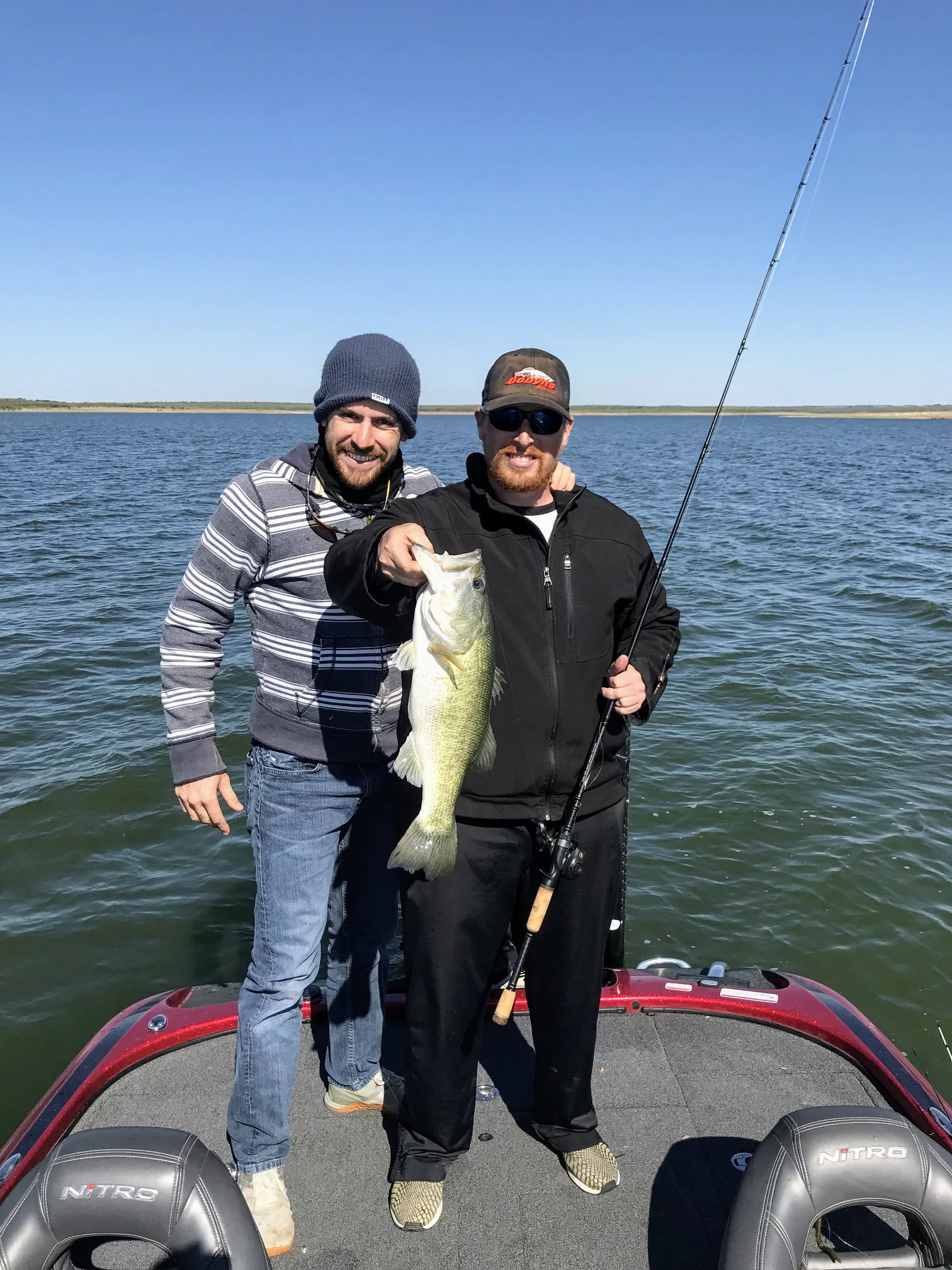
The late fall/winter period is here. So how should you best approach the change in seasons? The process begins with the fish finder, your underwater eyes. Be focused on creek channels, or the river beds at the bottom of the lake. During the cold months the baitfish congregate in these river channels and move in condensed “clouds”.
On a topographic map these creek channels are generally denoted by a darker color, signifying a deeper depth, relative to the surrounding topography. When following these creek channels, look for areas where they touch close to a shallower point or flat.
During slow periods, the baitfish and bass will relate to the creek channels. During increased periods of activity they will move onto the point or flat. A good starting depth range for an average water clarity could be a break from 15 to 25 ft. If the water appears to be more stained move shallower. If the water appears to be more clear, you might move deeper.
Carolina rigs are always a good choice for a long, lazy approach, for lethargic cold water bass. Flukes can be deadly as they represent the migratory baitfish and can be color matched to be even more effective. Deep diving crankbaits can be good during warm fronts accompanied by either cloud cover or wind. Once again, these lures would be most effective when color matched to the predominate prey species in your fishery.
November 1, 2019

November is my favorite time of the year to fish. It’s quiet, there’s less boat traffic, and oftentimes I find myself in sort of a meditative state. Really, it’s times like these when I’m able to hoan in and focus, making my time on the water count. Fall is notorious for being a time to mimic open water bait fish. Bass are feeding heavily in pods and corralling their prey. Great targets can be points, docks, seams, or any other obvious transition where bass have an opportunity to ambush. My clear water approach begins in 15 ft or less. Conversely, my stained water strategy is to target bass in 7 ft or less. My favorite baits this time of year are rattle traps and mid to shallow running crank baits, during periods of wind or cloud cover. In a post frontal situation, I’ll switch to something like a drop shot or senko. Finally, it’s not only about focusing on a specific target. Look for schooling activity and signs of life, and you’ll eventually find the fish.
Related Links:
Lake Travis Fishing Guides
Lake Travis Fuel Docks
Lake Travis Marinas
Lake Travis Parks
October 1, 2019
As we move into early fall, we are finding fish near creek channel swing banks, on the main lake. This type of transition is the first area deep schools of bait fish will pull up from, moving out of the creek channel toward shallower water. During high sun, we am focusing on docks and walkways that provide shade. In low light or more windy conditions, we’re seeking out chunk rock and other irregularities on the bank. Bonus tip: When it’s windy, look for sharp mud lines, they make for great ambush points.
Related Links:
Lake Travis Camping
Lake Travis Hotels
Lake Travis Vacation Rentals
Best Lake Travis Lakeside Restaurants
September 1, 2019

Summer conditions are still here and will be for at least the next month or two. That considered, it’s important to focus on offshore locations near deep water access, where fish can access cool water. We’ve definitely noticed that the bite is better near the lower end of the reservoir, meaning closer to the dam. There is more deep water current which transports cool water and oxygen. This current can be regulated by the dam and or resultant from the prevailing wind moving through. We get far more bites using compact baits, especially when the fish aren’t extremely active. We would recommend a small black and blue craw imitation, worked slowly on the bottom over brush piles or grass patches. Best fishing hours are early morning and late evening in low light conditions.
Related Links:
Lake Travis Lodging
Lake Travis Marinas
Best Lake Travis Boat Fuel Docks
Best Lake Travis Lakeside Restaurants
Best Lake Travis Parks
August 1, 2019
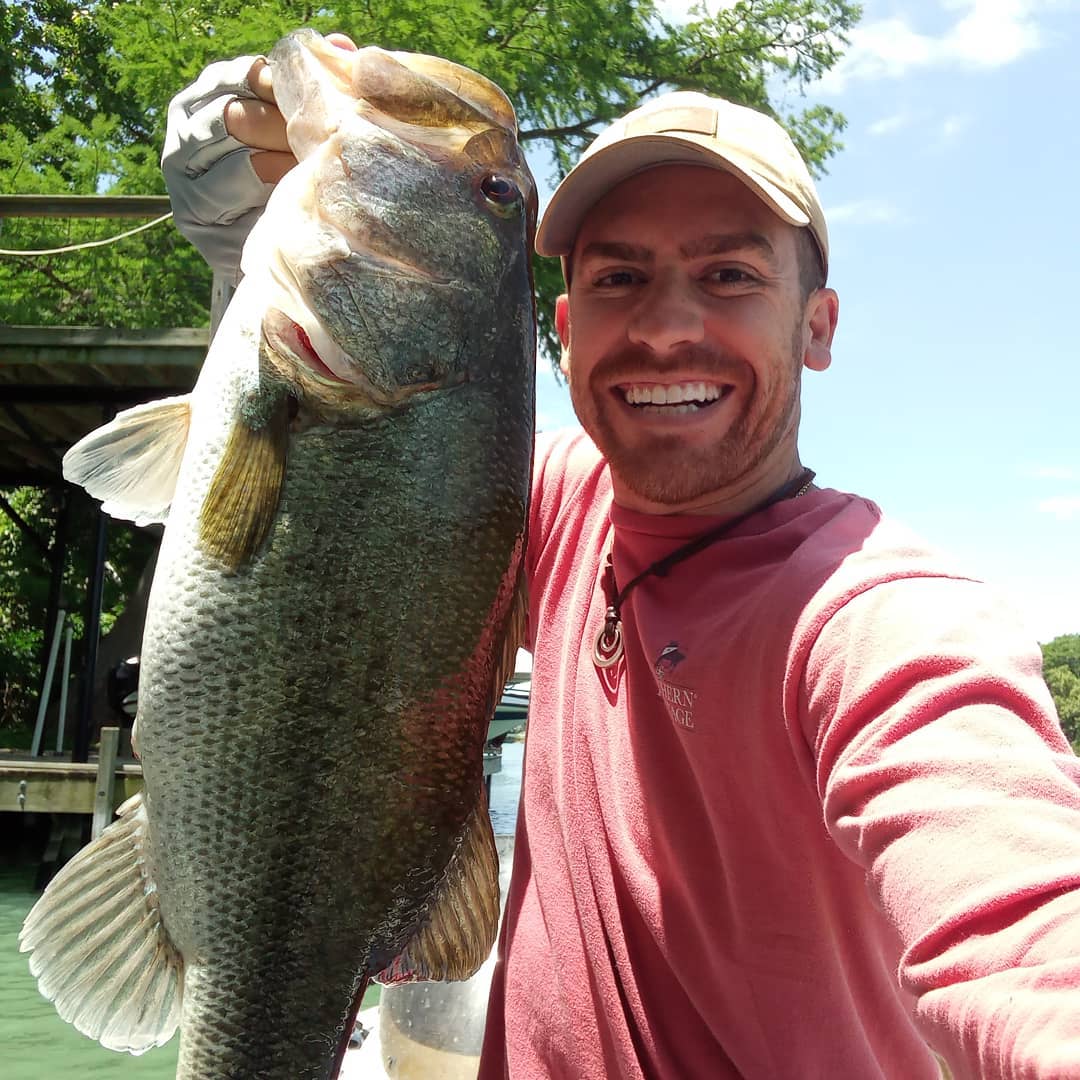
It seems the August key depth zone is about 25 ft. This holds true on the mid section of the lake where there is good visibility. We have been getting quality bites fishing carolina rigged lizards and stick baits. The areas we target are near the main river channel that runs through the lake. This is important because it brings cool, oxygenated water and food to the bass. Also, it provides an opportunity for fish to suspend over deep water in a secure environment.
Related Links:
Lake Travis Fishing Guides
Lake Travis Fuel Docks
Lake Travis Marinas
Lake Travis Parks
June 1, 2019
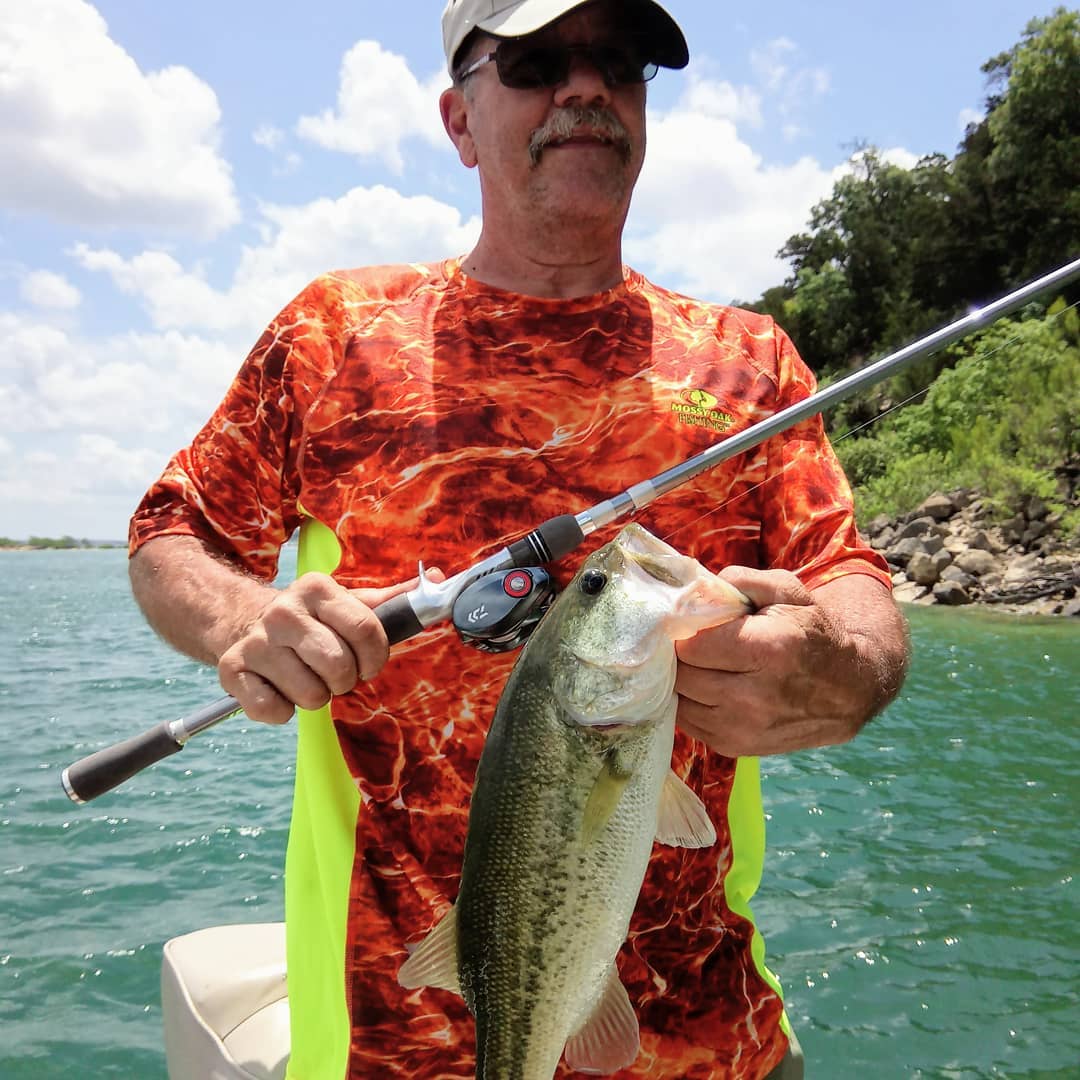
We have been catching the majority of my fish on drop shot flukes, on spinning tackle, in 10-20 ft of water. Top water baits have been good for the first few hours of the morning. we’re focusing on main lake points and docks with quick access to deep water nearby. Windblown areas can also be great as they congregate bait fish and other prey species. Carolina rigs with a 4’ leader have been good in the late afternoon. For this rig, We’re using a 7” berkley power worm in green pumpkin.
Related Links:
Lake Travis Camping
Lake Travis Hotels
Lake Travis Vacation Rentals
Best Lake Travis Lakeside Restaurants
May 2019
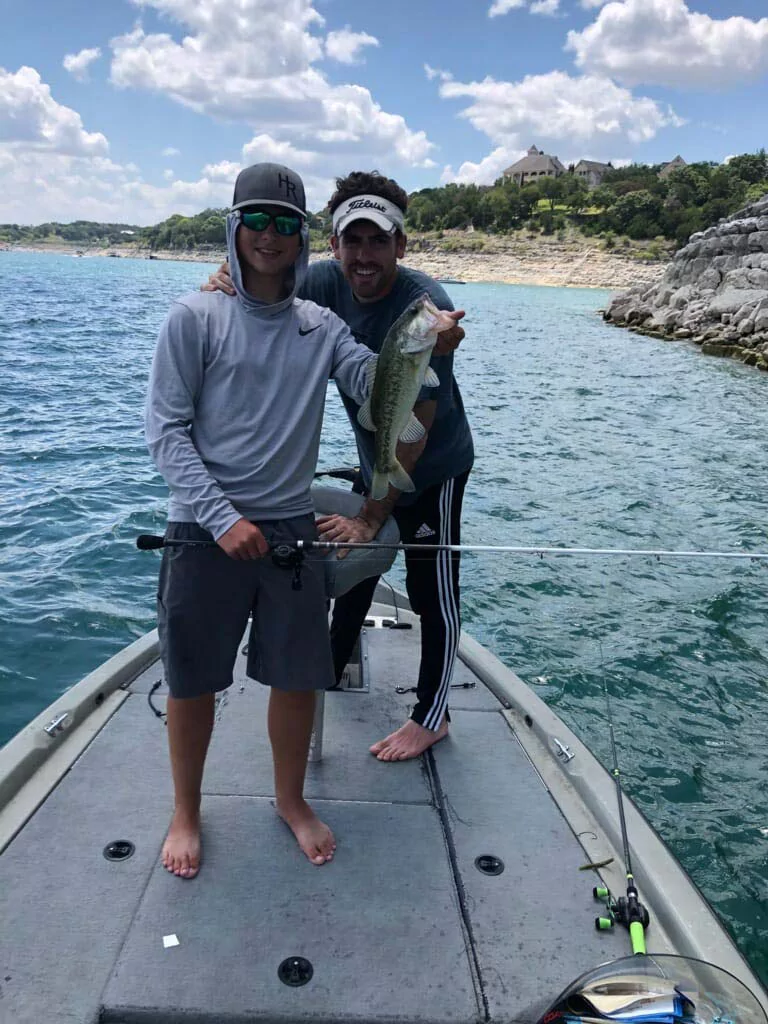
Transitional areas are important during this time of the year. I don’t want to have my boat positioned too far back into the creeks. Instead, I am looking for the first stretch of deep water out in front of the areas where the fish have been spawning. Drop shots and shaky head worms have been doing well for me. I am focused on water in the 10-15 ft depth range. For the shaky head worm, I am using a 4” zoom finesse worm in green pumpkin. For the drop shot, I’m using a zoom fluke in the albino color.
April 1, 2019
Lake Travis is starting to fish better this month. There are still a few fish on beds and they should be done after this next full moon. That is a good sign as the post spawners are starting to come out and play. You can catch some fish on topwaters using a walking bait like a spook throwing over trees in 5-12 foot of water and over and near rock piles or cliffs to get some good bites. You can catch several fish up shallow but not too many big ones. The bigger fish are still out a bit deeper in 15-30. You can catch some of the bigger fish on jigs and shaky heads using trick worms, senkos and craw worms. Moving baits such as swimbaits and crankbaits is about to get good so keep trying those to get some good bites. Skipping docks will always get you bit as well. Texas Hawgs!
March 1, 2019
Lake Travis is still fishing a little tough this month with a few active days in between. There are a few fish on beds already as well. You can catch several fish up shallow but not too many big ones. If you want big you need to fish 20-50 feet of water. Most of the bigger fish are hitting jigs, shaky heads and Carolina rigged plastics. The water on Travis is getting pretty clear now but you still can’t see fish on beds in deeper water like 15-20 just yet. The time change is on March 10th so the lake is about to explode. Catching them will soon be on more moving baits such as spinner baits, crank baits, swimbaits, etc. It’s about to be a great time to get out and on some nice fish. I still have some dates coming up so get your trip booked soon with Texas Hawgs…
February 1, 2019
Lake Travis has been fishing a little tough this month. There are fish in every part of the water column from a few feet to all the way down to 60+ feet. You can catch some up shallow in spurts and a few decent ones out deep with really slow presentations using jigs, t-rig worms and shaky heads. If you look around some of the deeper ledges and points, there are a lot of fish suspended and you can catch a few of these using jigging spoons. The water on Travis has cleared quite a bit since the flood, but if you can find some dirty water, you can catch fish flipping cover much shallower than in other parts of the lake. The lake is about to explode though with warmer weather on the way so it’s a great time to get out and on the fish. I still have some dates in spring coming up so get your trip booked soon with Texas Hawgs…
January 1, 2019
Lake Travis has been fishing well this month. You can catch them right on the bank out to 35-40 feet of water. The ones up tight to the bank are chasing shad so a small swimbait/swimjig, shallow crankbait and even a spinnerbait can get you bit. You can usually see these super shallow fish blowing up in schools on the bank. Be quick though. They move out and down the bank pretty fast. Deeper fish can be had on Texas rigged worms and shaky heads in watermelon and green pumpkin colors and some of the bigger fish have been eating a 1/2 oz up to a 3/4 oz jig in either green colors or black/blue with a good craw trailer. Dates for spring are filling up so get your trip booked soon with Texas Hawgs…
December 1, 2018
Lake Travis is fishing good right now. The fish have moved a little since the flooding several weeks ago but we are still coming across some really nice ones. We have been finding numbers up shallow as well as deep. We are catching them on a number of baits such as soft plastics, jigs and crank baits. Some days you can even find some good ones on top waters. I take out anyone from novice to most advanced and a lot of kids as well. It’s a great joy to get your kids into fishing and into the outdoors. That’s one of the greatest gifts my dad has passed on to me and his father to him and I am to my kids. I would love to help you out in doing the same as well with yours so take your kids fishing today – Bryan Cotter – Texas Hawgs
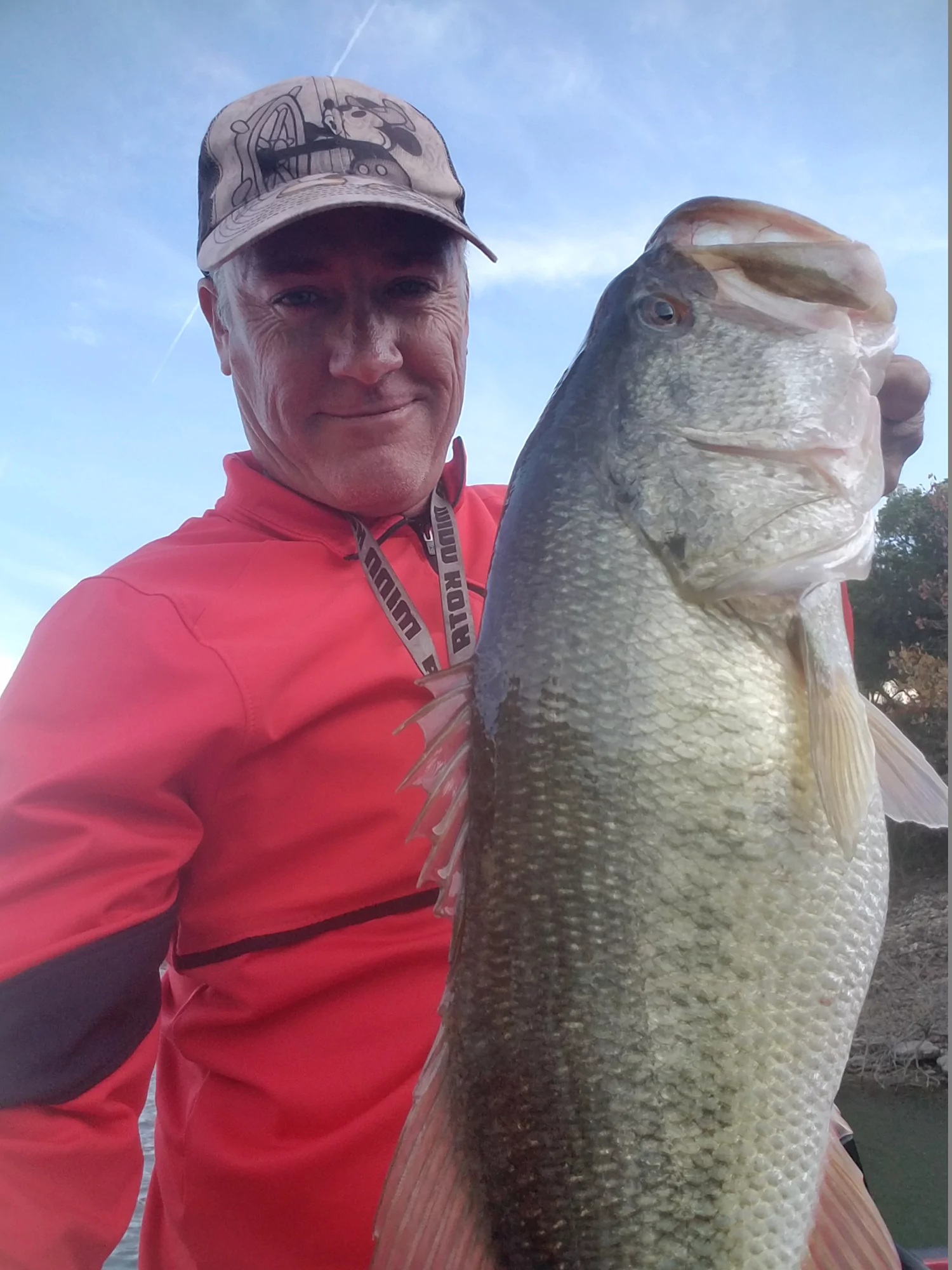
Related Links:
Lake Travis Lodging
Lake Travis Marinas
Best Lake Travis Boat Fuel Docks
Best Lake Travis Lakeside Restaurants
Best Lake Travis Parks
September 1, 2018
Thank goodness for the much needed rain that we have been receiving! As the lake level creeps down on Lake Travis the fishing has been great the last few weeks. With a little less water in the lake, the end result is being able to target the fish a little easier in certain areas. A watermelon red trick worm on a shakey head has been our ticket the last few weeks. We are still starting our mornings with top waters or shad imitation swim baits early. As the fall months near the fishing will continue to be stellar! The night time crappie and striper fishing in still on fire on the lower end of Travis. I had the honor of taking a young man fishing on Labor Day and he landed several bass, two being in the 4-5lb range. Tight lines! – Lee Benton – Fishing Guides Austin
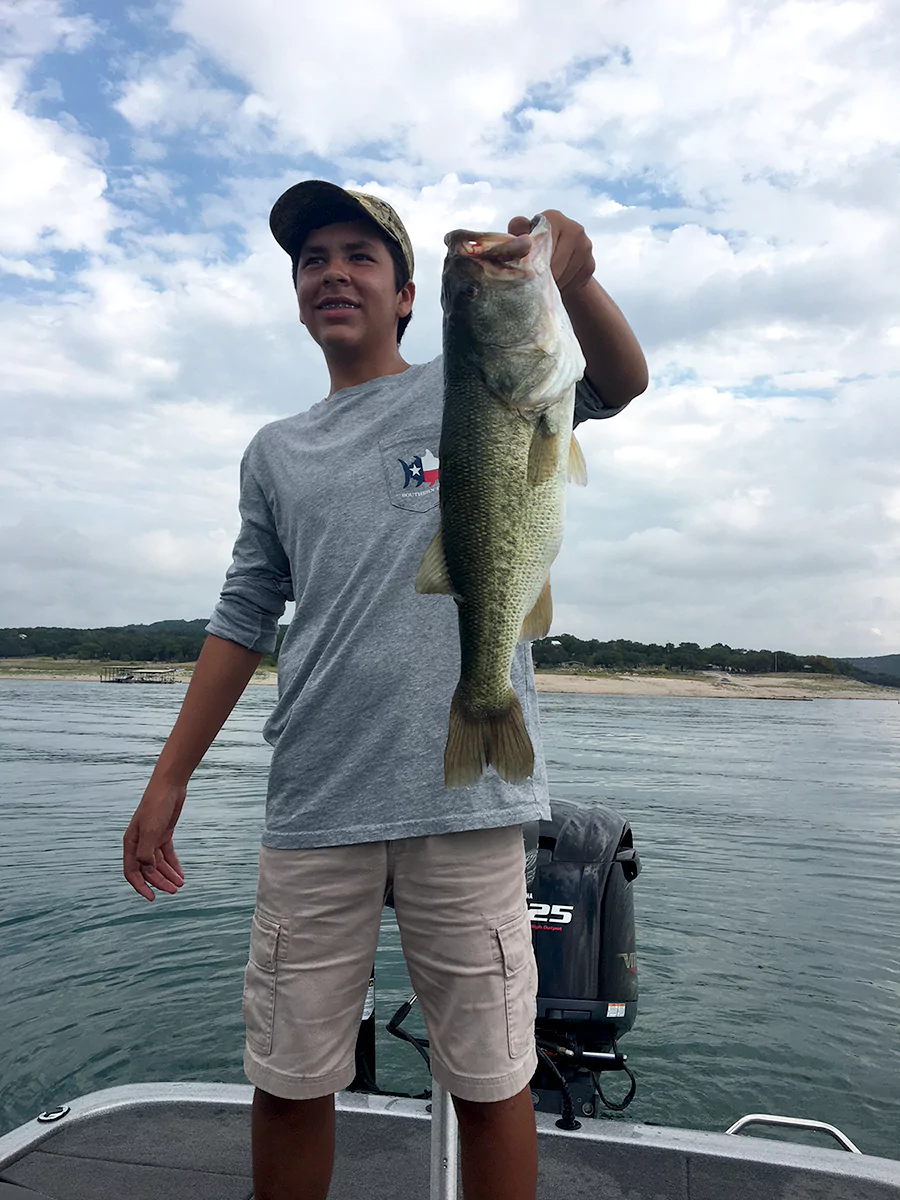
August 1, 2018
As my client found out this morning Lake Travis summer fishing is still strong! We decided to just fish deep today and fish very slow. Our morning started on a deep chunk rock near Starnes Island on the lower end of the lake. We stared seeing action pretty quick with most of our bites coming in the 20-30 foot depth. As our shakey head worm crept over deep rocks our line would just become heavy and swim off. It was a very subtle bite today but a lot of fun! There is still some top water action but not near the constituency of the past few months. I have noticed the fish relating to the deep sloped chunk rock banks as the lake level creeps down. I believe that starting your fishing trip early in the morning this time of year seems to yield more bites and fish. We try and use the shade lines to our advantage and fish where there is a shadow cast on the water. And don’t forget about the night time striper fishing this time of year. We have seen some quality fish being caught near lighted docks at night on a variety of shad imitation baits. Stay cool, and tight lines. – Lee Benton – Fishing Guides Austin
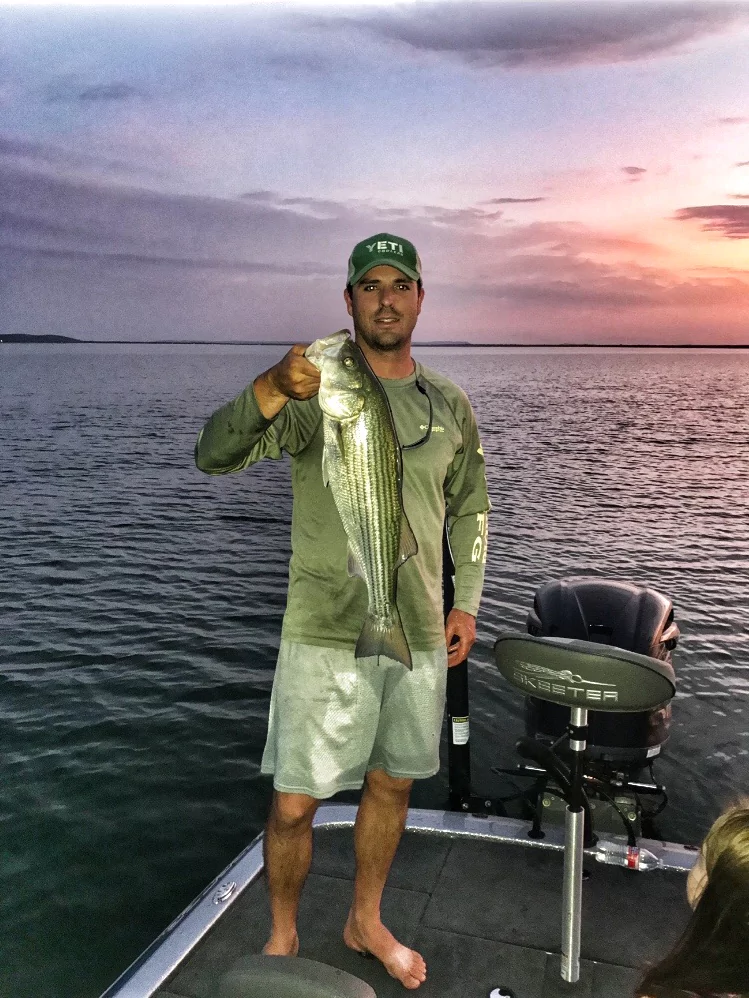
July 1, 2018
The fishing on Lake Travis is holding strong as summer is officially here. We’re still experiencing schooling in the marinas early and sporadically throughout the day. The flutter spoon has been producing a few better bites under the schooling fish! Every now and then you will get a nice bonus bite with a striper latching on! My clients the other morning caught two bass on one topwater bait! We have found the walking the dog baits have been very productive (Zara spook style). The better quality bass have been showing up night fishing with jigs and creature baits. The deeper chunk rock banks have been key for this pattern. Tight lines and have a great July! – Lee Benton – Fishing Guides Austin
June 1, 2018
Ready or not summer is here! With Lake Travis water temps in the upper 80s the fishing is changing a bit from the last fishing repoort. The Bassmaster Elite guys (2018 Toyota Bassmaster Texas Fest) showed up to Lake Travis and wacked some big ol bass! Cliff Pace started the first day with 10.5 pound bass first thing in the morning. Several bass over 8 pounds were caught and a bunch over 4 pounds. What does that say about Lake Travis?? The Lake is HEALTHY! It’s no secret the tournament was won on surface baits (see video). Zara spooks, buzz baits, and poppers just to name a few. Now with that being said the bite has begun to slow up a bit with the warming water. In the last few weeks we have been catching fish on surface baits then switching to spoons and drop shots when the schools move deep and suspend. When I get younger children in the boat the trolling bite has been the ticket lately. It’s a great way to let inexperienced fisherman get in on the action and this usually produces several species of fish. Stay cool and tight lines! – Lee Benton – Fishing Guides Austin
Bassmaster Recap Video – Lake Travis 2018
Top Bassmaster Tournament Lures on Lake Travis (slide show)
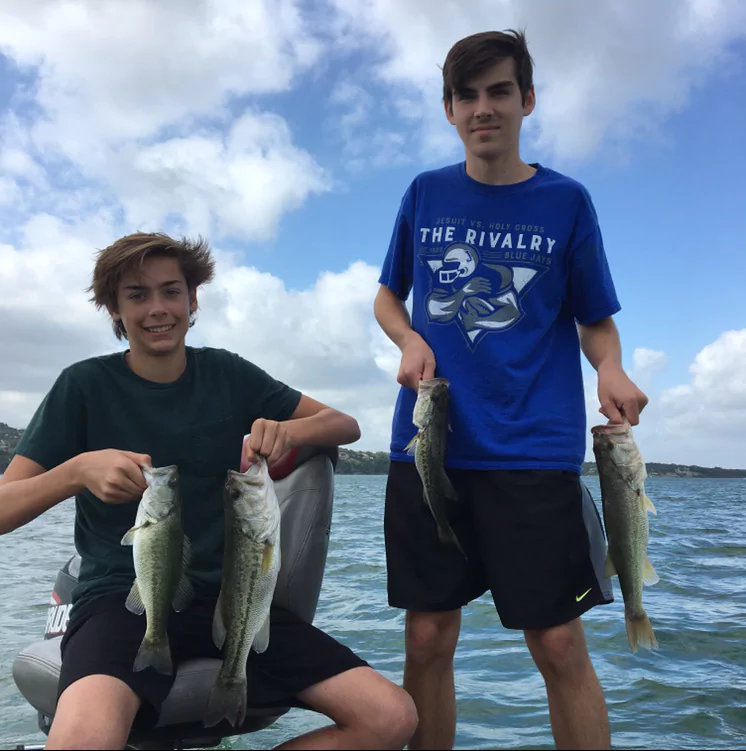
Related Links:
Lake Travis Lodging
Lake Travis Marinas
Best Lake Travis Boat Fuel Docks
Best Lake Travis Lakeside Restaurants
Best Lake Travis Parks
May 1, 2018
It’s May and the fishing is really strong on Lake Travis. We’ve experienced sporadic schooling the last few weeks with these fish targeting 1 inch shad. With the gin clear water it’s very important to match the the size of your bait to the shad. We’re also finding the lighter line has been producing a few more bites in the lakes aquarium like water. One morning produced back to back 6 pound bass on a windy point on a weighted fluke. We just happened to pull up on the right school of fish at the right time feeding. A few stripers up to 8 pounds have been showing up in the mix as well. Let’s not forget the night time crappie fishing. Fishing around the right lighted docks can result in good numbers of fish being put in the boat. If you have a chance go wet at line on Lake Travis! – Lee Benton – Fishing Guides Austin
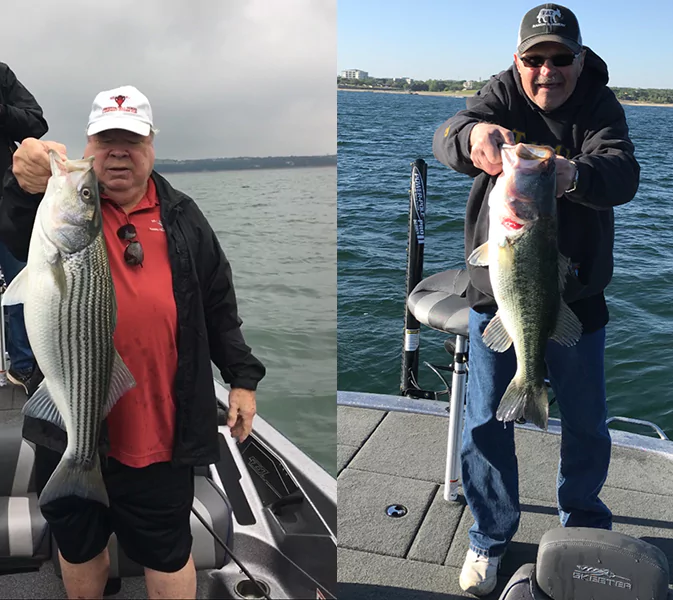
Related Links:
Lake Travis Lodging
Lake Travis Marinas
Best Lake Travis Boat Fuel Docks
Best Lake Travis Lakeside Restaurants
Best Lake Travis Parks
April 1, 2018
Lake Travis water temperatures climbing near 70 degrees mean the fish have made their move out of the depths to the clear flats and shallows of Lake Travis. Lake Travis has something most Texas lakes don’t have….extremely clear water. There are many areas on Lake Travis that you can see 25 ft down (to the bottom) and this really affects how fish are caught now and in the coming months.
A 1/16 oz weighted hook and a watermelon/red fluke has been producing great numbers and an occasional big bass on the lake. On days when we have some wind and cloud cover you can catch fish on moving baits like spinner baits and topwaters. On days with no clouds and no wind you have to really fish a little stealthier and slow down your presentation. On these days our best success has been on deeper flats and drops (the 15-25 ft depth) with a slow falling bait (fluke or senko). I believe this next full moon will push up the last wave of spawning fish.
A typical half day of fishing has been producing between 20-30 fish on average and should continue through the month of May. Pictured below is a young man that caught some good ones in a classic spawning creek on the lower end of the lake. Tight lines! – Lee Benton – Fishing Guides Austin
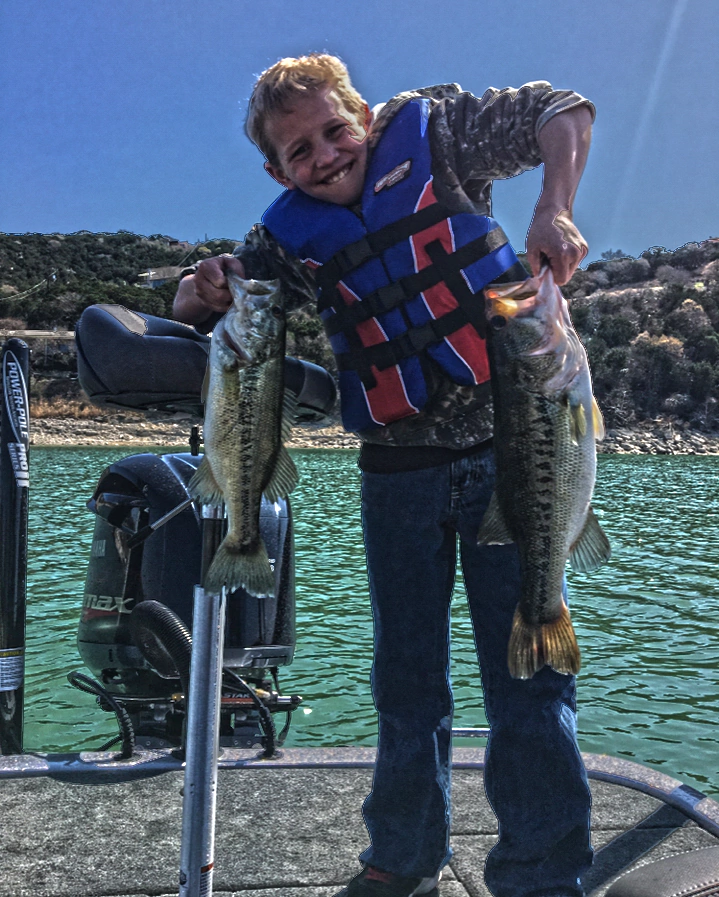
Related Links:
Lake Travis Lodging
Lake Travis Marinas
Best Lake Travis Boat Fuel Docks
Best Lake Travis Lakeside Restaurants
Best Lake Travis Parks
March 1, 2018
Spring is just around the corner and the fishing on Lake Travis is about to become prime. After an unusually cold winter, the fish are ready for a warm up! This time last year the lake was almost 7 degrees warmer and as you may know this plays a huge role in the fishing. We have been fishing ledges and drops in the 20-35ft depth and having to fish very SLOW… Without going in to great detail the heavy soft plastics, jigs, a-rigs, and slab spoons have been the go to baits this winter for most of us.
We are starting to see bass move to the shallows and this opens up a variety of ways to catch them. Wacky worms, craw pattern soft plastics, and shad/perch pattern baits will be go to baits for a good while. Let’s not forget about the white bass run that is taking place farther up lake (up river) and the crappie that will soon be showing up in the shallows and the marinas to spawn. The whites can still be caught in creeks on the main lake but there is a good number of them up river that can be caught a variety of ways including trolling. A good mess of white bass and crappie make for a great fish fry and table fair. Pictured below is a healthy Lake Travis bass caught on an a-rig on a deep ledge in February.